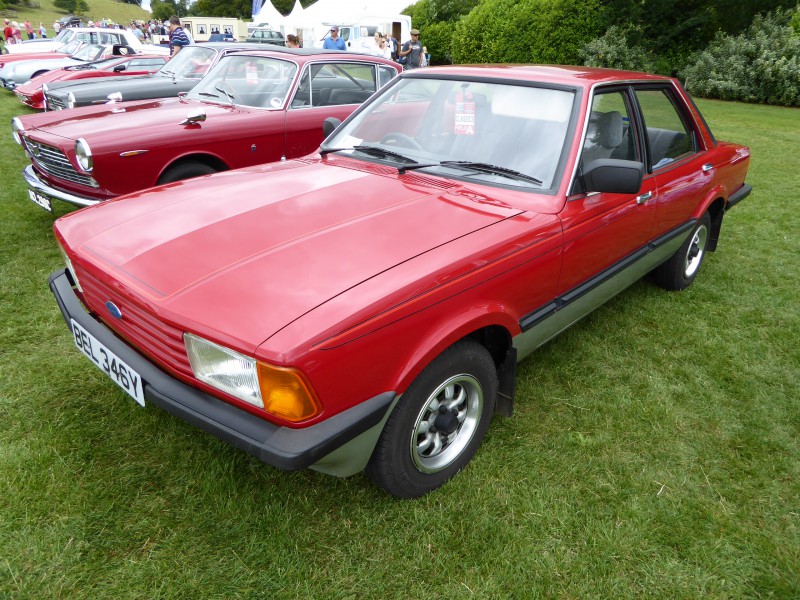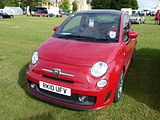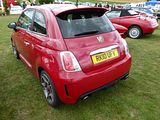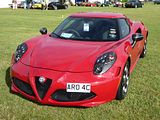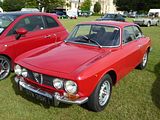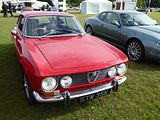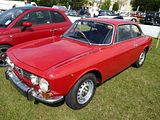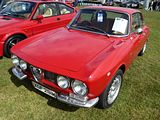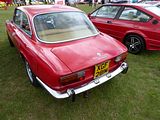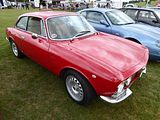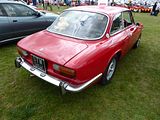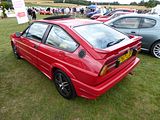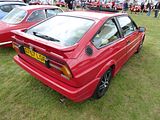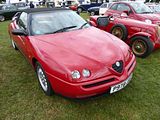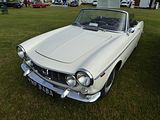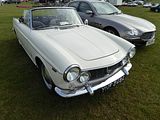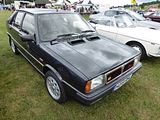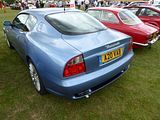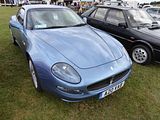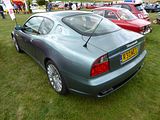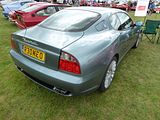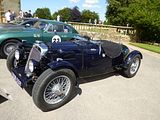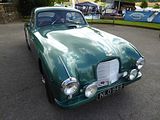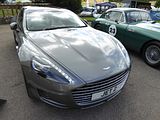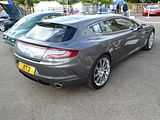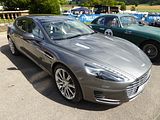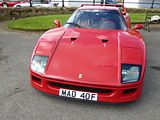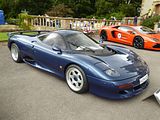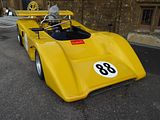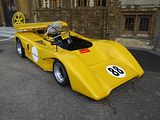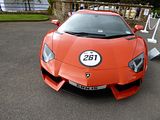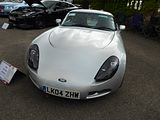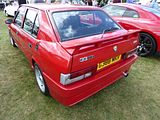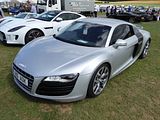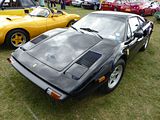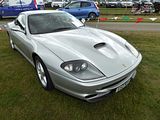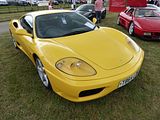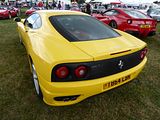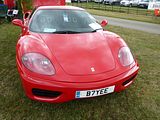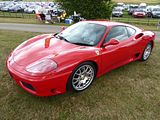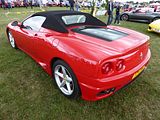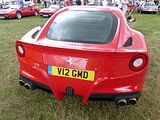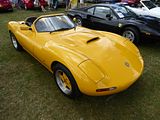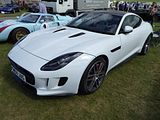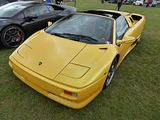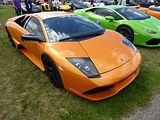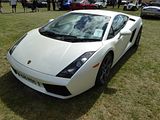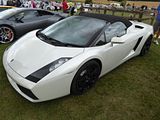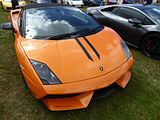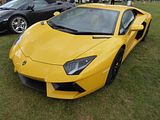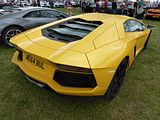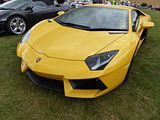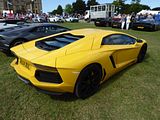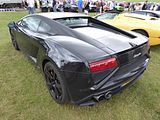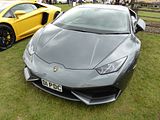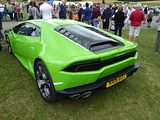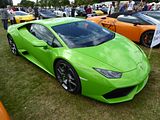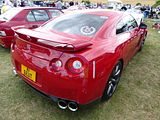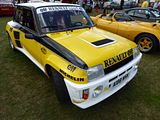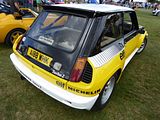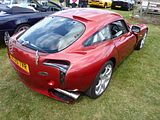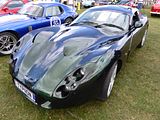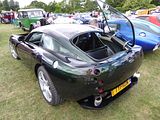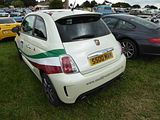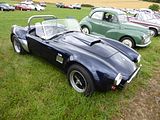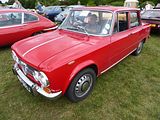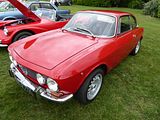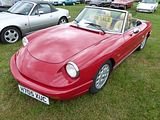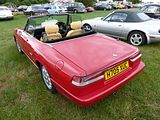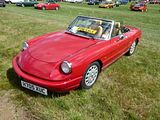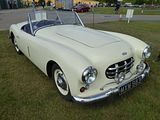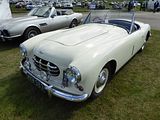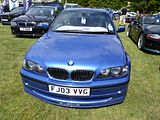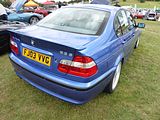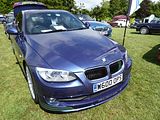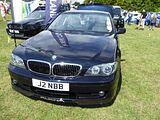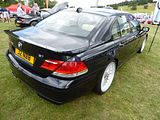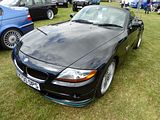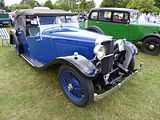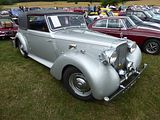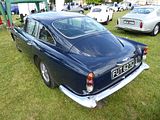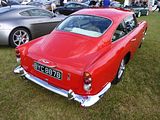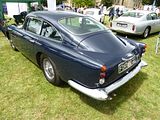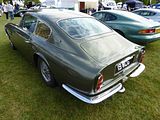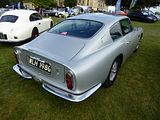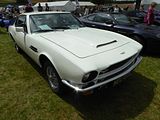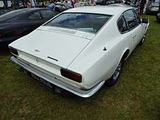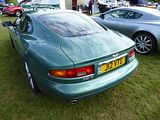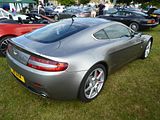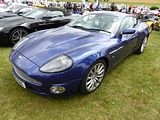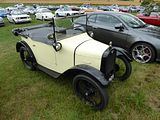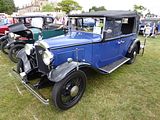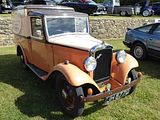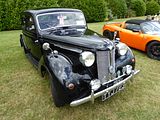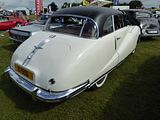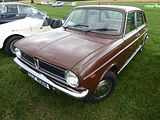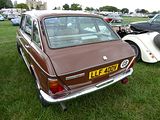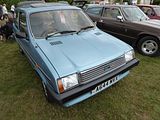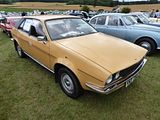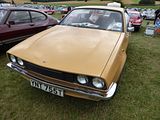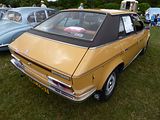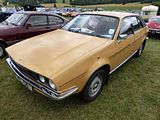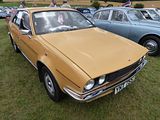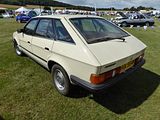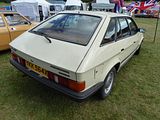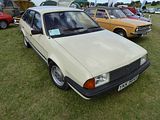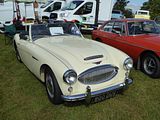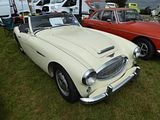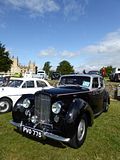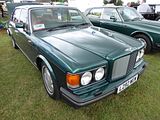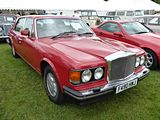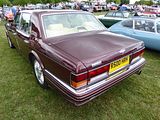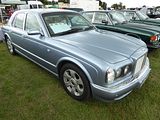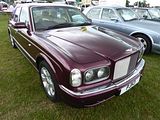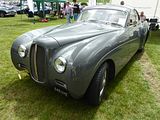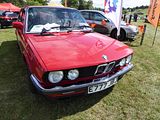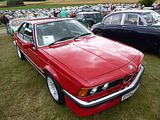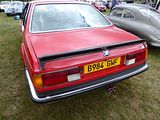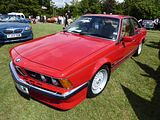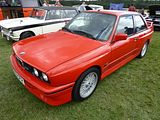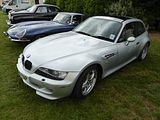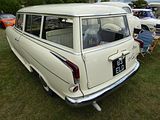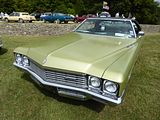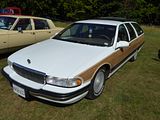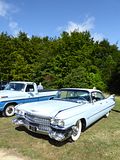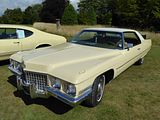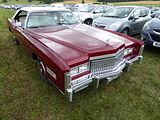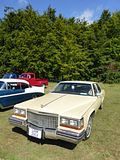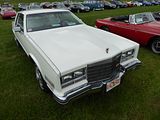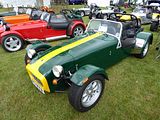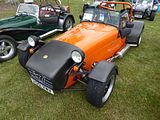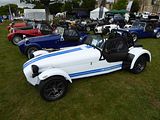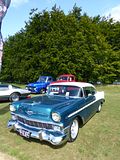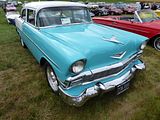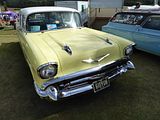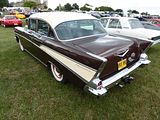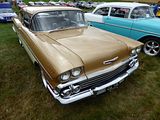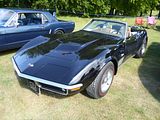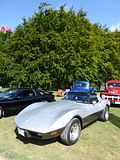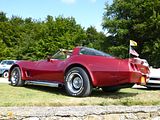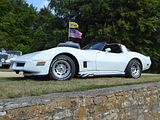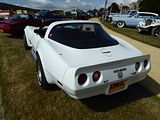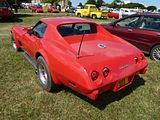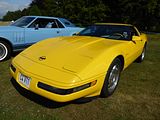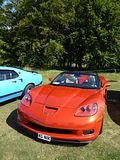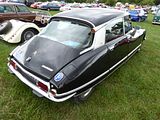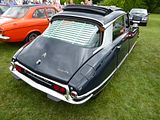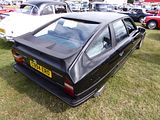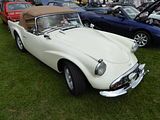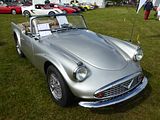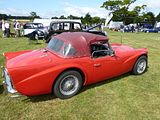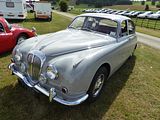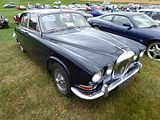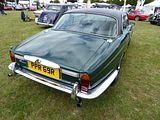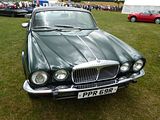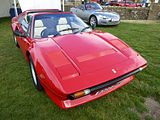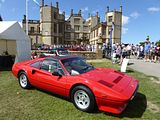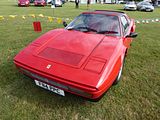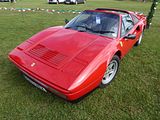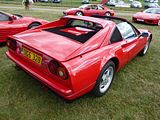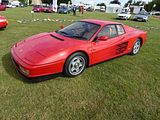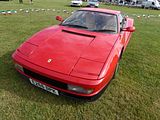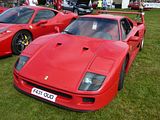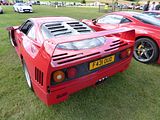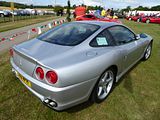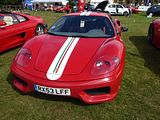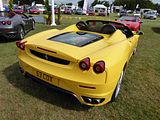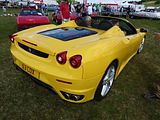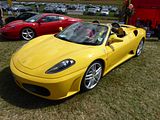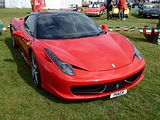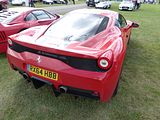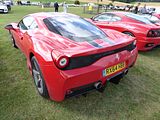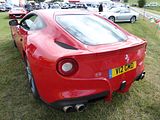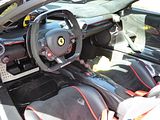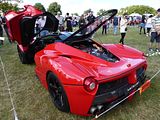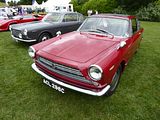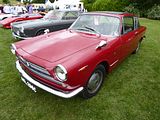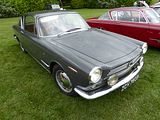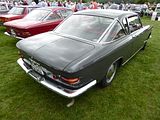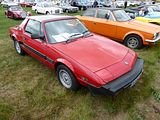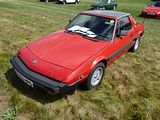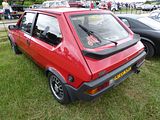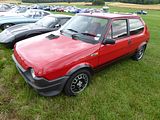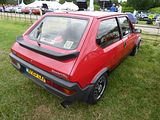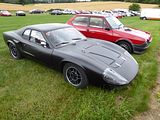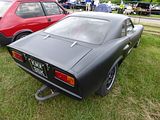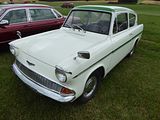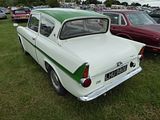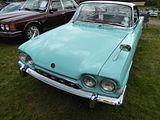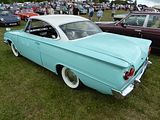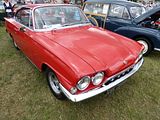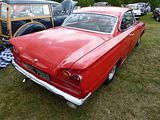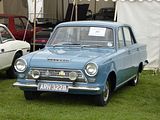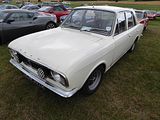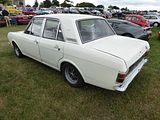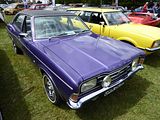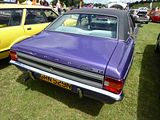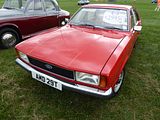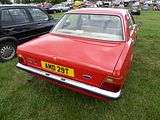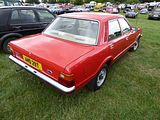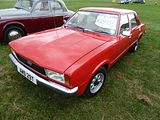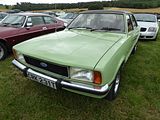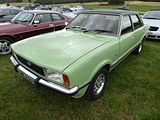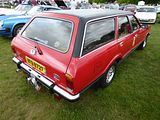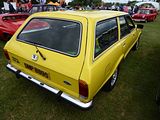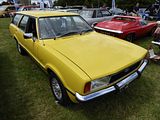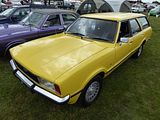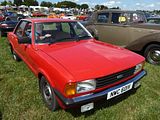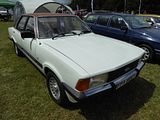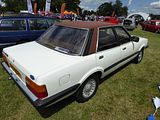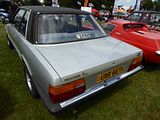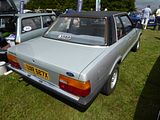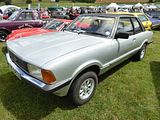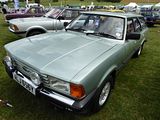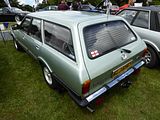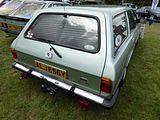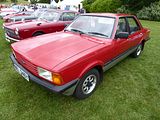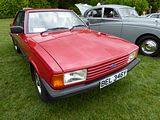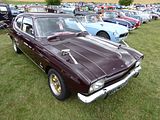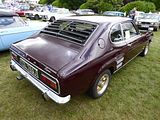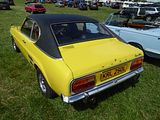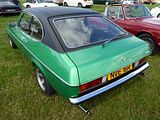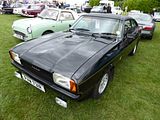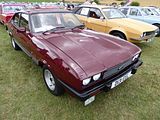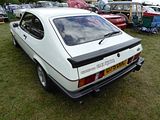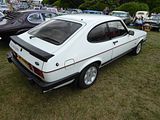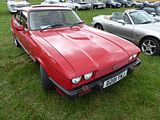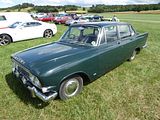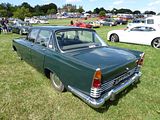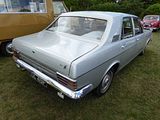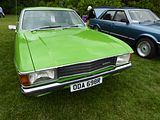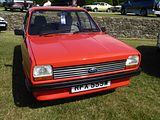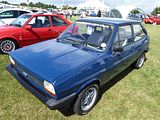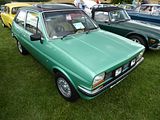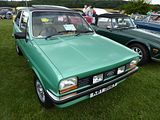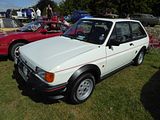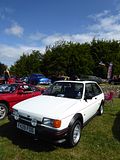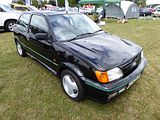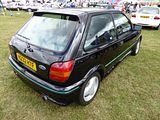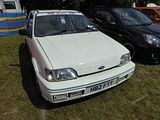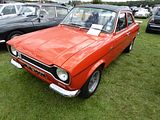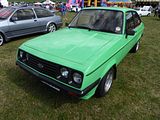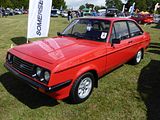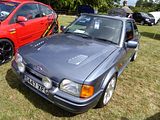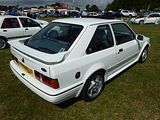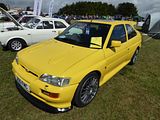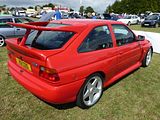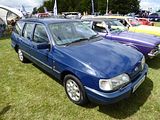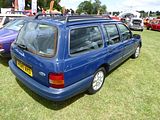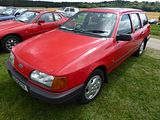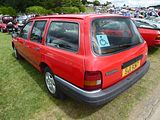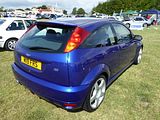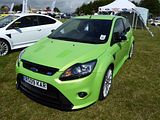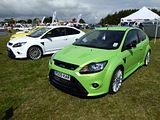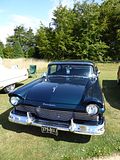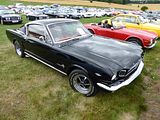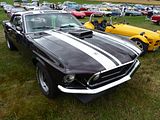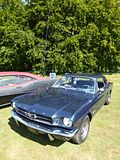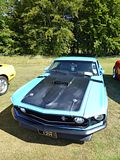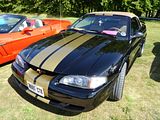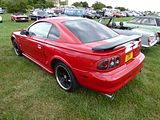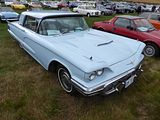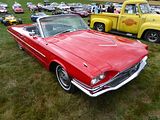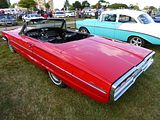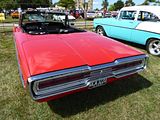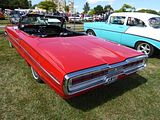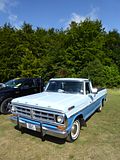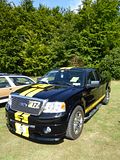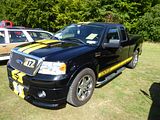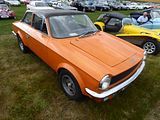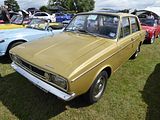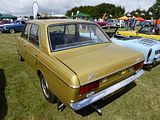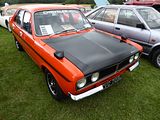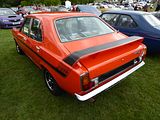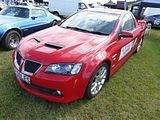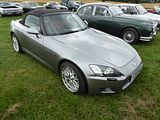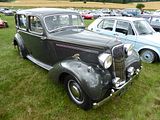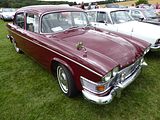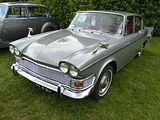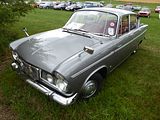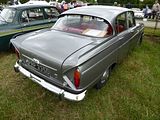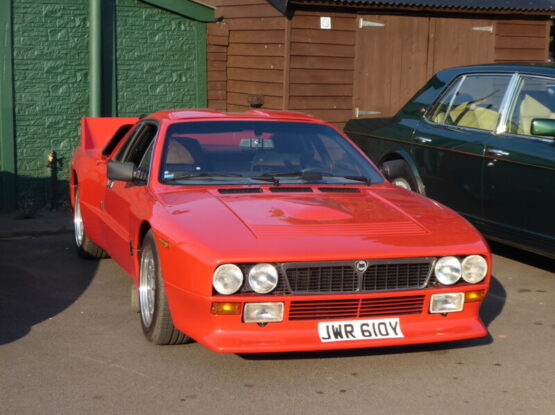I’ve attended this event a couple of times previously in its twelve year history, so I knew what to expect. Sherborne might be a small country town in Dorset, known – by what I would imagine is probably only a small percentage of the population – for its 16th Century Castle and its long established Public School, but for once a year, it absorbs a vast number of classic and supercars for the annual “Classics at the Castle” event. And make no mistake, people clearly do come in vast numbers, even though this is not the most accessible place on the events map, located quite a long way from the nearest motorway (the M5), or any major centre of population. The popularity of the event must stem from the reputation that has been built up over those dozen years, and the setting, in the grounds of the Castle surely help. Under new ownership since 2014, with a ‘not-for-profit’ organising company formed by ‘Yeo Vale’ and ‘Sherborne Castles’ Rotary Clubs, for 2015, the show was raising funds for Cancer Research UK and local charities. Support for the event comes not just from a large number of Car Clubs, but also several local dealers and a Supercar convoy which organised through the auspices of Pistonheads, as well as a sizeable number of classics that are spontaneously brought on the day by the public. In total there are over 1000 vehicles on display, so there’s easily a whole day’s entertainment here at what is a very relaxed and agreeable event. Here (rather belatedly!) are my highlights from the 2015 event.
ITALIAN AUTO MOTO CLUB DISPLAY
I’ve picked out one Club to start the report, for the very good reason that it was as a member of the Italian Auto Moto Club that I attended. Paul Hanmore communicated some weeks before the mid July date that he had booked a Club space and was looking for a varied assembly of Italian cars to populate the space. And varied is what we got, as the dozen cars that constituted the Club display were all different and covered the spectrum of all current marques bar one (which was extremely well represented in a pitch right next to this display).
Alphabetically first is my car, the much loved Abarth 500 which has featured prominently in reports here in the last 5 years since I bought it. These cars still attract plenty of attention wherever they are taking even though there are now a few thousand of them on our roads.
Another real attention grabber is the first of the Alfa models in the display, the Alfa Special belonging to David Roots. Hats off to David, as he frequently brings his car, which lacks any real form of weather protection, to events when many stay wrapped up at home, but today was a nice sunny day and the drive over from Frome would have been particularly enjoyable. I’ve written about this car several times, conveying a combination of its history – from information which David has typed up and presents on a laminated sheet which is displayed with his car – and something of its inspiration. I’d never really checked the detail of this last point, having formed my own conclusions based on what I knew of 1930s Alfas which David had always said were the inspiration behind this unique car that he created himself. It would seem that my assumptions were not quite correct, and I am happy to put the record straight. I had assumed that it was designed an homage to the 1935 8C Tipo C 35 Monoposto, a race car of which just 8 were built in 1935 and in which Tazio Nuvolari won the 1936 Coppa Ciano. But in fact, the real inspiration, and car of David’s dreams was the 8C2900. This was produced at around the same time in 1935, but to understand it, you have to go back a bit earlier in the 1930s to the equally desirable 8C2300. This was the first car with the now legendary 8 cylinder engine, developed by Vittorio Jano and which went on to score at least one victory in every major race and championship. In its initial 1931 configuration, the engine displaced 2336 cc, it grew gradually to 2905 cc, primarily by increasing the stroke. The engine was created by mounting two alloy blocks of four cylinders on a single crankcase. On top of the two blocks an alloy head was installed, housing two camshafts. Aspiration was forced, through two Roots-Type Superchargers. Although the engine increased in size throughout its career, its layout and auxiliaries remained very much similar to Jano’s 1931 design. One of the best known racing cars powered by the 8 cylinder engine was the Tipo B or P3 of 1932, which is to date considered as one of the finest Grand Prix racers ever constructed. Run by Enzo Ferrari’s Scuderia Ferrari, the Alfa Romeos were almost unbeatable. From its 1931 introduction, the 8C 2300 took four straight victories in the 24 Hours of Le Mans, driven by talented drivers like Tazio Nuvolari and Luigi Chinetti. Tazio Nuvolari’s brilliance was even more visible when driving the P3, the first single seater racer ever. The P3 was unbeaten in 1933, but eventually succumbed to defeat by the greater budgets being spent by Mercedes-Benz and Auto Union. With the rise of the German Grand Prix teams, Alfa Romeo focused more of its attention on sportscar and road racing. Designed specifically for Italy’s most legendary road race, the Mille Miglia, was the 8C 2900. Much like the contemporary Grand Prix racers, the 8C 2900 featured all-round independent suspension, with wishbones at the front and swing-axles at the rear. Installed in the chassis was a 220 bhp version of the 2905cc eight cylinder engine, which was created by mounting two four-cylinder alloy blocks on a single crankcase with twin Roots-type superchargers attached. The suspension was all-independent with wishbones in the front and the rear had swing-axles. A total of six of these road racers, later known as 8C 2900A, were constructed. Three of these were entered in the 1936 running of the Mille Miglia. The new cars were immediately successful and occupied the first three places at the finish with the Brivio and Ongaro driven 8C on top. A year the cars secured a second victory and the next two places. With the winning cars as a base, a road going customer version was constructed. Dubbed 8C 2900B, the road car featured a de-tuned engine, with 40 hp less, but other than that were very similar to the racer and even in this guise they were the fastest production vehicle in the world at the time. Two versions were available, the 2800 mm short wheelbase (Corto) and 3000 mm long wheelbase (Lungo) versions. Most of these were sent to Touring to be fitted with Berlinetta, Spyder and Roadster bodies. With its competition chassis and high top speed it was faster and quicker than anything its competition had to offer. Due to its high price, only a very few of these supercars were constructed, just 10 Lungo and 20 Corto chassis cars. Being very similar to the competition 8C 2900A, it came as no surprise the 8C 2900B was used as a racer as well. To suit this purpose Alfa Romeo constructed a further 13 8C 2900B chassis fitted with the 220 bhp engine. Many of these were fitted with roadster bodies and were entered in road races like the Mille Miglia. After the two 8C 2900A victories in 1936 and 1937, another two victories were scored by the 8C 2900B in 1938 and 1947. No other Alfa Romeo has scored as many Mille Miglia victories as the 8C 2900. Needless to say, on the rare occasions that one of these legends comes up for sale, there is an eight figure price tag, putting the car well out of reach of most of us. Like many of us, David dreamed of owning a car like the original, but unlike most of us, he did the next best thing to paying the millions and decided to create his own. The story starts back in 1989, somewhat deterred by the thought of the hours that could be spent lying underneath a rusty wreck at the side of the road, missing some obscure part that would need to be made specially, he decided to opt for a special combining retro styling with new bodywork and reasonably modern mechanics. A company called Classic Specials created that something, combining a bespoke chassis using MGB mechanics with a Lenham Healey bodyshell. Ten years later, in 1999, at the Castle Combe Classic Action Day he ‘blew’ the trusty B Series engine and that was the turning point which caused him to wonder if he could not actually design his own car. Many of us dream of doing this, but he actually decided to set about the task. Using the MG-Lenham chassis and Lenham Healey rear bodywork, the MG engine and gearbox were replaced with those from a 1969 Alfa Romeo 1750 GTV. Then a body had to be designed and constructed. This was done by making a buck from the aeroscreens forward, which was used to make a mould and moulding. Whilst it is not a precise rendering of the classic 8C2900, the result, he result which is variously described as an Alfa Special or a “Bitsarrini, looks very professional, and the car always generates lots of positive and appreciative comments whenever it is displayed. Today was no exception.
In complete contrast to that was an example of Alfa’s latest sporting model, the 4C Competizione. First seen as a concept at the 2011 Geneva Show, the production model did not debut for a further 2 years. Production got underway later that year at the Maserati plant in Modena, and the first deliveries were late in 2013. Production was originally pegged at 1000 cars a year and a total of just 3500, which encouraged many speculators to put their name down in the hope of making a sizeable profit on selling their cars on. That plan backfired, and in the early months, there were lots of cars for sale for greater than list price. Press reaction to the car has been mixed, with everyone loving the looks, but most of them feeling that the driving experience is not as they would want. Owners generally disagree – as is so often the case! – and most love their car. I know I would if I could find space (and funds!) for one in my garage!
There were a couple of 105 Series Coupe models here, both of them 2000 GTV cars, the top of the range version which was introduced in 1971, together with the 2000 Berlina sedan and 2000 Spider. The 2 litre cars were replacements for the 1750 range which had been offered since 1968, themselves an evolution of the original Bertone designed Giulia Sprint GT of 1973. The engine displacement was increased to 1962 cc with a change of the bore and stroke to 84 mm × 88.5 mm. Oil and radiator capacities remained unchanged. The North American market cars had fuel injection, but everyone else retained carburettors.Officially, both versions generated the same power, 130 hp at 5500 rpm. The interior trim was changed, with the most notable differences being the introduction of a separate instrument cluster, instead of the gauges installed in the dash panel in earlier cars. Externally the 2000 GTV is most easily distinguished by its grille with horizontal chrome bars, featuring protruding blocks forming the familiar Alfa heart in outline, smaller hubcaps with exposed wheel nuts, optional aluminium alloy wheels of the same size as the standard 5. 1/2J × 14 steel items, styled to the “turbina” design first seen on the alloy wheels of the Alfa Romeo Montreal, and the larger rear light clusters first fitted to United States market 1750 GTV’s were standard for all markets. From 1974 on, the 105 Series coupé models were rationalised and these external features became common to post-1974 GT 1300 Junior and GT 1600 Junior models, with only few distinguishing features marking the difference between models. 37,459 2000 GTVs were made before production ended and these days they are very sought after with prices having sky-rocketed in recent years.
In effect replacing the Junior versions of the 105 Series Coupe was the AlfaSud Sprint, a Coupe version of the AlfaSud, which took appeared 5 years after the launch of the ‘Sud saloon, being presented to the press in September 1976 in Baia Domizia and shown at the Turin Motor Show in November some five years after the launch of the saloon Designed by Giorgetto Giugiaro like the AlfaSud, whose mechanicals it was based on, it had a lower, more angular design, featuring a hatchback, although there were no folding rear seats. The AlfaSud Sprint was assembled together with the AlfaSud in the Pomigliano d’Arco plant, located in southern Italy—hence the original “Sud” moniker. Under the Alfasud Sprint’s bonnet there was a new version of the AlfaSud’s 1186 cc four-cylinder boxer engine, stroked to displace 1,286 cc, fed by a twin-choke carburettor and developing 75 hp at 6,000 rpm. Mated to the flat-four was a five-speed, all-synchromesh gearbox. The interior was upholstered in dark brown Texalfa leatherette and tartan cloth. Options were limited to alloy wheels, a quartz clock and metallic paint. In May 1978 the AlfaSud Sprint underwent its first updates, both cosmetic and technical. Engine choice was enlarged to two boxers, shared with the renewed AlfaSud ti, a 78 hp 1,350 cc and a 84 hp 1,490 cc; the earlier 1286 cc unit was not offered anymore, remaining exclusive to the AlfaSud. Outside many exterior details were changed from chrome to matte black stainless steel or plastic, such as the wing mirrors, window surrounds and C-pillar ornaments; the B-pillar also received a black finish, the side repeaters changed position and became square, and the front turn signals switched from white to amber lenses. In the cabin the seats had more pronounced bolsters and were upholstered in a new camel-coloured fabric. Just one year later, in June 1979, another engine update arrived and the AlfaSud Sprint became the AlfaSud Sprint Veloce. Thanks to double twin-choke carburettors (each choke feeding a single cylinder) and a higher compression ratio engine output increased to 85 hp and 94 hp, respectively for the 1.3 and 1.5. In February 1983 Alfa Romeo updated all of its sports cars; the Sprint received a major facelift. Thereafter the AlfaSud prefix and Veloce suffix were abandoned, and the car was known as Alfa Romeo Sprint; this also in view of the release of the Alfa Romeo 33, which a few months later replaced the AlfaSud family hatchback. The Sprint also received a platform upgrade, which was now the same as that of the Alfa Romeo 33; this entailed modified front suspension, brakes mounted in the wheels instead of inboard like on the AlfaSud, and drum brakes at the rear end. Three models made up the Sprint range: 1.3 and 1.5, with engines and performance unchanged from the AlfaSud Sprint Veloce, and the new 1.5 Quadrifoglio Verde—1.5 Cloverleaf in the UK. A multitude of changes were involved in the stylistic refresh; there were a new grille, headlamps, wing mirrors, window surrounds and C-pillar ornaments. Bumpers went from chrome to plastic, and large plastic protective strips were added to the body sides; both sported coloured piping, which was grey for 1.3 cars, red for the 1.5 and green for the 1.5 Quadrifoglio. At the rear new trapezoidal tail light assemblies were pieced together with the license plate holder by a black plastic fascia, topped by an Alfa Romeo badge—never present on the AlfaSud Sprint. In the cabin there were new seats with cloth seating surfaces and Texalfa backs, a new steering wheel and changes to elements of the dashboard and door panels. Sprint 1.3 and 1.5 came with steel wheels with black hubcaps from the AlfaSud ti. The newly introduced 1.5 Quadrifoglio Verde sport variant was shown at the March 1983 Geneva Motor Show. Its engine was the 1,490 cc boxer, revised to put out 104 hp at 6,000 rpm; front brake discs were vented and the gearing shorter. In addition to the green bumper piping, also specific to the Quadrifoglio were a green instead of chrome scudetto in the front grille, a rear spoiler and 8-hole grey painted alloy wheels with metric Michelin TRX 190/55 tyres. Inside a three-spoke leather-covered steering wheel, green carpets and sport seats in black cloth with green embroidery. In November 1987 the Sprint was updated for the last time; the 1.3 variant was carried over, while the 1.5 engine was phased out and the 1.5 QV was superseded by the 116 hp Sprint 1.7 Quadrifoglio Verde. The 1,286 cc engine was directly derived from the 33 1.7 Quadrifoglio Verde, and could propel the Sprint from 0 to 100 km/h in 9.3 seconds; to cope with the increased engine power, the 1.7 QV adopted vented brake discs upfront. the coloured piping and side plastic strips were deleted, and the Quadrifoglio had alloy wheels of a new design. A fuel injected and 3-way Catalytic converter-equipped 1.7 variant, with an engine again derived from a 33, was added later for dale on specific markets. There were a total of 116,552 Sprints produced during its lifespan, which lasted from 1976 to 1989. 15 of these formed the basis of the Australian-built Giocattolo sports car, which used a mid-mounted Holden 5.0 group A V8 engine. The Sprint had no direct predecessor or successor.
Final Alfa was a 916 Series Spider, one of a pair of cars that Alfa produced when they conceived replacements both for the Alfetta GTV and the much older 105 Series Spider. Initial work started in the late 1980s and the design task was handed to Pininfarina, with Enrico Fumia’s initial renderings produced in September 1987, and the first clay models to complete 1:1 scale model made in July 1988. Fumia produced something rather special. Clearly an Italian design, with the Alfa Romeo grille with dual round headlights, recalling the Audi-based Pininfarina Quartz, another design produced by Enrico Fumia back in 1981, the proposal was for a car that was low-slung, wedge-shaped with a low nose and high kicked up tail. The back of the car is “cut-off” with a “Kamm tail” giving improved aerodynamics. The Spider would share these traits with the GTV except that the rear is rounded, and would feature a folding soft-top with five hoop frame, which would completely disappear from sight under a flush fitting cover. An electric folding mechanism would be fitted as an option. Details included a one-piece rear lamp/foglamp/indicator strip across the rear of the body, the minor instruments in the centre console angled towards the driver. The exterior design was finished in July 1988. After Vittorio Ghidella, Fiat’s CEO, accepted the design, Alfa Romeo Centro Stile under Walter de Silva was made responsible for the completion of the detail work and also for the design of the interiors, as Pininfarina’s proposal was not accepted. The Spider and GTV were to be based on the then-current Fiat Group platform, called Tipo Due, in this case a heavily modified version with an all new multilink rear suspension. The front suspension and drivetrain was based on the 1992 Alfa Romeo 155 saloon. Chief engineer at that time was Bruno Cena. Drag coefficient was 0.33 for the GTV and 0.38 for the Spider. Production began in late 1993 with four cars, all 3.0 V6 Spiders, assembled at the Alfa Romeo Arese Plant in Milan. In early 1994 the first GTV was produced, with 2.0 Twin Spark engine. The first premiere was then held at the Paris Motor Show in 1994. The GTV and Spider were officially launched at the Geneva Motor Show in March 1995 and sales began the same year. The cars were well received. At launch, many journalists commented that Alfa had improved overall build quality considerably and that it came very close to equalling its German rivals. I can vouch for that, as I owned an early GTV for eighteen months, and it was a well built and reliable car. In 1997 a new engine, a 24-valve 3.0 litre V6, was available for the GTV along with bigger, 12.0 inch brakes and red four-pot calipers from Brembo. The console knobs were changed from round central to rectangle ones and to a three-spoke steering wheel. Some versions were upgraded with different front bumper mesh to bring the wind noise down to 74 dBA. In May 1998 the cars were revamped for the first time, creating the Phase 2 models. Most of the alterations were inside. The interior was changed with new centre console, painted letters on skirt seals, changed controls and switches arrangement and different instrument cluster. Outside, the main changes included chrome frame around the grille and colour-coded side skirts and bumpers. A new engine was introduced, the 142 hp 1.8 Twin Spark, and others were changed: the 2.0 Twin Spark was updated with a modular intake manifold with different length intakes and a different plastic cover. Power output of the 2.0 TS was raised to 153 hp. Engines changed engine management units and have a nomenclature of CF2. The dashboard was available in two new colours in addition to the standard black: Red Style and Blue Style, and with it new colour-coded upholstery and carpets. The 3.0 24V got a six-speed manual gearbox as standard and the 2.0 V6 TB engine was now also available for the Spider. August 2000 saw the revamp of engines to comply with new emission regulations, Euro3. The new engines were slightly detuned, and have a new identification code: CF3. 3.0 V6 12V was discontinued for the Spider and replaced with 24V Euro3 version from the GTV. 2.0 V6 Turbo and 1.8 T.Spark were discontinued as they did not comply with Euro3 emissions. By the 2001-2002 model year, only 2 engines were left, the 2.0 Twin.Spark and 3.0 V6 24V, until the Phase 3 engine range arrived. The Arese plant, where the cars had been built, was closing and, in October 2000, the production of GTV/Spider was transferred to Pininfarina Plant in San Giorgio Canavese in Turin. In 2003 there was another and final revamp, creating the Phase 3, also designed in Pininfarina but not by Enrico Fumia. The main changes were focused on the front with new 147-style grille and different front bumpers with offset numberplate holder. Change to the interior was minimal with different centre console and upholstery pattern and colours available. Instrument illumination colour was changed from green to red. Main specification change is an ASR traction control, not available for 2.0 TS Base model. New engines were introduced: 163 hp 2.0 JTS with direct petrol injection and 237 hp 3.2 V6 24V allowing a 158 mph top speed. Production ceased in late 2004, though some cars were still available for purchase till 2006. A number of limited edition cars were produced during the model’s lifetime, of which the Cup, produced in 2001, is perhaps the best known. Based on the 3.0 V6 version, and inspired by a one-model Alfa GTV Cup race series, 419 of these cars were made. There were 180 3.0 V6 24V GTV Cups, out of which 155 RHD versions and 239 cars with 150 PS 2.0 TS were available in LHD only. 3.0 V6 cars were only produced in red ,while 2.0 TS cars were mostly silver with a few examples in red. Limited edition plaques, that were made of silver, differed for the RHD and LHD versions, having red and black texts accordingly. The differences between the standard car and the Cup version were a factory standard rear spoiler, front spoiler, side skirts, wheel arch side vents and titanium-like finish 17″ ‘telephone dial’ alloys, whilst mechanically the car was the same as the regular 215 hp V6. The interior was different in that had leather-material upholstery.
Possibly the least well known of the cars in this display was the Fiat 1600S Cabrio belonging to Mike Lamplough. I first saw this car at the BIAMF in Bristol earlier in the year, which was not long after Mike had acquired the car, where it drew notable comment and adulation, so it was great to see it again, especially as it is believed to be the only example in the UK. , Similar in outline to the 1500 Cabriolet models on which it is based as well as the earlier 1200TV, a few of which are in the UK, the 1600 sports an OSCA engined twin cam of 1,568 cc, which develops 90 PS. It was available at the same time as the 1500 Cabriolet, which was from 1961 to 1966, and can easily be distinguished from the 1500 model by its additional lamps at the outer corners of the grille. Mike has owned this car since late 2014. The car was first sold to a buyer in Italy, but then was moved to the US where it lived until 1996, at which point it returned to Italy. When he bought it, and got to see what he had actually paid out money for, he was delighted to find that this was a very solid car indeed, needing very little work done to it, though it has been treated to new leather seats, replacing the original vinyl items. To my eyes, the simple Pininfarina styled lines of this car are just about perfect from every angle.
Although the Integrale versions of the Lancia Delta only ever achieved a small number of sales relative to the less potent models in the range, these are the ones that everyone thinks of and that you tend to see these days, so it was nice to see one of those other models here, an HF Turbo. The car that would become the Delta during its development went by the project codename Y 5, and it was conceived as an upmarket front-wheel drive small family car positioned below the larger Beta; an offering around four metres in length had been absent from Lancia’s lineup since the demise of the Fulvia Berlina in 1973. Design was by Giorgetto Giugiaro’s Italdesign. Its platform put together MacPherson suspension developed for the Beta with four-cylinder, SOHC engines derived from the Fiat Ritmo. The Fiat engines were revised by Lancia engineers with a Weber twin-choke carburettor, a new inlet manifold, exhaust system and ignition. To achieve its market positioning the Delta offered features uncommon in the segment, as fully independent suspension, air conditioning, optional split-folding rear seat, adjustable steering wheel, and three-piece body-coloured bumpers made from polyester resin sheet moulding compound, which Lancia claimed were a first in the industry. The Delta was unveiled to the public at the September 1979 Frankfurt Motor Show, At launch three models were offered: the base Delta 1300 4-speed, with a 1301 cc 75 PS engine and simplified equipment, Delta 1300 5-speed, which added more features and an overdrive fifth gear for cruising, and Delta 1500, with a 1498 cc 85 PS engine and a 5-speed gearbox. The Delta was met with a warm reception at the Frankfurt unveiling by the Italian press and in December it was awarded the Car of the Year 1980 recognition by a jury of 53 automotive journalists from 16 European countries. Sales started in October 1979; 43,000 were sold in 1980, and by the end of 1981 production had exceeded 100,000. At the beginning of 1982 as an automatic transmission option was added, the 1500 Automatica; its 3-speed was built by Lancia in the Verrone plant and was already being installed on Betas. In March the top-of-the-line 1500 LX trim level joined the lineup; it featured extended convenience equipment, metallic paint, 14-inch alloy wheels penned by Giugiaro and wool cloth upholstery in a chequered fabric specially designed by Italian fashion house Zegna. Two months after the trim level was extended to the 1.3-litre engine too, which simultaneously increased its output to 78 PS thanks to a raised compression ratio and electronic ignition. November 1982 brought the first facelift. The bumpers were changed from three-piece sheet moulded compound to one-piece thermoplastic polymer, the front one was redesigned with a more prominent lower spoiler; another aerodynamic addition was a flat body-colour spoiler applied to the rear part of the roof. Other changes included the deletion of the anodised fascia between the rear tail lights and a 40 kg weight reduction on all models. Inside there were new seats and, on the range topping models, an optional digital trip computer. Concurrently the Delta GT 1600 was launched, the car’s first sporting variant. It was powered by a 1585 cc, 105 PS twin-cam engine with Marelli Digiplex ignition; lower profile tyres, retuned suspensions and disk brakes on all four wheels completed the package. Standard equipment was the richest available and some optionals like air conditioning were exclusive to the GT; the cabin was upholstered in Zegna cloth. Outside details like a “GT” badge on the right side of the grille and matte black door handles and window trim distinguished it from other Deltas. As the 5-speed 1500, 4-speed 1300 an LX versions were dropped—the latter only to be reintroduced in April 1984 on the 1300 LX, with revised equipment—the range was now composed of three models. On 9 March 1984 the 200,000th Delta left the Chivasso factory. The first performance Delta was the Delta HF, which was introduced in July 1983 and went on sale in September after a first appearance at the Frankfurt Motor Show. The HF acronym—last used on the Stratos—stood for “High Fidelity”, and had been used on performance version of Lancia cars since the 1960s. It was front-wheel drive and powered by a turbocharged version of the 1.6-litre engine from the Delta GT; the system used a Garrett T3 turbocharger with wastegate valve, an air-to-air heat exchanger, a blow-through twin-choke Weber carburettor and Marelli Microplex ignition with pre-ignition control. To withstand the additional stress deriving from turbocharging upgrades were made to the oil system, with increased capacity and an oil cooler, and to the heads with sodium-filled valves. The gearbox was a ZF 5-speed unit. Dampers, springs and steering were retuned, and the tyres were wide 175/65 Michelin TRX on R 340 alloy wheels. In true Lancia tradition the exterior of the HF was relatively understated: changes were limited to silver “HF” badging on the grille, a deeper chin spoiler, black trim, new unpainted side skirts with small silver “turbo” badges in front of the rear wheels, the ’82 roof spoiler painted in black, air intake cowls on the bonnet grilles, bronze-tinted athermic glass and 8-spoke alloy wheels. The cabin featured a leather-covered steering wheel and supplementary digital instrumentation with bar indicators; the upholstery material was the usual Zegna fabric and Recaro sport seats in the same cloth were optional. About ten thousand Delta HF were made, in a two-year production period. A special limited edition of the HF, named HF Martini, was launched at the March 1984 Geneva Motor Show. To celebrate the rally victories of the Lancia-Martini Rally 037 it was painted white with a Martini stripe on the side; Recaro seats were standard. In October 1985 Lancia unveiled alongside the road-going Delta S4 a new version of the HF, renamed Delta HF Turbo. To address some criticisms the car was given less subdued styling features and more generous equipment to differentiate it from the other Deltas; namely red “HF turbo” script on the grille, the side skirts and the rear hatch, a three-spoke sport steering wheel, dual wing mirrors, a two-colour pinstripe along the mid-bodyside character line and Pirelli P6 tyres on 14-inch Cromodora alloy wheels with a new 8-hole design. Price, technical specifications and performance remained mostly unchanged. When the more powerful, four-wheel-drive HF models were introduced in the later years the HF turbo remained on sale alongside them.
After close on two decades of producing what turned out to be a complex range of BiTurbo based cars, Maserati came up with a completely new model in July 1998. Known internally as the Tipo 338, and christened the Maserati 3200 GT, this very elegant 2+2 grand tourer was styled by Italdesign, whose founder and head Giorgetto Giugiaro had previously designed, among others, the Ghibli, Bora and Merak. The interior design was commissioned to Enrico Fumia. Its name honoured the Maserati 3500 GT, the Trident’s first series production grand tourer. Sold mainly in Europe, the 3200 GT was powered by the twin-turbo, 32-valve, dual overhead cam 3.2-litre V8 engine featured in the Quattroporte Evoluzione, set up to develop 370 PS (365 hp). The car was praised for its styling, with the distinctive array of tail-lights, consisting of LEDs, arranged in the shape of boomerang being particularly worthy of comment. The outer layer of the ‘boomerang’ provided the brake light, with the inner layer providing the directional indicator. The car was also reviewed quite well by the press when they got to drive it in early 1999, though it was clear that they expected more power and excitement. That came after 4,795 cars had been produced, in 2001, with the launch of the 4200 models. Officially called the Coupé and joined by an open-topped Spyder (Tipo M138 in Maserati speak), these models had larger 4.2 litre engines and had been engineered so the cars could be sold in America, marking the return to that market for Maserati after an 11 year gap. There were some detailed styling changes, most notable of which were the replacement of the boomerang rear lights with conventional rectangular units. Few felt that this was an improvement. The cars proved popular, though, selling strongly up until 2007 when they were replaced by the next generation of Maserati. Minor changes were made to the model during its six year production, but more significant was the launch at the 2004 Geneva Show of the GranSport which sported aerodynamic body cladding, a chrome mesh grille, carbon fibre interior trim, and special 19-inch wheels. It used the Skyhook active suspension, with a 0.4 inch lower ride height, and the Cambiocorsa transmission recalibrated for quicker shifts. The exhaust was specially tuned to “growl” on start-up and full throttle. The GranSport was powered by the same 4244 cc, 90° V8 petrol engine used on the Coupé and Spyder, but developing 400 PS (395 hp) at 7000 rpm due primarily to a different exhaust system and improvements on the intake manifolds and valve seats. A six-speed paddle shift transmission came as standard. The GranSport has a claimed top speed of 180 mph (290 km/h) and a 0–62 mph (0–100 km/h) time of 4.8 seconds. There were two examples of the later 4200GT here, one of them belonging to the Italian Auto Moto Club’s Chairman, Paul Hanmore.
Final car in this display section was an example of the fifth generation Maserati Quattroporte, that most elegant saloon. Around 25,000 of these cars were made between 2004 and 2012, making it the second best selling Maserati of all time, beaten only by the cheaper BiTurbo of the 1980s. The Tipo M139 was unveiled to the world at the Frankfurt Motor Show on 9 September 2003, with production starting in 2004. Exterior and interior design was done by Pininfarina, and the result was widely acclaimed to be one of the best looking saloons not just of its time, but ever, an opinion many would not disagree with even now. Built on an entirely new platform, it was 50 cm (19.7 in) longer than its predecessor and sat on a 40 cm (15.7 in) longer wheelbase. The same architecture would later underpin the GranTurismo and GranCabrio coupés and convertibles. Initially it was powered by an evolution of the naturally aspirated dry sump 4.2-litre V8 engine, mounted on the Maserati Coupé, with an improved output of 400 PS . Due to its greater weight compared to the Coupé and Spyder, the 0-62 mph (0–100 km/h) time for the Quattroporte was 5.2 seconds and the top speed 171 mph (275 km/h). Iinitially offered in only one configuration, equipped with the DuoSelect transmission, the gearbox was the weak point of the car, receiving most of the criticism from the press reviews. Maserati increased the range at the 2005 Frankfurt Motor Show, with the launch of the Executive GT and Sport GT trim levels. The Executive GT came equipped with a wood-rimmed steering wheel, an alcantara suede interior roof lining, ventilated, adaptive, massaging rear seats, rear air conditioning controls, veneered retractable rear tables, and curtain shades on the rear windows. The exterior was distinguished by 19 inch eight-spoke ball-polished wheels and chrome mesh front and side grilles. The Quattroporte Sport GT variant offered several performance upgrades: faster shifting transmission and firmer Skyhook suspensions thanks to new software calibrations, seven-spoke 20 inch wheels with low-profile tyres, cross-drilled brake rotors and braided brake lines. Model-specific exterior trim included dark mesh front and side grilles and red accents to the Trident badges, as on vintage racing Maseratis. Inside there were aluminium pedals, a sport steering wheel and carbon fibre in place of the standard wood inserts. A new automatic transmission was presented at the 2007 Detroit Motor Show, marketed as the Maserati Quattroporte Automatica. As all three trim levels were offered in both DuoSelect and Automatica versions, the lineup grew to six models. The Quattroporte Sport GT S was introduced at the 2007 Frankfurt Motor Show. Taking further the Sport GT’s focus on handling, this version employed Bilstein single-rate dampers in place of the Skyhook adaptive system. Other changes from the Sport GT comprised a lowered ride height and 10 mm wider 295/30 rear tyres, front Brembo iron/aluminium dual-cast brake rotors and red-painted six piston callipers. The cabin was upholstered in mixed alcantara and leather, with carbon fibre accents; outside the door handles were painted in body colour, while the exterior trim, the 20 inch wheels and the exhaust pipes were finished in a “dark chrome” shade. After Images of a facelifted Quattroporte appeared on the Internet in January 2008; the car made its official début at the 2008 Geneva Motor Show. Overseen by Pininfarina, the facelift brought redesigned bumpers, side sills and side mirrors, a convex front grille with vertical bars instead of horizontal, new headlights and tail lights with directional bi-xenon main beams and LED turn signals. Inside there was a new navigation and entertainment system. All Quattroporte models now used the ZF automatic transmission, the DuoSelect being discontinued. The 4.2-litre Quattroporte now came equipped with single-rate damping comfort-tuned suspension and 18 inch wheels. Debuting alongside it was the Quattroporte S, powered by a wet-sump 4.7-litre V8, the same engine of the Maserati GranTurismo S, with a maximum power of 430 PS (424 hp) and maximum torque of 490 N·m (361 lb·ft). In conjunction with the engine, the braking system was upgraded to cross-drilled discs on both axles and dual-cast 360 mm rotors with six piston callipers at the front. Skyhook active damping suspension and 19 inch V-spoke wheels were standard. Trim differences from the 4.2-litre cars were limited to a chrome instead of titanium-coloured front grille. The Quattroporte Sport GT S was premièred at the North American International Auto Show in January 2009. Its 4.7-litre V8 produced 440 PS (434 hp), ten more than the Quattroporte S, thanks to revised intake and to a sport exhaust system with electronically actuated bypass valves. Other mechanical changes were to the suspensions, where as on the first Sport GT S single-rate dampers took place of the Skyhook system, ride height was further lowered and stiffer springs were adopted. The exterior was distinguished by a specific front grille with convex vertical bars, black headlight bezels, red accents to the Trident badges, the absence of chrome window trim, body colour door handles and black double oval exhaust pipes instead of the four round ones found on other Quattroporte models. Inside veneers were replaced by “Titan Tex” composite material and the cabin was upholstered in mixed Alcantara and leather. This means that there are quite a number of different versions among the 25,256 units produced, with the early DuoSelect cars being the most numerous.
SUPERCAR DISPLAY
An assembly of Supercars were presented in the area in front of the main entrance to the Castle, and these remained there all day.
Fresh out of the box, so to speak, was the Ariel Nomad, launched only a few weeks ago.
Oldest of a number of rather lovely Aston Martin models in this part of the show was this late 1930s 2 litre 15/98.
Seen alongside it was an Aston Martin DB2, the first new post-war Aston, and the first car to adopt the now legendary DB naming convention, reflecting the fact that in 1947 David Brown had bought the Aston Martin and Lagonda companies and incorporated them as Aston Martin Lagonda Ltd. Lagonda’s 2.6 litre dual overhead cam, straight-six engine, more powerful than the pushrod 1.9 litre unit in the Aston Martin 2-Litre Sports, was the main objective in Brown’s acquisition of the company. W. O. Bentley had supervised the engine’s design, which was largely by William (Willie) Watson, an engineer with the pre-war Invicta company who had collaborated on Lagonda’s pre-war V12 and also designed the short-lived post-war version. Work then started on producing a new car, which was called the DB2. This new model would utilise a version of the Lagonda engine in a shortened version of the tube-frame chassis designed by Claude Hill for the Aston Martin 2-Litre Sports, with a fastback coupé body designed by Frank Feeley. Three pre-production cars were entered for the 1949 24 Hours of Le Mans. One, which would become the development car for the production DB2, had the Lagonda straight-6, while the four-cylinder Aston Martin 2-litre unit powered the other two. After six laps the Lagonda-powered car, driven by Leslie Johnson, retired with overheating caused by failure of the water pump. One of the 2-litre cars was in 4th place and running without brakes when it crashed two hours short of the finish, fatally injuring driver Pierre Maréchal. The other finished 7th, crewed by Arthur Jones and Nick Haines. A month later, the larger-engined car, driven by Leslie Johnson and Charles Brackenbury, finished 3rd in the Spa 24-hour race, where one of the 2-litre cars was driven to 5th by Nick Haines and Lance Macklin. For 1950 all three factory team cars were equipped with the Lagonda engine. At the 1950 Le Mans race the one driven by George Abecassis and Lance Macklin finished 5th, with Brackenbury and Reg Parnell bringing another home 6th, which won Aston Martin 1st and 2nd in the 3-litre class. Across the Atlantic, Briggs Cunningham drove his DB2 to 2nd in its class at the inaugural Sebring race meeting in December 1950. The factory team cars continued racing in Europe throughout 1951, including at Le Mans, where Macklin and Eric Thompson took 3rd overall, with Abecassis and Brian Shawe-Taylor 5th. David Brown soon embarked on a series of Aston Martins designed specifically for competition use, starting with the DB3. Meanwhile, the production DB2 debuted at the New York Auto Show in April 1950 and continued in production until April 1953, by which time 411 had been made. The first 49 had a chrome-framed front grille in three separate parts, and large rectangular cooling vents in the front wings. Subsequent cars had a one-piece grille with horizontal chrome slats, and no side vents. The single-piece bonnet was hinged at the front. At the rear of the fixed-head coupé (FHC) a small top-hinged lid gave access to the spare wheel, and luggage space was behind the front seats, accessible only from inside the car. Later in 1950, a Drophead Coupé (DHC) variant was introduced. At least 102 were built. In April 1950, an engine with larger carburettors, inlet camshaft the same as the exhaust (for increased duration), and higher compression ratio pistons (8.16:1) was made available. Aston Martin’s first Vantage upgrade option offered 125 hp. Initially the higher compression ratio made the engine unsuitable for the British market, as the postwar austerity measures of the early 1950s restricted UK vehicles to 72 octane “Pool petrol”. The first DB2 Vantage, LML 50/21, was delivered to, and raced by, Briggs Cunningham in the United States. A revised version of the DB2 was launched in 1953, called the DB2/4. It was available as a 2+2 hatchback, marketed as a Saloon, as a Drophead Coupé (DHC) and as a 2-seat Fixed Head Coupe. A small number of Bertone bodied spiders were commissioned by private buyers. A further update in 1957 created the Mark III, and this was produced until the launch of the DB4 in 1958.
First seen at the 2013 Geneva Motor Show, the Rapide based Bertone Jet 2+2 was created to celebrate both the centenary of Aston Martin and also the 60th anniversary of the first collaboration between Aston Martin and Bertone with the DB2/4 Spider. This unique shooting-brake was commissioned by the private British Aston Martin enthusiast and collector, Barry Weir, who took part in the whole development of the project, from the first phases of the styling to the manufacture of the car in the workshop. The project has also had the complete approval from AML in Gaydon who were more than happy to supply the base car. The Jet 2+2 was manufactured by “Bertone Officina” (Bertone Workshop), a new company department organised as a high fashion atelier, especially created for the production of custom-built models in the historical tradition of Bertone. It rather neatly follows on from the 2004 Bertone Jet 2, a two door shooting brake based on the V12 Vanquish. Bertone Officina offers a “tailor made” service for special customers, but also offers an example of how Bertone could help other manufacturers to vary their own range making custom-built concept cars, exactly as they did in the Fifties and Sixties. The front grille appears to be identical to that of the Rapide S although the Jet 2+2 was actually based on a regular Rapide with the 470 bhp 5.9 litre V12. It retains the same wheelbase as the donor car as well as the same overall dimensions. The shooting-brake styling makes the muscular yet elegant Jet 2+2 somewhere between an estate and a coupé.
Representing Ferrari in this part of the event was an F40, the car designed to celebrate Ferrari’s 40th birthday and the last production Ferrari to be personally approved by the great Enzo Ferrari, launched a few months before his passing. Considered by many to be the greatest supercar of all time, the F40 was powered by a twin-turbocharged 2.9-litre V8 boasting 471bhp and was the first road legal production car to break the 200mph barrier. Strong and lightweight, the F40’s body is constructed predominantly from kevlar and carbon fibre. With only 1,311 produced the F40 has truly cemented its position amongst the greats.
Of the Jaguar supercars made in the 1990s, this is the less known, and far rarer of the pair. We will come to the other one later in his report, but this area of the event showcased one of the fabulous XJR-15 cars, produced by Jaguar Sport, a subsidiary of Jaguar and Tom Walkinshaw Racing between 1990 and 1992. Tom Walkinshaw conceived the concept in 1988, following Jaguar’s success at Le Mans, enlisting Peter Stevens to develop a road-going version of the XJR-9, originally designated as R-9R. A number of wealthy racing enthusiasts were keen to own such a car and pressed Walkinshaw into manufacturing a ‘road going racer’. Original owners included Derek Warwick, Bob Wollek, Vern Schuppan, Matt Aitken, Andy Evans and the Sultan of Brunei. In order to adapt the XJR-9 for road use, Stevens made a number of modifications to increase space and improve access. “Taking the race car as a base, we widened the cockpit by 75 mm and raised the roof by 40 mm to allow more headroom” he said, when interviewed in 1991. “The scale model was ready by Easter 1989, from there we went to clay…which was finished by October (1989). The first prototype was held up by Le Mans preparations but it was ready for Tom (Walkinshaw) to drive when he came back from France in July 1990.” TWR explicitly developed the XJR-15 as a road-going racing car, in the mould of the Jaguar C and D types, the Ford GT40 and the Ferrari 250 GTO. As such, the car complied with British construction and use regulations and could be registered by the owner for road-use in the UK, although with such a limited production run, the car was never type approved. The car’s production was announced in a press release on November 15, 1990 with an official launch at Silverstone early in 1991. At some point during the production run, TWR produced a limited run of more powerful variants designated XJR-15 LM. These cars are thought to feature a 7.4 litre V12 based on the engine featured in the XJR-9 with a power output upwards of 700 bhp. Bodywork alterations include a larger rear wing, an additional front splitter with air vents in the middle and an air intake situated on the roof to help with the larger engine. Very little is known about the LM variant, though there are photos to suggest that at least five cars were produced (three in dark green, one in white and one in the same blue as the standard car). All of them were sold to buyers in Japan. For the “regular” XJR-15, the mid-engine, rear-wheel drive sports car had a 450 hp naturally aspirated 24-valve V12 engine of 5993 cc, with a Group C bottom-end and Group A top-end. The engine featured an advanced electronically managed fuel injection system with a very advanced (for its time) ‘fly by wire’ throttle. Transmission is via a TWR 6-speed manual, unsynchronized transmission (a 5-speed, synchromesh transmission was also available as an optional extra). The XJR-15’s chassis and bodywork are composed of carbon fibre and Kevlar (XJR-15 was the first road-going car built entirely of Carbon and Kevlar composites, before the McLaren F1 used similar techniques in 1992). It was designed to comply with 1990 Group C regulations, being 480 cm long, 190 cm wide and 110 cm high. At 1,050 kg (2,315 lb), the XJR-15 weighed about the same as a contemporary VW Golf. The XJR-15 has a 0–60 mph time of 3.9 seconds and a (gearing limited) top speed of 191 mph (307 km/h). Although marketed as a racer, the car had been developed as a “road-going-racer” and as such, the ride height was somewhat higher than required to take full advantage of under-body aerodynamics. Additionally, the suspension was softer than would be found on the XJR-9 racer and – in a last-minute deal – Tom Walkinshaw switched tyre suppliers from Goodyear to Bridgestone just before the race series started. When interviewed by Autosport in 2011, Ian Flux recalled: “The worst thing was that Tom had done a deal with Bridgestone. At first, it was going to be on road tyres, but then they changed to slicks and wets. The fronts weren’t a problem, but they didn’t have moulds for the rears, so used F40 moulds instead. They went off very quickly and it was hard to judge how hard to push.” The XJR-15 offers little in the way of practicality. Entry to the car, over a wide sill, requires the driver to step onto the driving seat. The gear-lever is mounted on the right-hand side of the driver (all cars are right-hand-drive), while the driver and passenger seat are extremely close together – almost central in the car. There is little in the way of sound insulation, so an in-car head-set system is fitted. There is virtually no storage space. However, considering the purpose for which it was intended, the interior was highly praised in contemporary road reports. Ron Grable again: “Aesthetically, the XJR-15’s interior is breathtaking. Expanses of shiny black carbon fibre woven with yellow Kevlar are everywhere, all fitting together with meticulous precision. Instrumentation is detailed and legibly analogue. The gear lever is less than 3 inches (76 mm) from the small steering wheel, and the motion between gears is almost imperceptible. The reclined seating position provides excellent forward visibility – over the top of the instrument panel you see only racetrack.” . Only 53 were made.
This is a McLaren M8, The McLaren M8A was a race car developed by driver Bruce McLaren and his Bruce McLaren Motor Racing team for their entry in 1968 Can-Am season. The M8A and its successors dominated Can-Am racing until the arrival of the Porsche 917. The M8A was an evolution of the previous M6A design, and featured an all-aluminium 7 litre Chevrolet big-block V8 as a semi-stressed chassis member. The engines were built by Gary Knutson and initially developed 620bhp. Two complete M8A race cars and one spare tub were built. The M8B was developed for the 1969 Can-Am season. The most noticeable difference was that the rear wing was now mounted high on pylons, like the Chaparral 2E. The wing mounting pylons passed through the bodywork to attach directly to the suspension uprights. This arrangement allowed McLaren to run softer springs than would have been required had the massive rear wing had been attached to the bodywork. The body was also widened in order to fit one inch wider wheels, now 15 x 11 front and 15 x 16 rear. The 1969 engine was a shorter stroke, larger bore version of the 1968 engine. It was built by George Bolthoff and developed 630bhp from 7,046 cc. Two complete M8B race cars and one spare tub were built using parts from the three M8A’s. The M8C was developed as a customer version of the M8A. Fifteen M8C’s were built by Trojan. They featured a more conventional chassis that did not use the engine as a stressed member, giving the customers more freedom in choosing an engine. The M8D was developed for the 1970 Can-Am season. The high strut-mounted rear wing of the M8B had been banned by Can-Am, so the M8D’s rear wing was mounted low on fins, earning the car the nickname “Batmobile”. The Chevrolet V8 was again built by George Bolthoff, who enlarged the engine to 7,620 cc. It now developed 670bhp at 6800rpm and 600 lb·ft of torque. The M8E was a customer car based on the M8B and built by Trojan. The high pylon-mounted rear wings of the M8B were replaced with a lower wing to comply with the ban on high-mounted wings. The M8FP was the Trojan-built customer version of the M8F.
The two remaining cars in this section were rather more familiar: a bright orange Lamborghini Aventador that makes frequent appearances at events across the South of England, and a TVR 350C
PISTONHEADS SUPERCAR PARADE
A larger collection of around 30 Supercars arrived in convoy at lunchtime. Or at least that was the plan. However, the plan did not quite work this year. An accident on one of the roads near the venue had the effect of closing the road for some time and the resulting traffic jams were such that we kept hearing that the convoy was due to arrive “in a few minutes”. Rather than teaching the site at 1pm, which was the plan for this Pistonheads organised group of cars, it was much later than that when they finally made it, with crowds lining both sides of the approach, and an excited commentator ready to talk about every car. That they were so held up was not for the people already on site that much of a hardship, though it did mean that the cars were on site for a shorter period than usual. It was still long enough to get a good look at these late arrivals.
ALFA ROMEO
Hang on, I can almost hear you say, this is not a supercar. Well, perhaps not, in the accepted definition, but you could argue that this 33 Veloce is a super car, as I am sure the proud owner, Nick Grange would do. It’s included here as Nick arrived as part of the convoy, and parked up with them. So why not? 33s are rare these days, with only a handful of survivors in the UK, but believe it or not, the Alfa 33 is actually the best selling Alfa in history, with just under a million of them sold between 1983 and 1994, even though the car struggled to gain the affections of the enthusiasts in the way that the model’s predecessor, the AlfaSud, did. There were two distinct generations of the 33. The first ran from 1983 until 1990 and then a major facelift was applied with new front and rear styling to bring the looks more into line with the new 164. A mild facelift was applied to the first 905 series cars in late 1986. Exterior alterations were limited to clear indicator lens, wheel covers and alloy wheels of new design, the adoption of side skirts on all models, and a new front grille. Two-tone paint schemes were discontinued. There were more significant changes inside, with a more conventionally designed dashboard and steering wheel, which superseded the innovative moveable instrument binnacle. All 1.5 variants now had the 105 PS engine from the now discontinued 1.5 QV; a TI (Turismo Internazionale) trim level was exclusive to the front-wheel drive 1.5 hatchback. Changes were made to the suspension, brakes and gearbox, with closer-spaced ratios. A new 1,712 cc 116 bhp engine was introduced on the 1.7 Quadrifoglio Verde, which replaced the 1.5 QV. The 1.7 engine was developed from the 1.5 by enlarging bore and stroke; it also used new cylinder heads, incorporating hydraulic tappets. To cope with the increased power the new QV was equipped with vented front brake discs. The 1.7 QV looked close to its predecessor, but had lost the grey mid-body stripe and gained new alloy wheels, wind deflectors on the front windows, more pronounced side skirts and a rear body-colour spoiler on the boot lid. Inside it featured a leather-covered steering wheel, red carpets, and leatherette-backed sport seats upholstered in a grey/black/red chequered cloth. Diesel models were offered in some continental markets, but these were not sold in the UK, where only 1.5 and 1.7 Green Cloverleaf hatchback models were sold, as well as a market-specific 1.7 Sportwagon estate; all three were also available in “Veloce” versions, outfitted by Alfa Romeo GB with a colour-matching Zender body kit. Nick’s car is one of these.
AUDI
With a new R8 model announced at Geneva earlier in the year, this is the swansong year for the supercar which came from Ingolstadt in 2007 and proved to everyone that you really can have a dramatic looking car with explosive performance that you can use every day without having to buy a product from the western side of Stuttgart. The Audi R8 may have been around for over 8 years, and changed almost not at all in looks in that time, but it sitll pulls heads wherever one appears even now.
FERRARI
Ferrari models in the convoy included a 308 GTBi in US Spec, a 550 Maranello, a 360 Modena and Spider and an F12 Berlinetta
GINETTA
G33
JAGUAR
F Type
LAMBORGHINI
There were plenty of Lamborghinis taking part in this part of the event, including a Diablo Roadster, a Murcielago and several Gallardo including both a Spider and the Performante version, as well as the current Aventador and Huracan cars.
NISSAN
GT-R
RENAULT
R5 Turbo 2
SHELBY
he Shelby Daytona Coupe (also referred to as the Shelby Daytona Cobra Coupe) is an American sports-coupé related to the AC Cobra roadster, loosely based on its chassis and drive-train. It was built for auto racing, specifically to take on Ferrari and its 250 GTO in the GT class. Just six Shelby Daytona Coupes were built between 1964 and 1965, as Shelby was reassigned to the Ford GT40 project to compete at the 24 hours of Le Mans, again to beat Ferrari in the highest level prototype class. With the Shelby Daytona, Shelby became the first American constructor to win a title on the international scene at the FIA World Sportscar Championship in 1965. Whilst 5 of those originals were gathered together at the 2015 Goodwood Festival of Speed, this was not one of them. Instead it was a replicas, of which a reasonable number have been produced over the years, as there are plenty of people who love this car and want to own one but cannot afford the millions charged for an original on the rare occasions that one comes up for sale.
TVR
V8S
Sagaris
One of the rarest of all TVR models is this, a Typhon. In the late 1990s, Peter Wheeler began the project that would fulfil his ambition to see TVRs at Le Mans. A whole new car was going to be needed. It would need to be built using modern composites, be more rigid than any previous TVR and designed to not just achieve in excess of 200 mph on the legendary Mulsanne Straight but to be stable and above all, win. And so began what started labelled as the TuscanR(TVR T400R) and finally resulted in the legendary 200 MPH+ Typhon the fastest and most expensive production car in TVR’s history. There is often confusion over the naming of this project. While the project itself was focussed and singular, the naming of it was more typical of TVR. The car itself would be a steel tubular frame with full roll cage forming the backbone to a full carbon fibre monocoque. Meaning that while larger than any previous road TVR it would be lighter, stiffer and much stronger. New suspension designs were implemented and professional CAD design and aero testing ensured a shape that could exceed, and be stable at, 200MPH+. Originally it began life as the Tuscan R or T400R as a natural follow on from the infamous Tuscan Racers (TVR Tuscan Challenge) that the cars were to replace. This was a 2 seater, composite race/road car. There was one road car prototype built in 2001 which was displayed during its lifetime (it was cut up and destroyed) in two colours, TVR Purple and a silver. This car is distinctive from those that followed by its different rear light configuration. The early TVR T400R racers were of this design. Between 2000 and 2004 TVR built a total of 7 race cars and 6/7 road cars. Of the 6/7 road cars, the 2001 prototype (since scrapped) had the TuscanR body but from 2002 the 5/6 later cars were of T400R design. The road cars had no standard interior as these were customer spec’d so differ slightly. When TVR came to building the two real, road going, prototypes (the homologation cars) the project name changed shortly after the cars were built. Originally both badged as Tuscan R’s the FIA rules for Le Mans stipulated that there had to be two models so in 2002 the red car was rebranded as the T400R and the Fleetwood Brown car as the T440R, the latter sporting a 4.2 litre S6 opposed to the 4.0. The nomenclature being derived from the proposed BHP outputs of the models. Priced at £71,995 and £74,995 respectively at the time. Also at this time the road project would offer a 2 seater car with a long range race tank or a 2+2 with a standard sized (51 litre) tank. In due course as TVR delivered the first (and only) T440 customer car they announced that all cars would be 2+2 and with the longer range fuel tanks (70 litres). The monocoque design had also been altered to offer better side impact protection. At the same time they announced the birth of the Typhon (In late 2003 the project was initially labelled the T550R). The Typhon would be a supercharged 4.0L T440 with larger brakes and the option of a sequential gearbox over the standard 5SP manual. It would also run ‘sequential’ injection, instead of the traditional ‘batch’ of other S6 cars. The T400R badge was dropped as the new Typhon model would retain the two model line up required by the FIA. The red T400R was seen briefly with the T440R badge before being re-styled in the De Walt colours and used as a Le Mans promotional vehicle. This car is owned by Richard Stanton and is currently being recommissioned at TVR101. Before any customer Typhons could be delivered, however, Peter Wheeler sold TVR and the general development of both the race cars, the T440 and the Typhon were halted. With no race cars to support the T440R badge was also dropped at this time, leaving just the Typhon brand name to cover both NA and FI road cars. The orange Typhon was fitted with the TVR Vortech super charger and the in-house designed and built sequential box and went on to be retained by the factory as the development mule for the ill fated Typhoon project. In 2004 during testing, the engine was found to produce in excess of 600BHP. Over the course of 2005, TVR stated that excessive heat from the super charger was a cause of delivery delays but the closure of the Composites Department around that time alludes to the possibility that this was a story to mask the deepening financial woes of the company. It was clear no more cars would be built by the factory and there was no budget available to complete the supercharger project. The two Reflex Charcoal Typhons were fitted with Tuscan S 4.0 S6 engines and one was sold direct to a customer and the other used by the new owner of TVR until that too was sold on to a customer. While both these cars were road registered in 2006 and the orange car in 2004 they were all built at around the same time during 2003/4. Originally priced at £84,995, by 2005 the end of production the Typhon was £134,995. The cars had cost far more in labour and development than had originally been anticipated. In addition, TVR also listed two ‘Ultimate’ options, The high performance track day gearbox at £33,995 and the high performance track day diff at £14,995. Two ‘options’ which it has to be said make little sense but at a time when there was little sense emanating from the firm. One can only conclude they were priced to ensure that no one ever asked for them. All three cars are still in Britain and just once – at Goodwood in 2012 – all three have been seen together.
CAR CLUB and CAR PARK DISPLAYS
There are two separate areas in the grounds used for other displays. Slightly further from the entrance are a series of alleys marked out for the various Car Clubs which have pre-booked space. 34 Clubs attended i 2015, and they brought with them a total of 470 cars, more than enough car even before you add in the 26 trade stands with an additional 120 cars, for visitors to feel that they had their money’s worth, but there is also a large area of public parking reserved on the left hand side of the entrance to the site for non-affiliated cars to park in, and 378 cars were pre-booked for this . This area ran out of space by mid morning, resulting in later arrivals simply parking up in the general parking area, so it was well worth wandering around that as well. The joy of these areas is that you get a complete mix of makes and models. Many of the cars are the sort of classics that you would expect to see at an event like this, but there were plenty of rarities, cars that used to be a common sight on our roads but which have not all but completely vanished, making this in some ways an even more interesting part of the event than the Car Club displays. There is also an auction area for local Sherborne-based Charterhouse, who had around 100 cars available to lucky bidders, and I included those cars from this section of the event in this part of the report.
ABARTH
There was only other Abarth that came across even having scoured all the car parks of the event, and it was another 500 model, complete with its own distinctive livery.
AC
Cobra
ALFA ROMEO
There were a number of classic Alfa models parked up in the general classic car parking area. Of these, the oldest was a Giulia Berlina, the mainstay saloon model of the range which was produced from 1962 to 1978 in a bewildering array of similar models, which even the marque enthusiast can find hard to untangle. The styling was quite straight forward, but great attention was paid to detail. The engine bay, cabin and boot were all square shaped. But the grille, the rooflines and details on the bonnet and boot made for an integrated design from bumper to bumper. Thanks to Alfa Romeo using a wind tunnel during its development, the Giulia was very aerodynamic with a drag coefficient of Cd=0.34, which was particularly low for a saloon of the era and not a bad figure even for cars of today. Couple that with the fact that Alfa Romeo was one of the first manufacturers to put a powerful engine in a light-weight car (it weighed about 1,000 kilograms) and thanks to an array of light alloy twin overhead camshaft four-cylinder engine, similar to that of the earlier Giulietta models range, the car had a lively performance which bettered that of many sports cars of the day. It is popular in classic saloon car racing as well as a road going classic these days.
There was another example of the 105 Series 2000GTV here as described earlier in this report.
Representing the long-running and popular 105 Series Spider was this S4 model. The final major change to the car which had first been seen in 1966 came in 1990. Mechanically, the biggest different was the use of Bosch Motronic electronic fuel injection with an electric fan. Externally, the Spider lost its front under-bumper spoiler and the rather ungainly rear boot spoiler of the S3, and picked up 164-style rear lights stretching across the width of the car as well as plastic bumpers the same colour as the car. This also marked the first generation of the car with automatic transmission, as well as on-board diagnostics capabilities. The car had remained in production largely thanks to continued demand in North America, though this market had to wait until 1991 for the changes to appear on their cars. European markets were offered a car with a 1600cc engine and carburettors as well as the 2 litre injected unit. Production finally ended in 1993, with an all new model, the 916 Series Spider appearing a year later. The S4 car was not officially sold in the UK, but plenty have found their way to our shores since then.
There was also an example of the last Alfa model to be developed before the company was bought by Fiat, the 75, which was introduced in May 1985, to replace the 116 Series Giulietta with which it shared many components. It was named to celebrate Alfa’s 75th year of production. The body, designed by head of Alfa Romeo Centro Stile Ermanno Cressoni, was styled in a striking wedge shape, tapering at the front with square headlights and a matching grille. The 75 was only ever sold as a four door saloon, though at the 1986 Turin Auto Salon, a prototype 75 estate was to be seen, an attractive forerunner of the later 156 Sportwagon. This version was, however, never listed for sale, being cancelled after Fiat took control of Alfa Romeo. The car, dubbed the 75 Turbo Wagon, was made by Italian coachbuilder Rayton Fissore using a 75 Turbo as the basis. Two estate versions were to be found at the later 1987 Geneva Motor Show; one was this Turbo Wagon and the other was a 2.0 litre version named the Sportwagon. The 75 featured some unusual technical features, most notably the fact that it was almost perfectly balanced from front to rear. This was achieved by using transaxle schema — mounting the standard five-speed gearbox in the rear connected to the rear differential (rear-wheel drive). The front suspension was a torsion bar and shock absorber combination and the rear an expensive de Dion tube assembled with shock absorbers; these designs were intended to optimize the car’s handling; moreover the rear brake discs were fitted at the centre of the rear axle, near the gearbox-differential group. The engine crankshaft was bolted directly to the two-segment driveshaft which ran the length of the underside from the engine block to the gearbox, and rotated at the speed of the engine. The shaft segments were joined with elastomeric ‘doughnuts’ to prevent vibration and engine/gearbox damage. The 2.0 litre Twin Spark and the 3.0 Litre V6 were equipped with a limited slip differential. The 75 featured a then-advanced dashboard-mounted diagnostic computer, called Alfa Romeo Control, capable of monitoring the engine systems and alerting the drivers of potential faults. The 75 engine range at launch featured four-cylinder 1.6, 1.8 and 2.0 litre petrol carburettor engines, a 2.0 litre intercooled turbodiesel made by VM Motori, and a 2.5 litre fuel injected V6. In 1986, the 75 Turbo was introduced, which featured a fuel-injected 1779 cc twin-cam engine using Garrett T3 turbocharger, intercooler and oil cooler. In 1987, a 3.0 litre V6 was added to the range and the 2.0 lire Alfa Romeo Twin Cam engine was redesigned to have now two spark plugs per cylinder, the engine was named as Twin Spark. With fuel injection and variable valve timing this engine produced 146 hp). This was the first production engine to use variable valve timing. In North America, where the car was known as the Milano, only the 2.5 and 3.0 V6s were available, from 1987 to 1989. The North American 2.5-litres were fundamentally different from their European counterparts. Due to federal regulations, some modifications were required. Most noticeable from the outside were the ‘America’ bumpers, with the typical rubber accordions in them. Furthermore, these bumpers had thick (and heavy) shock-absorbing material inside them and in addition, they were mounted to the vehicle on shock absorbers. To accommodate these shock absorbers, the ‘America’-bodies were slightly different from the European ones. The North American cars also had different equipment levels (depending on the version: Milano Silver, Milano Gold or Milano Platinum). L/h and r/h electrically adjustable outside mirrors, electrically reclining seats and cruise control were usually optional in Europe. The car was also available with a 3-speed ZF automatic gearbox option for the 2.5 V6. Other, more common options such as electrically operated rear windows and an A/C system were standard in the USA. The USA-cars also had different upholstery styles and of course different dashboard panels also indicating speed in mph, oil pressure in psi and coolant temperature in degrees F, and as a final touch the AR control was different, including a seat belt warning light. The European-spec 2.5 V6 (2.5 6V Iniezione or 2.5QV) was officially sold only between 1985 and 1987, although some of them were not registered until 1989. Relatively few of them were sold (about 2800 units), especially when the 155 PS (114 kW; 153 hp) 1.8 Turbo was launched, which in some countries was cheaper in taxes because of its lower displacement. To create a bigger space between the V6 and the inline fours, the 2.5 was bored out to 2959 cc’s to deliver 188 PS and this new engine was introduced as the 3.0 America in 1987. As its type designation suggests, the 3.0 only came in the US-specification, with the impact-bumpers and in-boot fuel tank. However, the European ‘America’s’ were not equipped with side-markers or the door, bonnet and boot lid fortifications. Depending on the country of delivery, the 3.0 America could be equipped with a catalytic converter. In 1988 engines were updated again, the 1.8 litre carburettor version was replaced with fuel injected 1.8 i.e. and new bigger diesel engine was added to the range. In the end of 1989 the 1.6 litre carburettor version was updated to have fuel injection and 1990 the 1.8 Turbo and 3.0i V6 got some more power and updated suspension. The 3.0 V6 was now equipped with a Motronic system instead of an L-Jetronic. The 1.8 Turbo was now also available in ‘America’-spec, but strangely enough not available for the USA market. The 3.0 V6 did make it to the United States, and was sold as Milano Verde. The UK never particularly warmed to the 75 when it was new, but its reputation has got ever stronger as the car ages. Many UK cars were snapped up by the owners of driving schools at racing circuits, thanks to its handling characteristics, but there are also some nice road cars left.
ALLARD
A car which many were finding hard to identify was this Allard Palm Beach. First introduced in 1952, the Palm Beach was a small roadster based on the chassis of the Allard K3, but offered with only four- or six- cylinder engine options, either the 1508 cc engine from a Ford Consul producing 47 bhp or a six-cylinder 2262 cc engine from a Ford Zephyr producing 68 bhp. There was one V8 model built to special order for an Argentinian customer, supplied new with a 4.0-litre Dodge ‘Red Ram’ engine. A Mark II versions was introduced in 1956, which dropped the four-cylinder option, and introduced the availability of a Jaguar sourced six-cylinder 3.4-litre engine. Production only reached 80 units by the end of 1958 when manufacturing of the Palm Beach ended.
ALPINA
There were a quartet of Alpina models here, each of them based on a different (generation) BMW. Oldest was a B3 3.3 version of the E46 3 Series. This was launched in saloon form at the 199 Geneva Show, with the coupe following at Frankfurt later in the year., the Touring at Geneva in 2000 and finally a convertible at the 2000 Birmingham Show It had an engine which was based on that of the US spec M3 unit. but enlarged with longer bore and stroke, as well as a different cylinder head and lighter pistons, giving it an output of 280 bhp. A six speed Getrag manual box was standard with a five speed Switchtronic unit an option. The suspension was uprated with stiffer dampers. Outside the changes were subtle with larger spoilers front and rear the only clue if the customer opted not to have the marque’s distinctive pin-striping. Inside there were the usual Alpina touches including sports seats in Alpina stitched leather and bespoke instruments. In 2002, Alpina updated the car to the 3.3S, with a more powerful 305 bhp of the same engine. Most of these cars were based on the post-facelift E46.
Second Alpina was also 3 series based, but from the next generation, the E92 Coupe. The first of the E9x generation of 3 series-based Alpina models was actually the D3, only the second diesel powered Alpina model, and based on the 320d. It was presented at the 2005 IAA in Frankfurt and over the ensuing months, additional body styles were added. The petrol powered B3 came in 2007, based on the 335i. starting again with a saloon launched at the Geneva Show that year with the other bodystyles following during the year. The N54 engine from the regular 335d (itself a turbo unit) was given the Alpina treatment to up the power to 360 bhp.It was only ever available coupled of a 6 speed ZF switchtronic gearbox. The usual Alpina sort of changes to the exterior (larger spoilers front and rear and quad exhaust pipes) and inside were applied. In 2010 the model was replaced by the B3S, which increased power to 400 bhp, larger due to more effective cooling and ducting, the rest of the car remaining as before.
The Alpina version of the F01 7 Series, called the B7, was launched at the 2009 Geneva Show. with a long wheelbase version following later that year at the Tokyo Show, and an all-wheel drive version at the 2010 Geneva Show. Motive power for this model was a version of the twin turbo 4.4 litre V8 unit as used in the 750i and not the supercharged engine which had been used in the Alpina versions of the previous generation of E65 and E60 5 Series and 6 Series E 63 cars. With modified Garrett turbos, and other changes, this was enough for the engine in this car to put out 507 bhp, enough to give it a 0 – 60 times of 4.7 seconds and a top speed of 280 km/h. A Switch-tronic automatic gearbox was fitted. The front of the rides 15mm lower and the rear 10mm lower than the standard model. Inside there are many Alpina touches, including sports seats in Alpina stitched leather, and bespoke instruments with blue backgrounds and red pointers. Outside, the changes are also fairly subtle.
The Alpina version of the E85 Z4 came at the 2003 Frankfurt Show and was called the Roadster S. Based on the 3 litre Z4, it used an Alpina tuned version of the older N52 engine to give 300 bhp which was coupled to a 6 speed auto box. Alpina modified the suspension and made minor tweaks to the exterior as well as applying their usual changes to the interior.
ALVIS
Older of the pair of Alvis models here was a Drophead from the 1930s. I suspect that this is a Speed 20 but am open to correction.
Post war, Alvis carried on producing very similar looking cars, resulting in accusations that the marque was becoming increasingly old-fashioned. That was not unfair by the time this TC Drophead was made. Produced between 1953 and 1955, the TC was an update of the 3 Litre. The car was available in four-door saloon and drophead versions essentially the same as the TA 21. The saloon bodies were made for Alvis by Mulliners of Birmingham) and the dropheads by Tickford. A sunshine roof remained standard as did “separately adjustable front seats; heater and air-conditioning unit; Trico windscreen washers” drawing the comment from Autocar “In detail fittings . . . this car leaves little to be desired. The 2,993 cc engine was upgraded to produce 100 bhp by modifying the cylinder head and fitting twin SU carburettors. Suspension was the same as the TA 21, independent at the front using coil springs with leaf springs at the rear. The 11 in drum brakes using a Lockheed system were also retained. However this update found few buyers during a very difficult year for the British Motor Industry and though it remained in the catalogue and continued to be advertised it was in practice replaced by the Grey Lady. The TC.21/100 or Grey Lady was announced on 20 October 1953 came with a guarantee of a speed of 100 mph resulting from an improved exhaust system and an engine compression ratio raised from 7:1 to 8:1 to take advantage of the availability of better petrol. The final drive ratio was raised from 4.09:1 to 3.77:1. A paired front fog lamp and matching driving lamp became a standard fitting. The bonnet gained air scoops and wire wheels were fitted to try to enliven the car’s image. A heater was fitted as standard but a radio remained an expensive option. A saloon version tested by The Motor magazine in 1954 had a top speed of 100.1 mph and could accelerate from 0-60 mph in 15.4 seconds. A fuel consumption of 20.6 mpg was recorded. The test car cost £1,821 including taxes. Nevertheless just 18 months later the Times’ Motoring Correspondent tested and reported on the Grey Lady under the headline “Few Concessions to Fashion Trends”. His opening gambit was that this Alvis was now one of the few British cars that did not look American and, he said, there was little concession to the cult of streamlining beyond the two air scoops in the bonnet. He wrote that spacious internal headroom and wire wheels completed that picture. It was noted the instruments were not in front of the driver but in the centre of the dashboard (instrument panel) and so the speedometer was apt to be masked by the driver’s left hand. However the front seats were comfortable and rear seat passengers received padding on the wheel arches surmounted by armrests. Leather upholstery, pile carpets and walnut facings for the dashboard and lower parts of the window frames completed the traditional picture. He did however say that “the driver who is sensitive to the “feel” of his car will enjoy every moment of his motoring irrespective of the traffic” and reported the car’s behaviour on corners was extremely stable though potholes like those caused by recessed manhole covers proved very heavy going for the springing. Nonetheless, 7576 examples of the model were produced.
ASTON MARTIN
The Aston Martin Owners club always put on a good showing of cars at this event, and this year was no exception, with an array of models from the marque’s history to look at. Oldest of the cars here was another example of the DB2
Needing little in the way of introduction, as thanks to its starring role with James Bond, this has to be one of the world’s most recognised cars, is the DB5, a couple of examples of which were on show. The DB5 was designed by the Italian coachbuilder Carrozzeria Touring Superleggera. Released in 1963, it was an evolution of the final series of DB4. The principal differences between the DB4 Series V and the DB5 are the all-aluminium engine, enlarged from 3.7 litre to 4.0litre; a new robust ZF five-speed transmission (except for some of the very first DB5s);and three SU carburettors. This engine, producing 282 bhp, which propelled the car to 145 mph, available on the Vantage version of the DB4 since March 1962, became the standard Aston Martin power unit with the launch in September 1963 of the DB5. Standard equipment on the DB5 included reclining seats, wool pile carpets, electric windows, twin fuel tanks, chrome wire wheels, oil cooler, magnesium-alloy body built to superleggera patent technique, full leather trim in the cabin and even a fire extinguisher. All models have two doors and are of a 2+2 configuration. Like the DB4, the DB5 used a live rear axle. At the beginning, the original four-speed manual (with optional overdrive) was standard fitment, but it was soon dropped in favour of the ZF five-speed. A three-speed Borg-Warner DG automatic transmission was available as well. The automatic option was then changed to the Borg-Warner Model 8 shortly before the DB6 replaced the DB5. The high-performance DB5 Vantage was introduced in 1964 featuring three Weber twin-choke 45DCOE side-draft carburettors and revised camshaft profiles, delivering greater top-end performance at the expense of overall flexibility, especially as legendary Webers are renowned as ‘full-throttle’ devices. This engine produced 315 hp. Only 65 DB5 Vantage coupés were built. Just 123 convertible DB5s were produced (also with bodies by Touring), though they did not use the typical “Volante” name until 1965. The convertible model was offered from 1963 through to 1965. Originally only 19 of the 123 DB5 Convertibles made were left-hand drive. 12 cars were originally fitted with a factory Vantage engine, and at least one further convertible was subsequently factory fitted with a DB6 specification Vantage engine. A rare factory option (actually fitted by Works Service prior to customer delivery) was a steel removable hard top. From October 1965 to October 1966, Aston Martin used the last 37 of the Aston Martin DB5 chassis’ to make another convertible model. These 37 cars were known as “Short Chassis” Volantes and were the first Aston Martins to hold the “Volante” name. Although calling it a “Short Chassis” is a bit of a misnomer as the “short” comes from comparing it to the subsequent DB6, which has a longer chassis. When compared to the DB5, it is not “short” but rather the same size, however these cars differ to the DB5 convertible models as they feature DB6 split front and rear bumpers and rear TR4 lights, as also used on the DB6. These days the DB5 is the most valuable of all the DB models from the 1960s, with many of them heading towards the £1 million pound mark.
The DB6 was launched in 1965 as a replacement for the DB5. The wheelbase was now 4″ longer than before, resulting in an extensive restyle with a more raked windscreen, raised roofline and reshaped rear quarter windows. Opening front quarter lights made a reappearance, but the major change was at the rear where a Kamm tail with spoiler improved the aerodynamics, greatly enhancing stability at high speeds. “The tail lip halves the aerodynamic lift around maximum speed and brings in its train greater headroom and more luggage space”, declared Motor magazine, concluding that the DB6 was one of the finest sports cars it had tested. Famed employee, Tadek Marek, designed the six cylinder engine, which had been enlarged to 3,995cc for the preceding DB5 and remained unchanged. Power output on triple SU carburettors was 282bhp, rising to 325bhp in Vantage specification. Premiered at the 1965 London Motor Show, the DB6 Volante marked the first occasion the evocative ‘Volante’ name had been applied to a soft-top Aston Martin. After 37 Volante convertibles had been completed on the DB5 short wheelbase chassis, the model adopted the longer DB6 chassis in October 1966. A mere 140 DB6 based Volantes were manufactured, and of these only 29 were specified with the more powerful Vantage engine.
Representing the next basic design in Aston Martin’s range was this V8 Coupe. Aston Martin’s customers had been clamouring for an eight-cylinder car for years, so Aston Martin designed a larger car. The engine was not ready, however, so in 1967 the company released the DBS with the straight-six Vantage engine from the DB6. Two years later, Tadek Marek’s V8 was ready, and Aston released the DBS V8. Though the body and name was shared with the six-cylinder DBS, the V8 sold for much more. The body was a modern reinterpretation of the traditional Aston Martin look, with a squared-off grille and four headlights (though some consider the styling derivative of the early Ford Mustang). Distinguishing features of the V8 model are the larger front air dam and lack of wire wheels, though some six-cylinder DBS cars also used the V8’s alloy wheels. The tail lights were taken from the Hillman Hunter. A road test report of the time noted that the car had gained 250 lb in weight with the fitting of the V8 in place of the previously used six-cylinder unit, despite the manufacturer’s assurance that the engine weighed only 30 lb more than the older straight-six. Other contributions to the weight gain included heavier ventilated brake discs, air conditioning, fatter tyres, a new and stronger ZF gearbox as well as some extra bodywork beneath the front bumper. Marek’s V8 engine displaced 5,340 cc and used Bosch fuel injection. Output was not officially released, but estimates centre around 315 hp. The DBS V8 could hit 60 mph in 5.9 seconds and had a top speed of nearly 160 mph. 402 DBS V8s were built. In April 1972, the DBS V8 became just the Aston Martin V8 as the six-cylinder DBS was dropped, leaving just this car and the six-cylinder Vantage in production. The V8 became known as the AM V8, a model retroactively referred to as the Series 2 V8 to separate it from later models. Visual differences included twin quartz headlights and a mesh grille, a front design which was to last until the end of production in 1989. AM V8 cars, produced from May 1972 through July 1973, used a similar engine to the DBS V8, albeit with Bosch fuel injection rather than the earlier carburettors. Just 288 Series 2 cars were built. Although David Brown had left the company, he had overseen development of this model. The first 34 cars still carried leftover “DBS V8” badging. The car switched back to Weber carburettors for the Series 3 in 1973, ostensibly to help the car pass new stricter emissions standards in California but most likely because Aston Martin was unable to make the Bosch fuel injection system work correctly. These cars are distinguished by a taller bonnet scoop to accommodate four twin-choke (two-barrel) Weber carbs. The car produced 310 hp and could reach 60 mph in 6.1 seconds with an automatic transmission or 5.7 with a manual. Performance suffered with emissions regulations, falling to 288 hp in 1976. The next year, a more powerful “Stage 1” engine with new camshafts and exhaust brought it up to 305 hp. Production of Series 3 cars lasted from 1973 through October 1978, but was halted for all of 1975. 967 examples were produced in this time. While earlier V8 cars have louvers cut into the little panel mounted beneath the rear windshield, the Series 3 and later cars instead have a small lip at the bottom of this panel, just ahead of the leading edge of the bootlid. The “Oscar India” specification was introduced in October 1978 at the Birmingham International Motor Show. Visually, the former scoop on the bonnet gave way to a closed “power bulge”, while a spoiler was integrated into the tail. Most Oscar India cars were equipped with a Chrysler “Torqueflite” three-speed automatic transmission, with wood trim fitted for the first time since the DB2/4 of the 1950s. Just 352 Oscar India models were built from 1978 through 1985. The power of the now de-smogged engines kept dropping on American market cars, down to a low of 245 hp in the early eighties. The convertible “Volante” was introduced in June 1978, but featured the Series 4 bonnet a few months before the coupé received the Oscar India update. The Volante Series 1 weighs 70 kg (155 lb) more than the coupé, due to the necessity of reinforcing the frame. US market cars received much larger bumpers beginning with the 1980 model year, adding weight and somewhat marring the car’s lines. Owners of US-specified cars often modify them to have the slimmer European bumpers. By 1981, the success of the Volante meant that the coupé model was only built on individual demand. The fuel-injected Series 5 cars were introduced in January 1986 at the New York International Auto Show. The compact Weber/Marelli system no longer needed the space of the previous carburettors, so the bonnet bulge was virtually eliminated. 405 Series 5 cars were built before production ceased in 1989. The Volante Series 2 received the same changes; 216 were built.
There were regular and Vantage Volante versions of the DB7 here, the model which it is no exaggeration to say was single-handedly responsible for saving this much loved marque from otherwise certain extinction. The DB7 was produced by Aston Martin from September 1994 to December 2004 and sold in greater volume than all Astons previously made, with over 7000 built. Known internally as the NPX project, the DB7 was made mostly with resources from Jaguar and had the financial backing of the Ford Motor Company, owner of Aston Martin from 1988 to 2007. The DB7’s platform was an evolution of the Jaguar XJS’s, though with many changes. The styling started life as the still-born Jaguar F type (XJ41 – coupe / XJ42 – convertible) designed by Keith Helfet. Ford cancelled this car and the general design was grafted onto an XJS platform. The styling received modest changes by Ian Callum so that it looked like an Aston Martin. The first generation Jaguar XK-8 also uses an evolution of the XJ-S/DB7 platform and the cars share a family resemblance, though the Aston Martin was significantly more expensive and rare. The prototype was complete by November 1992, and debuted at the Geneva Motor Show in March, 1993, with the car positioned as an “entry-level” model below the hand-built V8 Virage introduced a few years earlier. With production of the Virage (soon rechristened “V8” following Vantage styling revisions) continuing at Newport Pagnell, a new factory was acquired at Bloxham, Oxfordshire that had previously been used to produce the Jaguar XJ220, where every DB7 would be built throughout its production run. The DB7 and its relatives were the only Aston Martins produced in Bloxham and the only ones with a steel unit construction inherited from Jaguar . Aston Martin had traditionally used aluminium for the bodies of their cars, and models introduced after the DB7 use aluminium for the chassis as well as for many major body parts. The convertible Volante version was unveiled at the North American International Auto Show in Detroit in 1996. Both versions have a supercharged straight-six engine that produced 335 bhp and 361 lb·ft of torque. The Works Service provided a special Driving Dynamics package, which greatly enhanced performance and handling for drivers who wanted more than what the standard configuration offered. In 1999, the more powerful DB7 V12 Vantage was introduced at the Geneva Motor Show. Its 5.9 litre, 48-valve, V12 engine produced 420 bhp and 400 lb·ft of torque. It has a compression ratio of 10.3:1. Transmissions were available with either a TREMEC T-56 six speed manual or a ZF 5HP30 five speed automatic gearbox. Aston Martin claimed it had a top speed of either 186 mph with the manual gearbox or 165 mph with the automatic gearbox, and would accelerate from 0–60 mph in 4.9 seconds. It is 4,692 mm long, 1,830 mm (72.0 in) wide, 1,243 mm (48.9 in) high, with a weight of 1,800 kg (3,968.3 lb). After the launch of the Vantage, sales of the supercharged straight-6 engine DB7 had reduced considerably and so production was ended by mid-1999. In 2002, a new variant was launched, named V12 GT or V12 GTA when equipped with an automatic transmission. It was essentially an improved version of the Vantage, its V12 engine producing 435 bhp and 410 lb·ft of torque for the manual GT, although the automatic GTA retained the 420 bhp and 400 lb·ft of torque of the standard DB7 Vantage. Additionally, the GT and GTA chassis had substantially updated suspension from the DB7 Vantage models. Aesthetically, compared to the Vantage it has a mesh front grille, vents in the bonnet, a boot spoiler, an aluminium gear lever, optional carbon fibre trim and new wheels. It also has 355 mm (14.0 in) front and 330 mm (13.0 in) rear vented disc brakes made by Brembo. When being tested by Jeremy Clarkson on Top Gear in 2003, he demonstrated the car’s ability to pull away in fourth gear and continue until it hit the rev limiter: the speedometer indicated 135 mph. Production of the GT and GTA was extremely limited, as only 190 GT’s and 112 GTA’s were produced worldwide with 17 of them shipped to the US market, for a total of 302 cars
A number of recent Astons were here, too: a DB9, a V8 Vantage and a Vanquish
AUSTIN
Oldest Austin models here were a diminutive Seven and the much larger and more powerful Six Open Tourer.
Whilst you quite often see Austin 7 vans at events, and a variety of Austin 10 Saloons, the combination of the 10 and a Van body is quite rare, even though I suspect that these were popular workhorses for small businesses in the 1930s.
The Austin 16 hp, as seen here, was the first ‘new’ car to be produced by Austin following the end of the Second World War. Apart from the name, it shared nothing with the pre war Austin 16. Launched in 1945, it used a brand new 4-cylinder 2199 cc, overhead-valve engine—the first to be used in an Austin car, it in fact used the chassis and body of the pre-war Austin 12, which continued to be produced, alongside the other pre-war saloons the 8 hp and the 10 hp. The number Sixteen was not an indication of the actual power output of the engine but rather the result of a calculation used to determine the excise duty (road tax) payable for the vehicle. The engine in fact produced 67 bhp at 3800 rpm. The car shared a number of features with the famed London Taxi, one of which was the built-in hydraulic jacking system operated from a pump located under the bonnet. The Sixteen had a healthy turn of speed for its day with a maximum quoted speed of 75 mph. In the bitterly cold winter of 1947 Alan Hess and a team of drivers with 3 Austin Sixteen vehicles undertook a publicity run on behalf of the Austin Motor Company to visit seven Northern European Capitals in seven days. Despite extraordinary travel difficulties caused by heavy snow, the vehicles completed the adventure successfully, and the story is related in Alan Hess’s book, Gullible’s Travels. Steering was by a cam and lever system which provided a dual ratio to ease parking. Suspension was all elliptic (overslung in front, underslung at the rear) with rigid beam axles all controlled by Luvax-Girling double acting hydraulic shock absorbers—a transverse torsion bar linking both pairs. Brakes by Girling were mechanical using a wedge and roller system in 11 inch drums with twin leading shoes in the front drums. The car was produced until 1949, when it was replaced by the Sheerline. 35,434 of them were made, but there are very few survivors.
Not that well known these days is the A90 Atlantic. Launched initially as a four-seat convertible, making its début at the 1948 Earls Court Motor Show in London, with production models built between spring 1949 and late 1950, the range was later augmented when a two-door coupé, marketed as the A90 Atlantic Sports Saloon, followed a year later. It had been previewed at the 1949 Motor Show and was in production at Longbridge between 1950 and 1952. The Atlantic was one of the first post-war cars engineered from scratch by Austin, and was said to be styled from a thumbnail sketch by Leonard Lord, then Chairman of Austin, though in truth the styling was more likely the work of resident Italian Austin stylist Dick Burzi. The car was almost certainly influenced by a 1946 Pininfarina-bodied Alfa Romeo cabriolet, which just happened to end up at the Longbridge factory in mid-1947, a few months before the light blue 16 hp sports prototype made its first appearance in the experimental department and on nearby roads around the factory. A rare edition was a coachbuilt estate car, regularly seen in the 1950s used by a convent in Leith, Scotland. The car had a lifting rear door, and sported then unusual curved perspex roof panels. With the then Government edict of “Export or die” and steel allocated only to those who generated much needed dollar revenue, the Atlantic was designed specifically to appeal to North American tastes (certain aspects look like a 1949 Mercury and the bonnet brightwork looks similar to the Pontiac Chieftains of this era). The car featured up-to-the-minute detailing, with a wrap around windscreen, composed of a flat glass centre section with, tiny curved end panels. The front wings (fenders) sported twin ‘Flying A’ hood ornaments and swept down to a rounded tail, with spats enclosing the rear wheels. A centrally mounted third, main beam, headlight was built into the letter-box style air intake grille, and the then unheard of luxury of hydraulically powered windows and hood (convertible top), “flashing indicators” rather than trafficators, (for the United States market at least) and the option of EKCO or HMV Autocrat radios. The range-topping Austin was offered in a variety of “jewelescent” colours with names like ‘seafoam green’ and ‘desert gold’ but few of these brave new metallics were sold in the UK market. The convertible, a three window, drophead coupe had a simple fabric top, without rear quarter lights, which butted up to the rear of a rather thick windscreen header rail. The fixed head, five window, Sports Saloon, could be had with its roof painted or covered in fabric. This gave it the popular ‘drophead or cabriolet’ look; all the style with no leaks. Many photographs of this car are wrongly titled, due to observers confusing the fabric covered hardtop for a convertible. As its final party trick, the centre section of the three piece, wrap-around, rear window, could be lowered into the boot, for added ventilation by a remote winder above the front windscreen. Few people in the car’s native Britain would have ever seen anything like the futuristically-styled Atlantic before, and certainly not from a conservative mainstream manufacturer like Austin. The radical Atlantic suffered, however, from the dramatically new Jaguar XK120, also launched at the 1948 Motor Show. Out of a total production run of 7,981, 3,597 were exported, 350 of which were to the US. This low level of sales in the US was despite a huge focus by Austin, including a successful attempt at breaking 63 stock car records at the Indianapolis Motor Speedway in April 1949 by Alan Hess, Charles Goodacre and Dennis Buckley) and a US$1000 price reduction in 1949, the four-cylinder 2.7-litre couldn’t compare in power output to native V8 engines — although, for its time, performance was strong. A few were also used in civilian versions of the Austin Champ. The car did see more success in former British Colonies, Europe, Scandinavia and Australasia.
Somewhat better known, though a rare sight these days, was this nice example of the Maxi, seen in top spec HLS trim. Developed in the mid 60s, the ADO15 was intended to plug the gap between the ADO17 Austin/Morris 1800 cars and the volume selling 1100/1300 cars, providing BL with a much needed competitor for the Mark 2 Cortina, which, along with the Escort had helped to grow Ford’s market share in the UK, mostly at BL’s expense. Long in gestation, as was not uncommon at the time, the new car eventually made its debut as the Maxi on 1st May 1969. Promoted as the “5 of everything” car, it had 5 doors, 5 gears (both unusual in the market in those days) as well as 5 seats. It also featured a brand new engine, the 1500cc E Series, which was not really up to the task and it was saddled with what by common consent was one of the most recalcitrant gearchanges ever inflicted on a production car, with a lever operated by rods which had to be carefully lined up to persuade the next gear to engage. That aside, the car had huge potential and a vast amount of space in a footprint that measures less than 14 feet in length. A revised version was launched in the autumn of 1970, with a cable operated gearchange and the option of a more powerful and torquey 1750cc engine. Sadly, apart from adding the twin carburettor HLS version to the range in 1972, that was about all that BL did to the design in the next 10 years. Talk about starving a model of its full potential. The last few cars were branded Series 2 and had new bumpers and interior trim, but that was about it. The format was right, as evidenced by the fact that all major manufacturers moved to something similar in the 1970s, but the execution lacked the final polish and sales were limited in the UK and negligible anywhere else. What a wasted opportunity!
“A British car to beat the world”. So read the billboards when the Austin Metro was revealed in October 1980. We had waited a long time for this car. There were many false starts, with thoughts first turning to how to replace the Mini going back to the late 1960s, but for various reasons, every effort had been cancelled. Fortunately, that extended to the ADO88 prototype which got to quite an advanced state of development in 1978, but which received less than favourable feedback at customer clinics. A hasty redesign was conducted. Despite carrying over the A Series engines, albeit in modified A+ guise, as BL had nothing else suitable and no money to develop an alternative, and that meant the 4 speed in-sump gearbox came with it, the little Metro was an immediate hit. It looked good, with pert, modern styling, and was practical with a large hatchback, and some innovative ideas on how to maximise the use of space. This was a roomy car that Britain could indeed be proud of. That a young lady who came to prominence in the months following launch, the future Princess Diana, could be seen driving around in one probably helped still further. Five models were available at launch: 1.0, 1.0L, the economy-oriented 1.0 HLE, 1.3S and 1.3 HLS, and the cars were available in a wide range of bright and attractive colours, including a greater percentage of metallic paints than were typically offered to buyers of cars in this class. My parents bought a 1.0L in the summer of 1983, as a replacement for our Mini, and the car was a massive improvement in just about every respect. Unlike previous BL cars, this model was not dogged with build quality and reliability issues, though, sadly it did have the same propensity to rust as they had done, but it took several years before that would become obvious. Before that happened, the range was expanded with the introduction of cheaper a model using AP’s clever 4 speed Automatic gearbox, cheaper City and City X models, a top spec Vanden Plans and then the sporting MG version. It is the top spec Vanden Plas model which was to be seen here.
Technically not an Austin, but a marque in its own right after the hasty rebranding of the ADO71 range just six months after launch, this is a Princess 2. The striking wedge shaped ADO71 cars were launched on 29th March 1975, an eagerly awaited replacement for the venerable “Land Crab”. This was an era when there were very few spy photos of prototypes published (or leaked) unlike today, so it was quite a shock to discover the bold new wedge styling that Harris Mann had proposed on the new car. I do recall – and now I can confess – getting hold of a couple of brochures for the car some weeks before launch, as my parents were in the process of buying a new Mini, and I spotted them on the shelf in the dealer’s office. At launch, the car was called the 18-22 Series, and came in Austin, Morris and Wolseley versions, with the 1798cc B Series and 2226cc E Series engines carried over from the ADO17. In this guise, the model last only until September before the range was revised and a new name was adopted, Princess. The Princess 2 arrived in the summer of 1978 when the venerable B Series engines were replaced by the all new O Series unit, offered in 1700 and 2000cc guises. Minor changes to the trim and decor were made at this time. In this form, the car was offered for nearly 4 years before the next update came along.
And the update created the short-lived Ambassador, the car that many will tell you represents what the Princess should always have been from launch, namely a hatchback. It is still not clear why Harris Mann’s boldly styled ADO71 car went into production with a small boot opening instead of the more useful large rear tailgate. By the time the Ambassador was launched in March 1982, the Princess had been on sale for 7 years, and so even a comprehensive facelift, which is what this change was – despite the fact that all the body panels apart from the front door skins were apparently new – could not really hope to compete against the recently launched all-new Vauxhall Cavalier or even Ford’ Sierra which would arrive later in the year. The Ambassador did have roominess on its side, with a lot of space for rear passengers, but it also had BL Build Quality, and some of the cars proved to be not particularly reliable. The 2.2 litre 6 cylinder engine was not offered, meaning that Ambassadors only came with the O Series engine, in 1700 and 2000cc guise. Top spec models, the HLS and Vanden Plas had a twin carburettor engine, but even these did not have a 5 speed gearbox, which was fast becoming a necessity for cars in this class. That coupled with the fact that the cars were not very inspiring to drive meant that despite the fact that the top spec cars were quite well equipped and nicely trimmed inside, the model’s appeal was limited. The Ambassador was only ever going to have a short life, as it was deleted once the Austin Montego hit the market in April 1984. Although engineered for left and right hand drive, only right hand drive models went into production, so the car was only sold in the UK. 43,427 were built in the two years which it was available, of which only a handful are still on the road, with a few more in SORN status.
AUSTIN HEALEY
There were several examples of the “Big Healey” here, one of Britain’s most popular classics. Donald Healey had been producing a range of expensive sports cars from the 1940s, cars such as the Silverstone, the Abbott and the Farnham. For the 1952 London Motor Show, he produced a new design, which was called the Healey Hundred, based on Austin A90 mechanicals, which he intended to produce in-house at his small car company in Warwick. It was one of the stars of the 1952 Show, and it so impressed Leonard Lord, the Managing Director of Austin, who was looking for a replacement to the unsuccessful A90. that Lord struck a deal with Healey on the spot, to build it in quantity. Bodies made by Jensen Motors would be given Austin mechanical components at Austin’s Longbridge factory. The car was renamed the Austin-Healey 100, in reference to the fact that the car had a top speed of 100 mph. Production got under way in 1953, with Austin-Healey 100s being finished at Austin’s Longbridge plant alongside the A90 and based on fully trimmed and painted body/chassis units produced by Jensen in West Bromwich—in an arrangement the two companies previously had explored with the Austin A40 Sports. By early 1956, production was running at 200 cars a month, 150 of which were being sold in California. Between 1953 and 1956, 14,634 Austin-Healey 100s were produced, the vast majority of them, as was the case for most cars in this post war era, going for export. The car was replaced by an updated model in 1956, called the 100-6. It had a longer wheelbase, redesigned bodywork with an oval shaped grille, a fixed windscreen and two occasional seats added (which in 1958 became an option with the introduction of the two-seat BN6 produced in parallel with the 2+2 BN4), and the engine was replaced by one based on the six-cylinder BMC C-Series engine. In 1959, the engine capacity was increased from 2.6 to 2.9 litres and the car renamed the Austin-Healey 3000. Both 2-seat and 2+2 variants were offered. It continued in this form until production ceased in late 1967. The Big Healey, as the car became known after the 1958 launch of the much smaller Austin-Healey Sprite, is a popular classic now. You come across the 3000 models more frequently than the 100s, as they accounted for more than 60% of all Big Healey production. There were examples of both here.
BENTLEY
Oldest Bentley here was an R Type, the second series of post-war Bentley automobiles, replacing the Mark VI. Essentially larger-boot version of the Mk VI, the R type is regarded by some as a stop-gap before the introduction of the S series cars in 1955. As with its predecessor, a standard body was available as well as coachbuilt versions by firms including H. J. Mulliner & Co., Park Ward, Harold Radford, Freestone and Webb and others. During development it was referred to as the Bentley Mark VII; the chassis cards for these cars describe them as Bentley 7. The R Type name which is now usually applied stems from chassis series RT. The front of the saloon model was identical to the Mark VI, but the boot was almost doubled in capacity. The engine displacement was approximately 4½ litres, as fitted to later versions of the Mark VI. An automatic choke was fitted to the R-type’s carburettor. The attachment of the rear springs to the chassis was altered in detail between the Mark VI and the R Type. For buyers looking for a more distinctive car, a decreasing number had custom coachwork available from the dwindling number of UK coachbuilders. These ranged from the grand flowing lines of Freestone and Webb’s conservative, almost prewar shapes, to the practical conversions of Harold Radford which including a clamshell style tailgate and folding rear seats. All R Type models use an iron-block/aluminium-head straight-6 engine fed by twin SU Type H6 carburettors.The basic engine displaced 4,566 cc with a 92 mm bore and 114.3 mm stroke. A 4-speed manual transmission was standard with a 4-speed automatic option becoming standard on later cars. The suspension was independent at the front using coil springs with semi elliptic leaf springs at the rear. The brakes used 12.25 in drums all round and were operated hydraulically at the front and mechanically at the rear via a gearbox driven servo. Other than the radiator grilles and the carburation there was little difference between the standard Bentley R Type and the Rolls-Royce Silver Dawn. The R Type was the more popular marque, with some 2,500 units manufactured during its run to the Silver Dawn’s 760. The survival rate is not that great, as the bodies had a habit of rusting.
The Eight was Bentley’s “entry-level” offering from 1984 until 1992. Distinguished mainly by a wire-mesh grille radiator instead of vertical slats, the Eight also had somewhat less equipment than the similar Mulsanne on which it was based. This brought the introductory price to under the psychologically important £50,000 mark at the time of introduction, £6,000 less than the Mulsannne. A firmer suspension offered slight handling improvements. The Eight was so popular that sales expanded from the original UK market to Europe and the United States. The Eight was introduced with cloth upholstery, steel wheels, and a mesh grille that was simpler than the slatted grille of the Mulsanne. Fuel injection and anti-lock brakes were added in 1986, leather upholstery and power memory seats were added in 1987, and automatic ride height adjustment was added in 1990. In Britain, catalytic converters became optional in 1990 – although they had been available long before in markets where such were required. The three-speed automatic transmission was replaced by a four-speed transmission in August 1992.
The Bentley Brooklands was introduced in 1992 as a replacement for the Bentley Mulsanne S and Bentley Eight models. It was intended as a slightly cheaper alternative to the Bentley Turbo R, featuring the same styling, underpinnings and the Rolls-Royce 6.75-litre V8 engine, but without the more powerful model’s turbocharger. The Brooklands continued Bentley’s relatively angular design theme, which was also used on contemporary Rolls-Royce vehicles, throughout the 1980s and early 1990s. The exterior design featured the classic Bentley waterfall grille as well as dual headlights with wraparound parking lights. As in many Bentley and Rolls-Royce vehicles, the Brooklands also featured the trademark descending bootlid and chrome B-pillars. The interior remained relatively unchanged from previous Bentley models, with more curvaceous design elements surrounding the leather-wrapped centre console. The steering wheel and interior door panels remained largely unchanged; the major change arrived in the form of relocating the gear selector to the centre console – for decades the standard practice among R-R and Bentley models utilised a steering column mounted selector. The interior continued to be surrounded by ample woodgrain which featured engraved, lighter-coloured outlines on the door panels. Seen with it was a Mulliner version.
The Azure debuted in March 1995 at the Geneva Motor Show on the platform of the Continental R model, which had been originally launched in 1991. Production only crept to a start, with a mere nine examples finished in the first year – in 1996, after full production had started, no less than 251 Azures were finished.[2] Pininfarina assisted in the two-year process of turning the Continental R into a full four-seater convertible, and also built the shell and soft-top at their factory in Italy, largely from parts sourced in the UK. Final assembly was then carried out at Crewe. A roll-bar was never considered, which necessitated extensive reinforcing of the chassis. At 210 inches in length and 5,750 pounds in weight, the Azure often surprised onlookers with its size and bulk, intended to both convey a sense of “presence” and allow for comfortable seating of four adult passengers. Power came from the company’s stalwart 6.75-litre V8, featuring a single, intercooled Garrett turbocharger and producing in the region of 360 hp – Rolls-Royce and Bentley did not yet give official power numbers at the time of the Azure’s introduction. By the time production began in earnest, new engine management from Zytek meant a slight power increase to 385 hp at 4,000 rpm and 553 lb·f) of torque at 2,000 rpm; power was routed to the rear wheels via a modified, General Motors sourced, four-speed automatic transmission. With a zero to sixty miles per hour time of 6.3 seconds and a top speed of 150 mph, the Azure was very fast for a car of its size, weight and poor aerodynamic profile. Owing to the limited space and workforce at Bentley’s Crewe factory, the Azure’s thick, powered convertible top was designed and manufactured by Pininfarina, which significantly added to the vehicle’s cost. New in 1995, the Azure was priced at $347,645 – $36,355 more than the Continental R on which it was based. From 1999 through the end of production, the Azure was also available in “Mulliner” trim, which added special bespoke trim and additional equipment and allowed the buyer the option for further customisation during the build-process; pricing varied by car, as equipment could be significantly different from one to the next depending on customer requests.
There were a couple of Arnage models here. The Arnage and its Rolls-Royce-branded sibling, the Silver Seraph, were introduced in the Spring of 1998, and were the first entirely new designs for the two marques since 1980. Following the uplift in sales for all of Rolls-Royce, and resurgence of the Bentley marque, the then-owner, Vickers, set about preparing a new model to replace the derivatives of the Rolls-Royce Silver Spirit/Bentley Mulsanne which it had been selling since 1980. In a complete switch from tradition, these new cars would have bodies built at the Crewe factory, with its internal combustion engines built elsewhere. A number of potential engines were examined, including the GM Premium V engine, and a Mercedes-Benz V8 engine, before, in late 1994, Vickers selected a pair of BMW power plants. It was decided that the Rolls-Royce model, to be called the Silver Seraph, would use BMW’s naturally aspirated V12 engine while the more-sporting Bentley model would use a special twin-turbo version of the 4.4 litre BMW V8, which was developed by Vickers subsidiary, Cosworth Engineering. On its introduction in the spring of 1998, the Arnage was available as a single model with this 4,398 cc BMW V8 engine, with twin turbochargers, developing some 354 hp and 420 lb·ft of torque. The BMW V8 Arnage was renamed the Arnage Green Label for the 2000 model year. In addition, from 2000–2001, a special edition “Birkin” was produced. During the takeover battle in 1998 between BMW and Volkswagen Group for ownership of Rolls Royce and Bentley Motors, BMW had threatened to stop supply of their engines if Volkswagen Group won. While the threat was later withdrawn in conjunction with BMW acquiring the right to manufacture the Rolls Royce marque at a new location, it was clear that Volkswagen could not accept the business and reputation risks associated with having their rival as a long-term business partner. Furthermore, customers were nervous about engine and part availability (of which there turned out to be no issue) and orders for new cars dropped precipitously. Volkswagen’s response was to prepare the old pushrod 6.75 litre 16 valve engine from the Turbo R for the Arnage, designed for the lighter and smaller BMW 32 valve V8 unit. Coupled with an outdated 4-speed automatic, the engine was extremely thirsty, and would not meet government-imposed emissions standards without hasty modifications. The revised version of the car was launched as the Arnage Red Label in October 1999. At the same time, but without the fanfare, Bentley made several minor modifications to the original BMW engined cars, and designated them as the “Arnage Green Label” for the 2000 model year. As part of the modification process, both Red and Green Label cars received stiffer body shells and larger wheels and brakes. The stiffer body shell was needed because of the extra weight of the British engine. The larger brakes were needed for the same reason. Despite the larger brakes, braking performance worsened with the extra weight of the 6.75 engine. The braking performance of the ’99 Green Label from 70–0 was 172 feet while the later Arnage T’s performance was 182 feet from the same speed.The rest of the revisions included: 1. making a pop up Alpine navigation system standard 2. adding park distance control to the front and rear 3. increasing the rear seat leg room (by modifying the design of the front seat backs) 4. adding power folding exterior mirrors and 5. modifying the steering rack to reduce steering effort at low speeds. The lens covers for the headlights went from being glass (1998–99) to plastic (2000 onwards). The public relations department at Bentley pointed to customer demand as the driving force behind the reversion to the old two valve per cylinder 6.75 litre unit for the Red Label. This explanation appears to have been acceptable to all but a few of the motoring press who welcomed the return of the old unit after criticising the BMW motor as at best insipid and, at worst, underpowered. In reality, the outgoing BMW-powered Arnage was technically more modern, considerably more fuel efficient, and had 32 valves with double overhead camshafts, twin-turbo and Bosch engine management technology – as opposed to 16 valve, single turbo and a pushrod motor with less advanced engine management. The Red Label’s increase in motive power shaved less than a second of the zero to 60 mph (97 km/h) time. However, the BMW twin turbo unit remained noticeably more agile and responsive from a driver’s perspective, due to its more responsive DOHC engine, better weight balance(maintaining a 51.1/48.9 weight distribution)[5] and almost 600 lb (270 kg) lower curb weight. Ultimately the Green Label was more reliable and significantly less expensive to service in the long term. The key limiting factor of the BMW engine’s output was the ZF 5HP30 transmission which was not rated to handle more than the 413 lb·ft torque that the twin turbo engine was tuned to produce.Vickers had outsourced the production of the old 6.75 litre Rolls-Royce engine for use in the continued Continental and Azure models to Cosworth, so reverting to the old standby engine was a natural choice for the company. The Red Label model reverted to the old V8 engine, which boasted torque of 616 lbf·ft with a single Garrett T4 turbocharger. This was the greatest amount of torque for a four-door car at the time. Also returning was the General Motors-sourced four-speed 4L80-E automatic transmission. In total only seven Arnage Green Label units were built all of which were left hand drive versions. There was a final series of vehicles built in 2000 with the 4.4 BMW litre engine designated the Arnage Birkin of which 52 units were produced and are distinguishable by their three dial as opposed to five dial instrument centre dashboard configuration. A long-wheelbase version of the Red Label was launched at the North American International Auto Show in 2001. The Green Label ended production in 2000. The Red Label models were replaced in 2002.
There was another showing for the La Sarthe, a special model based on a 1954 Bentley Continental “LaSarthe” which has appeared at just about every major show you can think of, following a debut in 2014 when no-one really knew what it was. A feature in Octane magazine a few months ago no doubt filled in some of the gaps, too. It combines a modern body with the underpinnings of a fully restored 1954 Bentley R Type. The new aluminium bodywork is some 300 lbs lighter than that of an original R-Type Continental Fastback, so coupled with its maker Bensport’s engine and exhaust developments, it is sure to go as well as it looks. The handling also benefits significantly from detailed chassis modification, and uprated suspension, brakes and cooling systems also improve its usability in modern urban traffic. For now, it remains a one off, but if you wave the appropriate quantity of monies around, BenSport Ltd could be persuaded to build one for you as well.
BMW
The roads may be well populated with BMWs now, but wind the clock back to the 70s and 80s and that was not the case, with the big increase in sales only just getting underway. So you don’t tend to see that many classic BMWs at events like this. Oldest BMW model type here was a late model 1602. The 02 series is the precursor to the 3 series and was produced from 1967 to 1976, overlapping its replacement for a few months. Effectively a shortened version of the “Neue Klasse” 4 door saloon model that started out as the 1500 in 1961, the more agile 2 door 1600 quickly found favour, a status which was boosted when BMW put a 2 litre engine under the bonnet and fuel injected it to give the car, the 2002 ti, a sparkling performance. The less potent models were not quite so much fun, of course, and they were fearsomely expensive (and spartan) in the UK compared to their rivals, but still found favour among discerning buyers who liked the engineering quality and road manners of these cars.
BMW E21 is the first generation of the BMW 3 Series compact executive car, produced by from 1975 to 1981. Most E21s were sold as 2-door compact sedans, however a Baur cabriolet was also available. Under the direction of its 51% percent shareholder, Herbert Quandt, BMW decided upon a replacement for their aging 02 Series. Paul Bracq, Director of Design at BMW from 1970 to 1974, is credited with setting the design direction of the E21. In July 1975, BMW’s Board of Management first presented this new model series in the Munich Olympic Stadium for public appraisal. The frontal view of the new car was dominated by the BMW trademark kidney grille standing out clearly from the radiator cover. The styling of the new car bore a resemblance to the BMW E12 5 Series. The wedge shape of the two-door model was distinctive, extending all the way to the unusually high rear end. In response to criticism of the tail design, a black plastic trim panel between the tail lights was added.[citation needed] Like many other BMW models, the C-pillar of the E21 features a Hofmeister kink. The cockpit design of the E21 marked the introduction of a new design concept, with the centre console and central dashboard area angled towards the driver. This feature has become part of BMW’s interior design philosophy for many years. As a sign of passive safety, all edges and control elements within the interior were rounded off and padded. The suspension incorporated rack and pinion steering and MacPherson strut suspension at the front, and semi-trailing arm type independent suspension at the rear. The rear suspension design causes camber changes, which can introduce “snap oversteer” at the handling limits, and the car was castigated repeatedly for this (now, of course, the press would shout in joy about such an attribute! The power assisted brakes were discs on the front wheels, while the rear wheels had drum brakes. Initially, a Getrag four-speed manual was the standard transmission fitment. Five-speed overdrive Getrag gearboxes were fitted as standard in 1980, but close ratio ‘sport’ gearboxes were available at the car’s release as an option. Alternatively, purchasers could opt for the ZF 3 HP-22 three-speed automatic transmission. At the E21’s release, three models were available: with 316 (1.6-litre), 318 (1.8-litre) and 320 (2.0-litre) versions of the BMW M10 4-cylinder engine. To differentiate between models, the 320 model came with dual headlights, while the 316 and 318 had single headlights. The fuel-injected 320i was introduced at the end of 1975. It featured the M10 4-cylinder engine with Bosch K-Jetronic fuel injection, and a limited slip differential was available as an option. At the 1977 International Auto Show in Frankfurt, BMW unveiled its new variants of the E21, featuring the new straight-6 M20 engines (which were initially called “M60”). BMW had invested DM 110 million the M20 engine series.The 4-cylinder 320 model was replaced with the 320/6, featuring a 2.0 version of the M20 engine. The 323i model was introduced, featuring 2.3 litre with 141 hp, which gave the 323i a top speed of 200 km/h (124 mph). The braking system was also upgraded, with the 323i featuring disc brakes on all wheels. Options include power steering, a 5-speed close-ratio ‘dogleg’ sport gearbox, and 25% limited slip differential. For the 1980 model year, the four-cylinder models were upgraded: the 1.8 litre carburetted M10 unit was revised to produce 89 hp and entered the market in the updated 316, while a fuel-injected version of the 1.8 litre M10 was introduced in the 318i model (which replaced the carburetted 318 as the mid-range model). The 320is model (USA only) was released in 1980 using a 1.8 litre version of the M10. The “S Package” featured Recaro sport seats, a modified dash with no air conditioning (A/C could be added by the dealer), upgraded suspension components that included a rear anti-roll bar and a larger front anti-roll bar, a 5-speed transmission and limited-slip differential, cross-spoke alloy wheels, an upgraded tool kit, a dual operation manual sunroof, an AM/FM Blaupunkt radio with cassette player, fog lights, a 3-spoke leather-wrapped steering wheel and leather shift knob, a front air dam, a “delete” of the alphanumeric 320i markers on the rear boot lid and a limited color palate of white, silver or black. Just 2,500 320is’s were produced. In 1981, the economy model 315 was introduced as a reaction to the second “oil crisis” in late 1979. More spartan than the other E21 models, it was the last E21 to be built and shared production with the E30.
Nice to see an E28 M5, the first model to bear the now legendary name. This M5 made its debut at Amsterdam Motor Show in February 1984. It was the product of demand for an automobile with the carrying capacity of a saloon, but the overall appearance of a sports car. It utilised the 535xi chassis and an evolution of the bodykit from the M535i. At its launch, the E28 M5 was the fastest production sedan in the world. The first generation M5 was hand-built in Preussenstrasse/Munich prior to the 1986 Motorsport factory summer vacation. Thereafter, M5 production was moved to Daimlerstrasse in Garching where the remainder were built by hand. Production of the M5 continued until November 1988, well after production of the E28 chassis ended in Germany in December 1987. The M5 was produced in four different versions based on intended export locations. These were the left-hand drive (LHD) Euro spec, the right-hand drive (RHD) UK spec, the LHD North American (NA) spec for the United States and Canada, and the RHD South African (ZA) spec. The European and South African M5s used the M88/3 engine which produced 286 PS. North American 1988 models used the S38B35 engine which was equipped with a catalytic converter and produced 256 hp. With a total production of 2,191 units, the E28 M5 remains among the rarest regular production BMW Motorsport cars – after the BMW M1 (456 units), BMW E34 M5 Touring (891 units), and the BMW 850CSi (1510 units).
The first car to bear the 6 Series nomenclature was the E24, which was launched in 1976, as a replacement for the E9 model 3.0 CS and CSL coupés first produced in 1965. The 3.0 CS was almost changed by adding a few centimeters in height to make it easier for customers to get into the car. However, Bob Lutz rebelled against the decision and rough drafted an alternative version that soon became the 6 series. Production started in March 1976 with two models: the 630 CS and 633 CSi. Originally the bodies were manufactured by Karmann, but production was later taken in-house to BMW. In July 1978 a more powerful variant, the 635 CSi, was introduced that featured as standard a special close-ratio 5-speed gearbox and a single piece black rear spoiler. The bigger bore and shorter stroke facilitated max 218 hp at 5200rpm and a better torque curve. For the first year, the 635 CSi was offered in three colours (Polaris, Henna Red, Graphite), and could also be spotted by the front air dam that did not have attached fog lights. These simple cosmetic changes reportedly worked to reduce uplift on the car at high speeds by almost 15% over the non-spoiler body shape. This early model shared suspension components with the inaugural BMW 5-series, the E12. In 1979 the carburettor 630 CS was replaced with the 628 CSi, its fuel injected 2.8 litre engine taken from the BMW 528i. In 1980 the 635 CSi gained the central locking system that is also controlled from the boot. Also, the E24 body style converted from L-jetronic injection to a Bosch Motronic DME. In 1982 (Europe) and 1983 (US), the E24 changed slightly in appearance, with an improved interior and slightly modified exterior. At the same time, the 635 CSi received a new engine, a slightly smaller-bored and longer-stroked 3430 cc six to replace the former 3453 cc engine and became available with a wide-ratio 5-speed manual or an automatic. This slight change was in fact a major change as pre-1982 cars were based on the E12 5-series chassis; after mid-1982, E24s shared the improved E28 5-series chassis. The only parts that remained the same were some of the exterior body panels. E24s produced after June 1987 came with new, ellipsoid headlamps which projects beam more directly onto road surface (newly introduced E32 7-series also sporting them). The sleeker European bumpers were also discontinued. Previous cars had either a European-standard bumper or a larger, reinforced bumper to meet the US standard requiring bumpers to withstand impact at 5 mph without damage to safety-related components. 1989 was the last year for the E24 with production stopping in April. The E24 was supplanted by the considerably heavier, more complex, and more exclusive 8 Series. BMW Motorsport introduced the M 635 CSi in Europe at the Frankfurt Motor Show in 1983. It is essentially an E24 powered by the powerplant of the BMW M1 – the M88 with 286 PS). Most of the cars were equipped with special metric 415 mm diameter wheels requiring Michelin TRX tyres. A catalysed, lower compression ratio version of the car with the S38 engine (260 PS ) was introduced in the U.S. in 1987. All M6 cars came standard with a 25% rear limited slip differential. U.S. models included additional comforts that were usually optional on models sold in Europe such as Nappa leather power seats and a dedicated rear A/C unit with a centre beverage chiller. 4,088 M 635 CSi cars were built between 1983 and 1988 with 1,767 U.S. M6 built
There were a couple of E30 models here, a Cabrio and one of the legendary and first generation M3 cars.
Final BMW was a Z3 Coupe, the rarely seen closed version of BMW’s first “affordable” open two seater sports car, and first BMW model to be manufactured in the United States. In E number speak, it was coded the E36/7, for the roadster variant which was first to market, being introduced in 1995, and E36/8 refers to the coupe variant which was released in 1999. The Z, as used for the earlier Z1, and later Z4 and Z8 models stands for Zukunft, which is German for “future”. The BMW Z3 was introduced via video press release by BMW North America on June 12, 1995 and made a short appearance in the James Bond film GoldenEye on November 17, 1995. Karen Sortito was responsible for the campaign, and sales of the Z3 spiked as the film sat at number one at the Box Office. In the 1996 production run, more than 15,000 roadsters were sold by the time the car was introduced. Initially it was offered with a 1.9 litre 4 cylinder engine, though a 2.8 litre V6 unit soon joined it. Additional engine choices came along during the model’s lifetime, of which the one which got the enthusiasts most interested was when the 3.2 litre unit from the M3 was squeezed under the bonnet to create a car which was officially known as the M Roadster, though many refer to it as the Z3M. There were some visual differences as well, including a more aerodynamic front bumper with no fog lights, a rear bumper designed to fit quad exhausts, temperature and oil gauges in the centre console, an M sports steering wheel and gear lever, M seats and 17-inch M wheels. Outside mirrors also have a more aerodynamic design. The front gills on Z3M models are different as well, with a chrome strip running through them. Z3M models did not share cosmetic changes from the facelift, but they had and bigger brakes. In 2000, the S52 engine replaced the S50 and this was updated again with the S54 engine installed in the 2001 and 2002 model year vehicles. The Coupe version, an example of which was present was mechanically the same as the Roadster and was added to the range in mid 1999. This model was fearsomely expensive when new and hence sold in tiny quantities. BMW did in due course offer the Coupe body, with its unusual breadvan styling with less powerful engines, but only the 6 cylinder units. A facelift for the range was introduced in 2000, and the Z3 ended production in 2002 when it was replaced by the BMW Z4.
BORGWARD
The Borgward name – long forgotten by almost everyone – has been in the use recently, with plans for a revival. The new car is likely to be very unlikely the last cars to bear the name, one of which was here, an Isabella TS Kombi. Originally planned to have been marketed as the Borgward Hansa 1500 but the Isabella name was used on test vehicles and proved popular with engineering staff and media, so the production car was subsequently renamed and only the first few hundred examples were built without Isabella badging, though Hansa badging was also used through to 1957. Despite its aspirational positioning in the marketplace, the Isabella had a smaller engine (and was marginally shorter) than its immediate predecessor, the Borgward Hansa. Late in 1952, the firm had launched their six cylinder Hansa 2400 model. The larger car never found many buyers; but in 1954, it made commercial sense to keep the two models from competing too directly with each other. 11,150 Isabellas were produced in 1954, an early indicator that commercially this would be the most successful Borgward ever. The early cars enjoyed an enthusiastic reception in the market place. Unfortunately, early models were afflicted by teething troubles, reflecting a rushed development schedule, and the marketplace would later prove unforgiving as Borgward’s Stuttgart based rival, Daimler-Benz demonstrated that new models did not have to involve customers experiencing such problems. The advertised launch price of DM 7,265 was higher than that of competitor family sedans from Opel and Ford, but significantly less than Mercedes Benz was asking for their 180 model. In view of the car’s spacious cabin and impressive performance, the pricing was perceived as very competitive. The Isabella was constructed without a separate chassis, applying the monocoque technique which during the 1950s was becoming the norm. Like its predecessor, the car was designed with a modern ponton, three-box design, but the line of the Isabella was more curvaceous than that of the first Hansa, and the car’s body made greater use of chrome trim. Ground clearance was 6.9″. The Isabella featured a swing axle at the back: it was supported by coil springs on all four wheels. The four-cylinder 1493 cc engine had a claimed power output of 60 bhp, and was connected by means of a then innovative hydraulic clutch to the four speed full synchromesh gear box. Gear changes were effected by means of a column mounted lever. A road test at launch reported a maximum speed of 130 km/h (81 mph) and fuel consumption of 8.4 l/100 km. The testers described the modern structure of the car in some detail: they particularly liked the wide cabin with its large windows, and they commended the effectiveness of the brakes. The inclusion of a cigarette lighter and a clock also attracted favourable mention. Unlike the Mercedes 180 however, (and unlike its predecessor) the Isabella was only delivered with two-doors. A year after presenting the sedan, Borgward presented the Isabella estate version. Also introduced in 1955 was a two door cabriolet, known as the Isabella TS and featuring a more powerful 75 bhp tor. Production of the cabriolet was contracted to the firm Karl Deutsch in Cologne: converting an early monocoque design to a cabriolet necessitated considerable modification in order to achieve the necessary structural rigidity, and the resulting cost was reflected in a much higher selling price for this version. Initial sales volumes were not maintained. Responding to a sales decline of almost a third in 1955 and 1956, Carl Borgward decided to produce a more beautiful Isabella with a shortened roof line. The Borgward Isabella Coupé was developed, and the four hand built prototypes were well received by the press. Borgward gave one of these prototypes to his wife, Elisabeth, who would continue to drive it into the 1980s. Commercial production of the coupé, powered by the more powerful TS version of the engine first seen in the cabriolet, commenced in January 1957. The coupe appears to have achieved its marketing objective of further distancing the Isabella’s image from similarly sized competitors from Opel and Ford. By 1958, the more powerful 75 bhp TS motor had also found its way into the more upmarket Isabella sedan and estate versions. At the time of Borgward’s controversial bankruptcy in 1961, the firm carried a substantial stock of unsold Isabellas. Nevertheless, the model’s production at the Bremen plant continued until 1962, suggesting that overstocking had not been restricted to finished vehicles. By the end, 202,862 Isabellas had rolled off the Borgward production line which was nevertheless an impressive volume in the 1950s: overall, and despite being hit by falling demand in the economic slump that briefly hit Germany in the early 1960s, the car is believed to have been the firm’s most lucrative model by a very considerable margin. Borgward enjoyed a brief afterlife: the production line was sold and shipped to Mexico where later during the 1960s the P100 (Big Six) was produced. The Isabella was never produced in Mexico. Back in the German market, BMW’s stylish new 1500, launched by the Bavarians in 1961, convincingly filled the niche vacated by the Isabella, and was credited by at least one commentator with having rescued BMW itself from insolvency. In Argentina, the Isabella was manufactured from 1960 to 1963 by Dinborg, a local subsidiary of Borgward. 999 Isabellas were made in Buenos Aires.
BUICK
This is a 71 LeSabre Coupe, the fourth generation car to bear the name. It was all new for 1971, as like the other GM divisions, Buick completely restyled its B- and C-body cars that year. The full-size cars emerged larger and heavier than before and also ever after. The styling featured curved bodysides, long hoods and wide expanses of glass, similar to that of Chrysler Corporation’s 1969 full-sized cars, but with a lower beltline than the Chrysler products. Semi-fastback rooflines were utilised on two-door hardtop coupes and convertibles had a new top design to permit a full-width rear seat. The same assortment of 350 and 455 cubic-inch V8s were carried over but featured lowered compression ratios and other modifications in order to enable the use of lower-octane low-lead or unleaded gasoline as a result of a General Motors corporate mandate. Variable-ratio power steering and power front disc brakes were made standard equipment on all LeSabres at the start of the 1971 model year. In March, the Turbo Hydramatic transmission became standard equipment, and all Buick LeSabres would remain so equipped in base form until the nameplate’s final year in 2005. The new body also featured a double shell roof for improved roll-over protection. Also new for ’71 was a flow-through ventilation system utilising vents mounted in the boot lid shared with other full-sized GM cars and the compact Chevrolet Vega. It used the heater fan to draw air into the car from the cowl intake, and force it out through vents in the trunk lid or tailgate. In theory, passengers could enjoy fresh air even when the car was moving slowly or stopped, as in heavy traffic. In practice, however, it didn’t work. Within weeks of the 1971 models’ debut, Buick and all other GM dealers received multiple complaints from drivers who complained that the ventilation system pulled cold air into the car before the heater could warm up and could not be turned off. The ventilation system was extensively modified for 1972. Also new for the 1971 was an optional MaxTrac computerised traction control system. Inside was a new wrap-around cockpit style instrument panel that placed all controls and instruments within easy reach of the driver, along with easier serviceability with instruments and switches accessible from the front when the faceplate was removed. The seats of a new full-foam design with headrests more squared off than 1969-70. Again, base and Custom model LeSabres were offered in the same sedan and coupe bodystyles while the convertible was a Custom-only offering. The LeSabre 455 model line was dropped for 1971 with the larger engine now being offered as an option on the regular base and Custom-series models. LeSabre Customs equipped with the optional 455 engine got a “455” badge underneath the LeSabre nameplates on the front fenders instead of the “Custom” badge normally used. There were annual changes thereafter until the debut of the fifth generation car in 1977.
Buick revived the Roadmaster name for a B-body station wagon in 1991, replacing the Estate Wagon in the lineup. Using the 115.9-inch wheelbase that was introduced for the 1977 model year, the estate car was called the Roadmaster Estate Wagon. A sedan joined the wagon for 1992, with its own distinct sheet metal, although it shared parts with other full-size GM models. The Roadmaster Estate was a badge engineered Chevrolet Caprice Estate (also sold as the Oldsmobile Custom Cruiser) the three variants differing mainly in grille design and trim. It was slightly larger than the all-new Buick Park Avenue in 1991. Simulated woodgrain side and back panels (made of vinyl) were standard on the Roadmaster Estate, although a delete option was available for credit. The “Vista Roof”, a fixed sunroof over the second-row seats that was not available on the Caprice, was standard as well. The Roadmaster Estate could seat up to eight with an optional third-row seat. All these wagons initially used Chevrolet’s 5.0 litre small-block V8, but both Buicks used the larger 5.7 litre version from 1992. From 1994–1996, the Roadmaster, like all B-Body variants, began utilising the iron head version of the Gen II LT1 V8, its 5.7 litres producing 260 hp and 335 lb·ft of torque. The switch from the Gen I TBI 5.7 litre V8 was due to increasing standards for emissions and fuel economy that the ageing Gen I could no longer meet. This motor was shared with the Impala SS of the same era and was related to the 4.3 litre L99 V8 that was the base motor for the Chevrolet Caprice, and varied mainly from the F body and Corvette applications by using iron heads rather than aluminium among other changes. The Roadmaster was only delivered with the 5.7 litre LT1, however, and such cars can be detected visually by a factory-installed stainless steel dual exhaust. The interior of the LT1 cars are distinguished by utilising analog gauges rather than digital. However, unlike its stablemates, the 9C1 Caprice and Impala SS the Roadmaster was limited to 108 mph due to the factory-fitted tyres not being rated to run the 140 mph plus the 9C1 and SS were capable of. The transmission from 1994–96 was changed from the ‘analog’ 700R4/4L60 to the electronically controlled version of the same, the 4L60E. Ordered with the towing package, the 94-96 Roadmaster was advertised to tow up to 5000 pounds, although the Estate Wagon owner’s manual extended that to 7,000 lbs when using a weight distributing hitch, dual sway controls, increasing the rear tyre pressure to 35 psi and disabling the Electronic Level Control. The tow package added 2.93 gears and a limited slip differential, heavy duty cooling system including oil and transmission coolers, and a factory installed self levelling rear suspension consisting of air shocks, a height sensor between the rear axle and body and an on-board air compressor. The most distinctive feature was the combination of one conventional fan driven mechanically from the engine alongside of one electric fan, offset to the left (non-towpack cars came with two electric fans) GM discontinued both the Roadmaster sedan and the Roadmaster Estate in 1996, ending production on December 13 of that year. This was blamed on the smaller but more expensive and luxurious Park Avenue growing in size; the Roadmaster trim levels never exceeded that of the smaller but still full-sized Buick LeSabre, as this enabled the Park Avenue to remain as Buick’s flagship car. Interestingly, both the Park Avenue and LeSabre were front-engine front-wheel drive cars, in contrast to the Roadmaster’s front-engine rear-wheel drive layout. Another reason was largely a response to the SUV craze, as the Arlington, Texas factory where the assembly line that specialised in RWD cars were built was converted to truck and SUV production. Along with the discontinuation of the related Cadillac Fleetwood and Chevrolet Caprice, this signalled the end of General Motors’ production of rear-wheel drive, full-size cars. When discontinued, the Roadmaster Estate and the similar Chevrolet Caprice wagon brought to an end the era of the full-size family station wagon.
CADILLAC
The 1959 Cadillac is remembered for its huge sharp tailfins with dual bullet tail lights, two distinctive rooflines and roof pillar configurations, new jewel-like grille patterns and matching deck lid beauty panels. In 1959 the Series 62 had become the Series 6200. De Villes and 2-door Eldorados were moved from the Series 62 to their own series, the Series 6300 and Series 6400 respectively, though they all, including the 4-door Eldorado Brougham (which was moved from the Series 70 to Series 6900), shared the same 130 in wheelbase. New mechanical items were a “scientifically engineered” drainage system and new shock absorbers. All Eldorados were characterised by a three-deck, jewelled, rear grille insert, but other trim and equipment features varied. The Seville and Biarritz models had the Eldorado name spelled out behind the front wheel opening and featured broad, full-length body sill highlights that curved over the rear fender profile and back along the upper beltline region. Engine output was an even 345 hp from the 390 cu in (6.4 litre) engine. Standard equipment included power brakes, power steering, automatic transmission, back-up lamps, two-speed wipers, wheel discs, outside rearview mirror, vanity mirror, oil filter, power windows, six way power seats, heater, fog lamps, remote control deck lid, radio and antenna with rear speaker, power vent windows, air suspension, electric door locks and license frames. The Eldorado Brougham also came with air conditioning, automatic headlight dimmer, and a cruise control standard on the Seville and Biarritz trim lines. For 1960, the year that this Fleetwood Eldorado was made, the styling was toned down a little. General changes included a full-width grille, the elimination of pointed front bumper guards, increased restraint in the application of chrome trim, lower tailfins with oval shaped nacelles and front fender mounted directional indicator lamps. External variations on the Seville two-door hardtop and Biarritz convertible took the form of bright body sill highlights that extended across the lower edge of fender skirts and Eldorado lettering on the sides of the front fenders, just behind the headlamps. Standard equipment included power brakes, power steering, automatic transmission, dual back-up lamps, windshield wipers, two-speed wipers, wheel discs, outside rearview mirror, vanity mirror, oil filter, power windows, six-way power seats, heater, fog lamps, Eldorado engine, remote control trunk lock, radio with antenna and rear speaker, power vent windows, air suspension, electric door locks, license frames, and five whitewall tyres. Technical highlights were finned rear drums and an X-frame construction. Interiors were done in Chadwick cloth or optional Cambray cloth and leather combinations. The last Eldorado Seville was built in 1960. The idea of a large car finished in pink now is simply unthinkable, but the colour goes quite well with the style here. These 59 and 60 Cadillacs attract lots of interest from collectors and the public and this one was no exception.
There were a couple of 1970s Cadillac, the era when the “Land Yacht” was at its apogee. These were a 71 Coupe de Ville and a 76 Eldorado Convertible. With 64.3 inches front shoulder room (62.1 inches on Cadillac) and 63.4 inches rear shoulder room (64.0 inches on Cadillac) the new for 1971 full-sized GM cars set a record for interior width that would not be matched by any car until the full-size GM rear-wheel-drive models of the early to mid-1990s. The styling of the new Cadillacs bore a strong resemblance to the models they replaced, but there were differences. Pairs of individually housed squarish headlamps were set wider apart. The V-shaped grille had an eggcrate style insert and was protected by massive vertical guards framing a rectangular license plate indentation. A wide bonnet with full-length windsplints, a prominent centre crease and hidden windshield wipers was seen. A Cadillac crest decorated the nose and new indicator lamps appeared atop each front fender. A horizontal beltline moulding ran from behind the front wheel housing, almost to the rear stopping where an elliptical bulge in the body came to a point and where thin rectangular side markers were placed above and below the chrome strip. The rear wheel openings were again housed in fender skirts. Tail lamps were of the same type as before but were no longer divided by a chrome bar. Long horizontal back-up lamps were set in the bumper, on either side of a deeply recessed license plate housing. De Villes were set apart visually by thin bright metal rocker panel steps and signature script on the front fenders bearing the series name. The bottoms of the rear fenders were decorated with a bright metal beauty panel that was wider than the rocker panel strips and blended into the moulding running along the bottom of the fender skirt. The standard engine remained the 472, still rated at 375 SAE gross hp and 365 lb/ft of torque. Detailed styling changes were made every year throughout the 5 year production run, with energy absorbing bumpers appearing in 1973, a year in which sales set a new record at 216,243. 1974 saw the introduction of the optional “Air Cushion Restraint System”. Known today as airbags, this option provided protection for front seat occupants in the case of a frontal collision. One bag was located in the steering wheel, the other in the dashboard in front of the front seat passenger. The glove box was replaced with a lockable storage compartment under the dashboard. The option was unpopular and was discontinued after the 1976 model year.
1977 was Cadillac’s 75th anniversary, and saw the introduction of the downsized De Ville coupes and sedans. These new cars featured a higher roofline, resulting in a vehicle that was over nine inches shorter, four inches narrower, and 1/2 ton lighter than the previous year, but with a larger trunk and more headroom and legroom. These were also the first De Villes ever to be marketed without fender skirts over the rear wheels. The 500 in3 V8 (which produced 190 horsepower) was replaced for 1977 by a 180-horsepower 425 in3 V8 variant of similar design. For 1977, the lineup included the two-door Coupe de Ville ($9,654) and four-door Sedan de Ville ($9,864). The $650 d’Elegance package, an interior dress-up option carried over from the previous generation of De Villes, continued for both models. 3-sided, wrap-around tail lamps were a 1977 feature only (although they would re-appear in 1987). Coupe de Ville’s popular “Cabriolet” option, priced at $348, included a rear-half padded vinyl roof covering and opera lamps. An optional electronic fuel-injected version of the standard 7.0-liter powerplant, adding 15 horsepower (11 kW), was available for an additional $647. Sales figures were 138,750 Coupe de Villes and 95,421 Sedan de Villes for an all-time sales record of 234,171 De Villes sold. In addition to a redesigned grille and hood ornament, 1978 saw slim, vertical tail lamps inset into chrome bumper end caps with built-in side marker lamps (Cadillac would retain this “vertical tail lamp inset” design feature on de Ville through 1984, and again from 1989 through 1999). New for 1978, a “Phaeton” package was optional for De Ville. Available on both coupe and sedan, the $1,929 Phaeton package featured a simulated convertible-top, special pin striping, wire wheel discs, and “Phaeton” name plates in place of the usual “Coupe de Ville” or “Sedan de Ville” ornament on the rear fenders. Inside were leather upholstered seats and a leather-trimmed steering wheel matching the exterior colour. The package was available in “Cotillion White” (with Dark Blue roof), “Platinum Silver” (with a Black roof), or “Arizona Beige” (with a Dark Brown roof). Coupe de Ville’s popular Cabriolet roof package was priced at $369, while the d’Elegance package (for coupe or sedan) was available at $689. Electronic fuel injection, which added 15 horsepower, was available at $744. Electronic level control – which used suspension-mounted sensors and air filled rear shocks – kept the car’s height level regardless of passengers and cargo weight, was available for $140. Sales dropped slightly from 1977 to 117,750 for the $10,444 Coupe de Ville, and 88,951 for Sedan de Ville, priced at $10,668. With bigger changes coming in 1980, the 1979 models saw few alterations, which included a new lightweight aluminium bonnet and a new grille design with “Cadillac” script on the header above the grille. The “Phaeton” package, now priced at $2,029, was still available in three colors, but with two new replacement colours: “Western Saddle Firemist” (with leather interior in “Antique Saddle”) replacing the “Arizona Beige”, and “Slate Firemist” (with leather interior in “Antique Gray”) replacing “Platinum Silver”. The d’Elegance package was back, at $725, which included Venetian velour upholstery (in four colours) with a 50/50 split front seat, overhead assist handles, Tangier carpeting, door pull handles, and “d’Elegance” emblems among other niceties. In addition to the $783 “fuel-injection” option, there was also the choice of a 350 in3 LF9 diesel V8 (built by Oldsmobile) for $849. Coupe de Ville’s cabriolet package, priced at $384, was available in 17 colors. Production rose slightly to 121,890 for Coupe de Ville ($11,728), and 93,211 for Sedan de Ville ($12,093). 1980 saw a significant refresh, with a lower, more aerodynamic nose, higher tail end, and a heavier, more substantial appearance. The Phaeton option was discontinued, but the $1,005 d’Elegance package remained. The Coupe de Ville now wore full, bright side window surround mouldings, whereas the sedan had body-colour door frames with a thin chrome bead around the window opening (as used in 1977 – 1979). The chromed-plastic grille held a very diplomatic, Rolls-Royce inspired design, with thick vertical bars. The grille cast for 1980 was used again for the 1989 to 1992 Cadillac Brougham. Late in the 1980 model year, V6 power (in the form of a 4-bbl 252 CID engine manufactured by Buick) was offered as a credit option. Cadillac had not offered an engine with fewer than 8 cylinders since 1914. The standard engine for 1980 was a new 368 CID (6.0 litre) V8. Unlike the pre-1980 models, the rear window glass for both two- and four-door models was now the same, as the two-door models did away with the sporty slanted rear window and adopted the formal vertical look shared with the sedans. Pricing for de Ville was $12,899 for the coupe; $13,282 for the sedan. Sales dropped miserably for the 1980 model year, despite new sheetmetal and a multitude of improvements. Coupe de Ville was down to 55,490 (less than half of the 1979 figures), Sedan de Ville was also down by nearly half at 49,188. Oldsmobile’s 5.7-liter diesel V8 was still available at $924, as was the popular Cabriolet option for Coupe de Ville at $350. 1981’s biggest news was the introduction of Cadillac’s modulated-displacement 368 in3 V8-6-4 engine. Developed by the Eaton Corporation – with design elements that had been tested for over 500,000 miles (800,000 km) – allowed various engine computers to decide how many cylinders were needed to power the car for optimal fuel economy. The theory was 8 cylinders from a complete stop, 6 cylinders during usual driving, and just four cylinders at cruising speed. The changes in cylinder operation were seamless, and most drivers did not detect any difference in operation. However, in some cases, reliability and component failure led to customer complaints. Cadillac defended its micro-processor controlled powerplant, and even offered special extended warranties to customers. Also available was Oldsmobile’s 5.7-liter V-8 diesel engine. The 125 horsepower Buick V6, teamed with an automatic transmission, returned for 1981 after a short initial offering in the spring of 1980. Coupe de Ville was priced at $13,450, while Sedan de Ville, priced at $13,847, now had the unique option of an available automatic seat belt system – the first offered on a GM vehicle. With the automatic shoulder/lap belt system (only for the outboard front seat passengers), the shoulder point was moved from the upper B-pillar to the upper door glass frame, and the belt reel was moved from the floor onto the door itself, installed in the lower corner. With this, you could theoretically leave the seat belt latched at all times, and simply get in and out of the vehicle without having to unfasten the belt. The $150 option (which would re-appear as standard equipment on the 1990 – 1992 Brougham), was available only on V6-powered Sedan de Villes. The V6 option itself was a $165 credit over the standard V8 in De Ville. A new grille design was made up of small squares, similar to the pattern from 1979. The egg-crate 1981 grille cast was used again for the 1987 and 1988 Cadillac Brougham models. A new Electronic Climate Control panel did away with the slide lever and thumb wheel in favour of a digital display which allowed the driver to set the interior temperature to a single degree. Option groups included the $1,005 d’Elegance package (available on both models), and the Cabriolet package (for Coupe de Ville) at $363. Sales were up slightly from 1980: 89,991 sedans versus 62,724 coupes (figures include De Ville and Fleetwood models). Changes for 1982 were kept to a minimum, but still included a new grille design (which was used through 1986), revamped parking lamp / tail lamp ornamentation, and a new standard wheel cover design. Cadillac introduced a new aluminium-block 249-cubic-inch 4.1-litre HT series V8 engine to replace the V8-6-4. The new power plant featured a closed-loop digital fuel injection system, free-standing cast-iron cylinders within a cast-aluminum block, and was coupled with a 4-speed automatic-overdrive transmission. Other engine options included the Buick V6 or Oldsmobile’s diesel V8. Inside, the Electronic Climate Control had an updated fascia that now included an “Outside Temperature” button. Previously, the outside temperature was available through an illuminated thermometer mounted to the driver’s outside mirror. With the new front-drive Cadillac Cimarron taking over as Cadillac’s entry-level model, the $15,249 Coupe de Ville was now a step-up. Sedan de Ville was priced at $15,699. Sales totals for 1982 included 50,130 coupes and 86,020 sedans (figures include De Ville and Fleetwood models). For 1983, slight reworkings under the hood added 10 horsepower (now rated at 135) to the standard 4.1-litre powerplant. Meanwhile, the Buick V6 credit-option was dropped. The biggest visible change was hardly noticeable – while the grille design was a carry-over from the previous year (and would be through 1986), the Cadillac script moved from the chrome header onto the grille itself. Coupe de Ville’s popular Cabriolet roof package added $415 to its $15,970 sticker price. While both models, including the $16,441 Sedan de Ville, could be ordered with the $1,150 d’Elegance package. 1983 was supposed to be the last year for the rear-drive De Ville, as new front-drive models would take over for 1984. However, numerous developmental delays caused De Ville to stay in rear-drive form for another year. Sales figures looked healthy, with a total of 109,004 sedans and 65,670 coupes (figures include De Ville and Fleetwood models). Because of a delay in production of the new front-drive De Villes (which were now going to be 1985 models), 1984 was a re-run for the rear-wheel-drive Coupe de Ville ($17,140) and its four-door companion, the popular Sedan de Ville ($17,625). It would also be the last time De Ville used the “V” emblem below the Cadillac crest, as 1985 models and on would use the crest and wreath emblem – formerly a Fleetwood exclusive. Visible changes included body-color side mouldings, and gold-tone winged crests on the parking lamps up front and tail lights in back. Hidden changes included a revised exhaust system with a revamped catalytic converter. The diesel V8 was now available at no additional charge. While the optional d’Elegance package remained at $1,150, the Cabriolet option for Coupe de Ville went up to $420. For 1984, sales figures show a total four-door production of 107,920 units, and an additional 50,840 two-door units (figures include de Ville and Fleetwood models). The new front-drive 1985 Coupe de Ville and Sedan de Ville arrived in Cadillac showrooms during the Spring of 1984, about six months earlier than most new-car introductions, so both the 1984 rear-drive and 1985 front-drive models were selling and being produced (due to separate assembly plants) at the same time for nearly half a year. Cadillac sold 45,330 units of the new 1985 front-drive models during the 1984 model year (35,940 four-doors and 9,390 two-doors). The car seen here dates from 1981.
Cadillac have used the Eldorado name since 1953, and this is an example from the eight generation to bear the name. After years where the model got bigger and bigger, ending up with an 8..2 litre engine, the eight generation marked a dramatic down-sizing, Launched for 1979, this Eldorado, for the first time shared its chassis with both the Buick Riviera and Oldsmobile Toronado. Smaller and more fuel efficient 5.7 and 6.0 litre V8 engines replaced the 8.2 and 7.0 litre units, and a (not very good) diesel unit was available as an option. Cadillac made a lot of changes to the available power units during the six year life of this body design, including in 1981, the infamous V8-6-4 variable displacement variant, which was designed to deactivate some cylinders when full power was not needed, helping meet GM’s government fuel economy (“CAFE”) averages, but the complex electronics were the source of many customer complaints. The most notable styling touch was an extreme notchback roofline. The Eldorado Biarritz model resurrected the stainless-steel roof concept from the first Brougham. The Eldorado featured frameless door glass, and the rear quarter windows re-appeared as they did before 1971, without a thick “B” pillar. The cars were not true hardtops, as the rear quarter windows were fixed. Sales in the first year of availability set a new record at 67,436. Cadillac continued to evolve the car, in 1981 electronic “digital” instrumentation became available as an option. In addition to the digital electronic climate control that was standard on all Eldorados, the standard analog speedometer and fuel gauges could be replaced with digital displays with features displaying gallons of remaining fuel and approximate range. From 1982 through 1985, Cadillac offered an ‘Eldorado Touring Coupe’, with heavier duty suspension, alloy wheels, blackwall tyres, minimal exterior ornamentation and limited paint colours. These were marketed as ‘driver’s cars’ and included bucket seats and a centre console. In 1984, Cadillac also introduced a convertible version of Eldorado Biarritz. It was 200 pounds (91 kg) heavier featuring the same interior as other Biarritz versions. The model year of 1985 was the last year for the ASC, Inc, aftermarket conversion Eldorado convertible. Total sales set an all-time record of 77,806, accounting for about 26% of all Cadillacs sold. Late in the 1985 model year, an optional ‘Commemorative Edition’ package was announced, in honour of the last year of production for this version of the Eldorado. Exclusive features included gold-tone script and tail-lamp emblems, specific sail panel badges, gold-background wheel centre caps, and a “Commemorative Edition” badge on the steering wheel horn pad. Leather upholstery (available in Dark Blue or White, or a two-tone with Dark Blue and White) was included in the package, along with a Dark Blue dashboard and carpeting. Exterior colours were Cotillion White or Commodore Blue.
CATERHAM
There were lots of examples of the Caterham Seven here.
CHEVROLET
There were a number of 1956 and 1957 Chevrolet models here, two of the three years when the Bow Tie marque produced a series of cars which are now very highly rated among enthusiasts. The story of these cars starts in 1955, when Chevrolet replaced the entire range of cars, producing what are sometimes referred to as the “Tri-Five” range, which would live for three years. Revolutionary in their day, they spawned a cult following that exists in clubs, website and even entire businesses that exclusively cater to the enthusiasts of the Tri Five automobiles. All featured a front-engine, rear-wheel-drive layout. 1955-1957 were watershed years for Chevrolet, who spent a million dollars in 1956 alone for retooling, in order to make their less expensive Bel Air models look more like a Cadillac, culminating in 1957 with their most extravagant tailfins and Cadillac inspired bumper guards. In 1955, Americans purchased 7.1 million new automobiles, including 1.7 million Chevrolets, giving the company fully 44% of the low-price market and surpassing Ford in total unit sales by 250,000. The Bel Air was an instant hit with consumers, with Base One-Fifty models starting under $1600 and featuring a six cylinder engine. The introduction of the new optional 170 hp 265ci V8, coupled with the Powerglide automatic transmission quickly earned the model the nickname “The Hot One”. In the first year of production, the oil filter was considered an option, although not having it led to significantly shorter engine life. With three basic model lines of 150, 210 and Bel Air and a range of body styles from 2 and 4 door Sedans to Coupes, Convertibles and Wagons, there were as many as 19 different Tri-five models available. The 1956 cars saw minor changes to the grille, trim and other accessories. It meant huge gains in sales for Chevrolet, who sold 104,849 Bel Air models, due in part to the new V8 engine introduced a year before. By this time, their 265cid V8 had gained popularity with hot rodders who found the engine easy to modify for horsepower gains. This wasn’t lost on Chevrolet’s engineers, who managed to up the horsepower in 1956 from 170 hp to 225 hp with optional add-ons. The average two door Bel Air in 1956 sold for $2100, which was considered a good value at the time. Prices ranging from $1665 for the 150 sedan with six cylinder engine to $2443 for the V8 equipped convertible, with Nomad models running slightly higher. Bigger changes came for 1957, including the large tailfins, “twin rocket” bonnet design, even more chrome, tri-colour paint and a choice from no less than seven different V8 engines. While in 1957, Ford outsold Chevrolet for the first time in a great while, years later the used 1957 Chevrolets would sell for hundreds more than their Ford counterparts. As the horsepower race continued, Chevrolet introduced a new version of their small block, with 283 cubic inches of displacement and 245 hp. They also introduced a limited number of Rochester fuel injected 283 engines that produced 283 hp, the first production engine to achieve 1 hp per cubic inch. For all intent and purposes, this made the 1957 Bel Air a “hot rod”, right off the production line. It was available with manual transmission only. The base 265cid engine saw an increase from 170 to 185 hp as well. While not as popular as the previous year’s offering, Chevrolet still managed to sell 1.5 million cars in 1957. Today, a 1957 Chevrolet Bel Air like this one is one of the most sought after collector cars ever produced
Chevrolet came up with a completely new design for their 1958 cars and there was one of these here, a 1958 Del Ray. The new cars were longer, lower, and heavier than their 1957 predecessors. The first ever production Chevrolet big block V8, the 348 cu in (5,700 cc), was now an option. Chevrolet’s design for the year fared better than its other GM offerings, and lacked the overabundance of chrome found on Pontiacs, Oldsmobiles, Buicks and Cadillacs. Complementing Chevrolet’s front design was a broad grille and quad headlights that helped simulate a ‘Baby Cadillac’; the wagon’s tail received a fan-shaped alcove on both side panels, similar to the sedan’s, but wagon’s housed single tail lights instead of dual (triple on Impala) to accommodate the tailgate. Despite being a recession year, consumers made Chevrolet the No. 1 make of automobile (beating Ford, which held the title in 1957) and the Bel Air was at the core of Chevrolet’s popularity. With its wide variety of body styles and models, Bel Airs could be optioned with almost every conceivable luxury within the Chevrolet line. The Nomad station wagon name also reappeared in 1958 when the vehicle bowed as the premium four-door Chevrolet station wagon, lacking the unique styling of the 1955-57 Nomads. Most Chevrolet station wagon models had two tail lights housed in abbreviated alcoves, which were made smaller to accommodate the rear gate. A new dash was used. The value of a drag coefficient for 1958 Chevy wagons is estimated by a-c, is Cd = 0.6. For 1958, the Delray became a distinct series of its own, taking the place of the 150. The Delray was Chevrolet’s price-leading, no-frills model, with the more expensive models being the Biscayne, Bel Air and Impala (the last being a sub-model of the Bel Air for 1958). It came in a utility coupe, a two-door coupe, a four-door sedan. The Delray’s 1958 only four-door or two-door station wagon counterpart was the Chevrolet Yeoman. Befitting its bottom-end status, the Delray had minimal interior and exterior trim and limited options. As such, this model was popular with fleet buyers such as police departments and businesses. However, private customers could also buy a Delray if low price, economy and basic all-around transportation with the convenience of a full-size automobile were the primary goals.
There were several Corvette models here – not quite enough to have one of each of the 7 generations that have been offered over the last 62 years, though. Oldest were a number of the C3 generation. The third generation Corvette, which was patterned after the Mako Shark II concept car, and made its debut for the 1968 model year, then staying in production until 1982. C3 coupes featured the first use of T-top removable roof panels. The C3 introduced monikers that were later revived, such as LT-1, ZR-1, Z07 and Collector Edition. In 1978, the Corvette’s 25th anniversary was celebrated with a two-tone Silver Anniversary Edition and an Indy Pace Car replica edition of the C3. This was also the first time that a Corvette was used as a Pace Car for the Indianapolis 500. Engines and chassis components were mostly carried over from the C2, but the body and interior were new. The 350 cu in (5.7 litre) engine replaced the old 327 cu in (5.36 litre) as the base engine in 1969, but power remained at 300 bhp. 1969 was the only year for a C3 to optionally offer either a factory installed side exhaust or normal rear exit with chrome tips. The all-aluminium ZL1 engine was also new for 1969; the special big-block engine was listed at 430-hp but was reported to produce 560 hp and propelled a ZL1 through the 1/4 mile in 10.89 seconds. There was an extended production run for the 1969 model year due a lengthy labour strike, which meant sales were down on the 1970 models, to 17,316. 1970 small-block power peaked with the optional high compression, high-revving LT-1 that produced 370 bhp. The 427 big-block was enlarged to 454 cu in (7.44 litre) with a 390 bhp rating. The ZR-1 special package was an option available on the 1970 through 1972 model years, and included the LT-1 engine combined with special racing equipment. Only 53 ZR-1’s were built. In 1971, to accommodate regular low-lead fuel with lower anti-knock properties, the engine compression ratios were lowered which resulted in reduced power ratings. The power rating for the 350 cu in (5.7 litre) L48 base engine decreased from 300 to 270 hp and the optional special high performance LT1 engine decreased from 370 to 330 hp. The big-block LS6 454 was reduced from 450 to 425 bhp, though it was not used in Corvettes for 1970; it was used in the Chevelle SS. For the 1972 model year, GM moved to the SAE Net measurement which resulted in further reduced, but more realistic, power ratings than the previous SAE Gross standard. Although the 1972 model’s 350 cu in horsepower was actually the same as that for the 1971 model year, the lower net horsepower numbers were used instead of gross horsepower. The L48 base engine was now rated at 200 bhp and the optional LT1 engine was now rated at 270 bhp. 1974 models had the last true dual exhaust system that was dropped on the 1975 models with the introduction of catalytic converters requiring the use of no-lead fuel. Engine power decreased with the base ZQ3 engine producing 165 bhp), the optional L82’s output 250 bhp, while the 454 big-block engine was discontinued. Gradual power increases after 1975 peaked with the 1980 model’s optional L82 producing 230 bhp. Styling changed subtly throughout the generation until 1978 for the car’s 25th anniversary. The Sting Ray nameplate was not used on the 1968 model, but Chevrolet still referred to the Corvette as a Sting Ray; however, the 1969 (through 1976) models used the “Stingray” name as one word, without the space. In 1970, the body design was updated including fender flares, and interiors were refined, which included redesigned seats, and indication lights near the gear shift that were an early use of fibre optics . Due to government regulation, the 1973 Corvette’s chrome front bumper was changed to a 5-mile-per-hour (8 km/h)system with a urethane bumper cover. 1973 Corvettes are unique in that sense, as they are the only year where the front bumper was polyurethane and the rear retained the chrome two-piece bumper set. 1973 was also the last year chrome bumpers were used. The optional wire-spoked wheel covers (left) were offered for the last time in 1973. Only 45 Z07 were built in 1973. From 1974 onwards both the front and rear bumpers were polyurethane. In 1974, a 5-mph rear bumper system with a two-piece, tapering urethane bumper cover replaced the Kamm-tail and chrome bumper blades, and matched the new front design from the previous year. 1975 was the last year for the convertible, (which did not return for 11 years). For the 1976 models the fibreglass floor was replaced with steel panels to provide protection from the catalytic converter’s high operating temperature. 1977 was last year the tunnelled roof treatment with vertical back window was used, in addition leather seats were available at no additional cost for the first time. The 1978 25th Anniversary model introduced the fastback glass rear window and featured a new interior and dashboard. Corvette’s 25th anniversary was celebrated with the Indy 500 Pace Car limited edition and a Silver Anniversary model featuring silver over gray lower body paint. All 1979 models featured the previous year’s pace car seats and offered the front and rear spoilers as optional equipment. 53,807 were produced for the model year, making 1979 the peak production year for all versions of the Corvette. Sales have trended downward since then. In 1980, the Corvette received an integrated aerodynamic redesign that resulted in a significant reduction in drag. After several years of weight increases, 1980 Corvettes were lighter as engineers trimmed both body and chassis weight. In mid-1981, production shifted from St. Louis, Missouri to Bowling Green, Kentucky, and several two-tone paint options were offered. The 1981 models were the last available with a manual transmission until well into the 1984 production run. In 1982, a fuel-injected engine returned, and a final C3 tribute Collectors Edition featured an exclusive, opening rear window hatch. Seen here were an early Convertible, a mid 70s Targa roofed car and one of the last of the line before the C3 was replaced.
The fourth generation Corvette was the first complete redesign of the Corvette since 1963. Production was to begin for the 1983 model year but quality issues and part delays resulted in only 43 prototypes for the 1983 model year being produced that were never sold. All of the 1983 prototypes were destroyed or serialised to 1984 except one with a white exterior, medium blue interior, L83 350 ci, 205 bhp V8, and 4-speed automatic transmission. After extensive testing and modifications were completed, it was initially retired as a display sitting in an external wall over the Bowling Green Assembly Plant’s employee entrance. Later this only surviving 1983 prototype was removed, restored and is now on public display at the National Corvette Museum in Bowling Green, Kentucky. It is still owned by GM. On February 12, 2014, it was nearly lost to a sinkhole which opened up under the museum. Regular fourth generation production began on January 3, 1983; the 1984 model year and delivery to customers began in March 1983. The 1984 model carried over the 350 cu in (5.7 litre) L83 slightly more powerful (5 bhp) “Crossfire” V8 engine from the final 1982 third generation model. New chassis features were aluminum brake calipers and an all-aluminium suspension for weight savings and rigidity. The new one piece targa top had no centre reinforcement. A new electronic dashboard with digital liquid crystal displays for the speedometer and tachometer was standard. Beginning in 1985, the 230 bhp L98 engine with tuned port fuel injection became the standard engine. September 1984 through 1988 Corvettes offered a Doug Nash designed “4+3” transmission – a 4-speed manual coupled to an automatic overdrive on the top three gears. It was designed to help the Corvette meet U.S. fuel economy standards. Since 1981, when it was last offered, a manual transmission returned to the Corvette starting with production in late-1984. The transmission proved to be problematic and was replaced by a modern ZF 6-speed manual transmission in 1989. In 1986, the second Corvette Indy Pace Car was released. It was the first convertible Corvette since 1975. A Centre High Mounted Signal Light – a third centre brake light – was added in 1986 to comply with safety regulations. While the colour of the pace car used in the race was yellow, all 1986 convertibles also had an Indy 500 emblem mounted on the console, making any colour a “pace car edition”. In 1987, the B2K twin-turbo option became available from the factory. The Callaway Corvette was a Regular Production Option. The B2K option coexisted from 1990 to 1991 with the ZR-1 option, which then replaced it. Early B2Ks produced 345 bhp and 450 lb·ft later versions boasted 450 bhp and 613 lb·ft .1988 saw the 35th Anniversary Edition of the Corvette. Each of these featured a special badge with an identification number mounted next to the gear selector, and were finished with a white exterior, wheels, and interior. In 1991, all Corvettes received updates to the body, interior, and wheels. The convex rear fascia that set the 1990 ZR-1 apart from the base model was now included on L98 Corvettes, making the styling of the expensive ZR-1 even closer to that of the base cars. The most obvious difference remaining between the base and ZR-1 models besides the wider rear wheels was the location of the CHMSL, which was integrated into the new rear fascia used on the base model, but remained at the top of the rear-hatch on the ZR-1’s. For the 1992 model year, the 300 bhp LT1 engine was introduced, an increase of 50 bhp over 1991’s L98 engine. This engine featured reverse-flow cooling (the heads were cooled before the block), which allowed for a higher compression ratio of 10.5:1. A new distributor was also debuted. Called “Optispark”, the distributor was driven directly off the front of the camshaft and mounted in front of the timing cover, just above the crankshaft and harmonic balancer. Also new for 1992 was Acceleration Slip Regulation (ASR), a form of traction control which utilised the Corvette’s brakes, spark retard, and throttle close-down to prevent excessive rear wheel spin and possible loss of control. The traction control device could be switched off if desired. A special 40th Anniversary Edition was released in 1993, which featured a commemorative Ruby Red colour, 40th anniversary badges, and embroidered seat backs. The 1993 Corvette also marked the introduction of the Passive Keyless Entry System, making it the first GM car to feature it. Production of the ZR-1 ended in 1995, after 6,939 cars had been built. 1996 was the final year of C4 production, and featured special models and options, including the Grand Sport and Collector Edition, OBD II (On-Board Diagnostics), run flat tires, and the LT4 engine. The 330 bhp LT4 V8 was available only with a manual transmission, while all 300 bhp LT1 Corvettes used automatic transmissions. Chevrolet released the Grand Sport (GS) version in 1996 to mark the end of production of the C4 Corvette. The Grand Sport moniker was a nod to the original Grand Sport model produced in 1963. A total of 1,000 GS Corvettes were produced, 810 as coupes and 190 as convertibles. The 1996 GS came with the high-performance LT4 V8 engine, producing 330 bhp and 340 lb·ft . The Grand Sport came only in Admiral Blue with a white stripe down the middle, and black wheels and two red stripes on the front left wheel arch Seen here was an early C4 coupe and one of the 40th anniversary convertible cars.
There were no examples of the C5 generation here, but there was a convertible version of the more recent C6 car The C6 Corvette retained the front engine and rear transmission design of the C5, but was otherwise all-new, including new bodywork with exposed headlamps (for the first time since 1962), a larger passenger compartment, a new 6.0 litre engine and a reworked suspension geometry. It had a longer wheelbase than the C5, but its overall vehicle length and width were less than the C5, allegedly to widen appeal to the European market.The 6.0 litre LS2 V8 produced 400 bhp at 6000 rpm and 400 lb·ft at 4400 rpm, giving the vehicle a 0–60 time of under 4.2 seconds.Its top speed was 190 mph. The C6 generation did not match the previous generation’s relatively good fuel economy, despite its relatively low 0.28 drag coefficient and low curb weight, achieving 16/26 mpg (city/highway) equipped with automatic or manual transmissions; like all manual transmission Corvettes since 1989, it is fitted with Computer Aided Gear Selection (CAGS) to improve fuel economy by requiring drivers to shift from 1st gear directly to 4th in low-speed/low-throttle conditions. This feature helps the C6 avoid the Gas Guzzler Tax by achieving better fuel economy. The new Z06 arrived as a 2006 model in the third quarter of 2005. It has a 7.0 litre version of the small block engine codenamed LS7. At 427.6 cubic inches, the Z06 was the largest small block ever offered from General Motors. Because of the Corvette’s former use of 427 cubic-inch big blocks in the late-1960s and early 1970s, the LS7’s size was rounded down to 427 cubic inches. Official output was 505 bhp and has a 0-60 mph time of 3.7 seconds. Top speed is 198 mph. For 2008, the Corvette received a mild freshening: a new LS3 engine with displacement increased to 6.2 litres resulting in 430 bhp and 424 lb·ft. The 6-speed manual transmission also has improved shift linkage and a 0–60 time of 4.0 seconds, while the automatic is set up for quicker shifts giving the C6 automatic a 0–60 time of 4.0 seconds, faster than any other production automatic Corvette. The interior was slightly updated and a new 4LT leather-wrap interior package was added. The wheels were also updated to a new five-spoke design. ZR1 was formally announced in a December 2007 press statement by General Motors, where it was revealed that their target of 100 bhp per litre had been reached by a new “LS9″ engine with an Eaton-supercharged 6.2-litre engine producing 638 bhp and 604 lb·ft. The LS9 engine was the most powerful to be put into a GM production sports car. Its top speed was 205 mph. The historical name Grand Sport returned to the Corvette lineup in 2010 as an entirely new model series that replaced the Z51 option. The new model was basically an LS3 equipped Z06 with a steel frame instead of aluminium. It retained many of the features of the Z06 including a wide body with 18×9.5 and 19×12 inch wheels, dry sump oiling (manual transmission coupes only), 6-piston 14” front brakes and 4-piston rear, improved suspension, and front carbon fibre fenders. Manual power train equipped G/S coupe models receive a tweaked LS3 with a forged crank, are built in Z06 fashion by hand, and utilise a dry-sump oil system. The first three gears were also made shorter for better throttle response and faster acceleration. A new launch control system was introduced for all models that allows for sub 4 second 0-60. Beginning with the 2011 model year, buyers of the Corvette Z06 and ZR1 were offered the opportunity to assist in the build of their engine. Titled the “Corvette Engine Build Experience,” buyers paid extra to be flown to the Wixom, Michigan Performance Build Center.Participants helped the assembly line workers build the V8 engine, then took delivery of the car at the National Corvette Museum in Bowling Green, KY, near the Corvette final assembly point. The last C6 Corvette was manufactured in February 2013.
Final Chevrolet here was an example of the current Camaro
CITROEN
2015 marks the 60th anniversary of the first appearance of the legendary DS. It is hard to imagine now just what a shock this futuristic design must have been when people first saw it at the 1955 Paris Motor Show, as it still appears quite modern looking even now. The first cars, whilst boasting the innovation of the suspension system which gave the car its magic carpet like ride, were not blessed with a new engine, as it was not ready, so they were not quite as modern to drive as people may have hoped, but even so, Citroen could not build them fast enough to meet the initial demand. Now, 40 years after production ceased, they are much in demand, and prices for nicely restored examples are high and rising. There were two of them here, a DS21 and the top of the range DS23, both with the iconic swivelling headlights which turned with the steering wheel.
Also rather splendid was this CX GTi Turbo, the most powerful version of the legendary CX that Citroen sold. The first sporting CX had been the 128 bhp fuel injected GTi that was launched in 1977, then in 1984, a more potent true of the top of the range joined it, adopting the then very popular expedient of strapping a turbocharger to the 2500cc engine which upped the power to 168 bhp. A larger rear spoiler was fitted to aid high speed stability.
DAIMLER
The SP250 “Dart” was quite unlike any previous Daimler model, the marque having a history of producing a series of luxurious saloon and open topped models. But by the mid 1950s, the once proud Coventry marque was in trouble, with a range of cars which were expensive and just not selling. New models were seen as a potential way of changing things around, so shortly after being appointed Managing Director of BSA’s Automotive Division in 1956, Edward Turner was asked to design a saloon car powered by a new V8 engine. The engine drawings were finalised by March 1958 but the saloon prototype, project number DN250, was not available for examination by the committee formed in 1958 to report on the feasibility of the V8 cars. The committee’s evaluation centred on the prototypes being tested at the time, which were for the SP250 sports car project. according to the feasibility study conducted by the committee, the SP250 would generate a profit of more than £700,000 based on a projection of 1,500 cars being sold in the first year of production and 3,000 cars per year for the second and third years of production. Two-thirds of the sales of the car were expected to be in the United States. The study also determined that the body should be made from fibreglass, with shorter time to the beginning of production, tooling costs of £16,000 as opposed to £120,000 for steel bodies, and lower cost to change the styling. That meant that the car was able to be launched at the 1959 New York Show, christened the Daimler Dart. Chrysler, whose Dodge division owned the trademark for the “Dart” model name, ordered Daimler to change the name under threat of legal action. With little time to come up with a new name, Daimler used the project number, SP250, as the model number. The car certainly looked quite unlike previous Daimlers, but whether that was a good thing is less clear as the SP250 won “The Ugliest Car” via vote at that 1959 show. That was not the only problem with the car, either. The original version, later called the A-spec, could reach a speed of 120 mph, but the chassis, a “14-gauge ladder frame with cruciform bracing” based on the Triumph TR3, flexed so much that doors occasionally came open, marring its reputation. The car featured the smaller of the two hemi-head V8 engines which Edward Turner had designed. 2547cc in capacity, it was a V8, iron block, OHV unit, with a single central camshaft operated valves through short pushrods with double heavy-duty valve springs, aluminium alloy hemispherical cylinder heads, and twin SU carburettors which meant it put out 140 bhp.The manual gearbox, the first of the type used by Daimler since they started using the pre-selector type across their range in the 1930s,, was reverse-engineered from the Standard gearbox used in the Triumph TR3A. Early examples of the car were not particularly reliable. Sales were slow, initially, and Daimlers problems were compounded when, not long after they had been acquired by Jaguar, an in-house rival in the form of the E Type arrived on the scene. New bosses at Jaguar did not kill off the SP250, though, but they were immediately concerned about the chassis flex. They brought out the B-spec. version with extra outriggers on the chassis and a strengthening hoop between the A-posts. There were also other detail improvements, including an adjustable steering column. Bumpers had originally been an optional extra. With the basic specification not including full bumpers, the A-spec. cars have two short, chromium-plated ‘whiskers’ on the body on either side of the front grille and two short, vertical bumpers, or “overriders” at the rear, which were not included if the rear bumper was optioned. B-spec. and the later C-spec. cars do not have the ‘whiskers’ that A-spec. have and some do not have the optional front bumper, so there is very little front protection for these cars. A planned Coupe version of the car, the DP250 never got beyond the prototype phase, and Ogle Design’s proposal for a Coupe version was not taken up, the styling for that concept ending up forming the Reliant Scimitar GT. The SP250 ended production in 1964. Just 2,654 SP250s were produced in five years of production, far short of the projection of 3,000 per year by the second year of production. Jaguar did built a prototype replacement under project number SP252 with a neater body style but decided not to proceed with production, as they figured that the cost to build the SP252 would have been greater than that of Jaguar’s popular and more expensive E-Type, thereby creating internal competition from a product with no practical profit margin and with uncertain market acceptance. The 2½ litre V8 engine used in the SP250 was used by Jaguar to power the smaller saloon Daimler had wanted from the start. This was basically a Jaguar Mark 2 with the V8 engine from the SP250 modified to fit in the Mark 2 engine bay and revised interior, trim, and suspension settings. Sold between 1962 and 1967 as the Daimler 2½-litre V8 and from 1967 to 1969 as the Daimler V8-250, the Daimler car with the highest production figures. These days, surviving SP250s are viewed rather more positively than they were when new, and a certain Quentin Willson, who has owned one for many years, is particularly positive about the car’s merits.
The 2½ litre V8 engine used in the SP250 was also used by Jaguar to power the smaller saloon Daimler had wanted from the start. This was basically a Jaguar Mark 2 with the V8 engine from the SP250 modified to fit in the Mark 2 engine bay and revised interior, trim, and suspension settings. Sold between 1962 and 1967 as the Daimler 2½-litre V8 and from 1967 to 1969 as the Daimler V8-250, the Daimler car with the highest production figures. There were a couple of them here
The Sovereign was the Daimler version of the Jaguar 420, and by the time it was launched in 1966, the differences amounted to little more than a grille with the traditional Daimler fluting at the top, and a few other trim variations. The 420 and this Sovereign were based on the earlier S-Type, differing in that they had a revised four-headlight nose reminiscent of the Jaguar Mark X, and being powered by a 4.2 litre version of the straight-six XK engine. There were thoughts of fitting the Sovereign with the Daimler 4½ litre V8 engine as used in the Majestic Major but as this significantly outperformed the Jaguar XK unit and would have led to the Sovereign outgunning the Jaguar 420, the Jaguar hierarchy did not pursue the idea; the Jaguar marque was supposed to be more sporty than the Daimler. The 420/Sovereign range began to be replaced by the Jaguar XJ6 in September 1968. The Jaguar ceased production in December 1968, the Daimler remaining in production until July 1969.
Quite a rarity and a very elegant machine indeed was this Sovereign 4.2 Coupe. First shown in September 1973, at the same time as the Series 2 versions of the Jaguar XJ6/12 and related Daimler Sovereign and Double Six models, it soon became clear that the Coupe was not ready for production, with problems surrounding the window sealing. The economic troubles unfolding in the western world at this time seem to have reduced further any sense of urgency about producing and selling the cars, so it was a further two years before the Coupés finally started to appear in Jaguar showrooms. The Coupé was based on the short-wheelbase version of the XJ. The elongated doors were made out of a lengthened standard XJ front door, with the weld seams clearly visible under the interior panels where two front door shells were grafted together with a single outer skin. Even with the delay, these cars suffered from water leaks and wind noise. All coupes came with a vinyl roof as standard. Since the coupe lacked B-pillars, the roof flexed enough that the paint used by Jaguar at the time would develop cracks. More modern paints do not suffer such problems, so whenever a coupe is repainted it is viable to remove the vinyl. Today many XJ-Cs no longer have their vinyl roof, also removing the threat of roof rust. Some owners also modified their XJ-C by changing to Series III bumpers. This lifted the front indicators from under the bumper and provided built in rear fog lights. Both six and twelve-cylinder models were offered, along with Daimler badged versions. However, the delayed introduction, the labour-intensive work required by the modified saloon body, the higher price than the four-door car, and the focus on the new XJ-S all contributed to a short production run of just two years. 6,505 of the 4.2 and 1,873 of the V12 Jaguar models were made, along with 1677 Daimler Sovereign and 477 Double Six models, making a total of 10,426. Nowadays, the cars are much respected for their elegant design.
FERRARI
The Wessex Branch of the Ferrari Owners Club make a strong showing at this event, and 2015 was no exception, with a large area containing an array of these legendary Italian beauties.
Oldest Ferrari was not actually on the Owners Club stand, but elsewhere. It was a US spec 308 GTSi. Tougher emissions standards in the 1980s challenged Ferrari more than many other marques. In 1980, fuel injection was adopted for the first time on the 308 GTB and GTS models, and power dropped quite noticeably fro 240 bhp to 214bhp.
Two years later, at the 1982 Paris Motor Show, Ferrari launched the 308 quattrovalvole, in GTB and GTS form. The main change from the 308 GTBi/GTSi it succeeded were the 4-valves per cylinder—hence its name, which pushed output back up to 240 hp restoring some of the performance lost to the emission control equipment. The new model could be recognised by the addition of a slim louvred panel in the front lid to aid radiator exhaust air exit, power operated mirrors carrying a small enamel Ferrari badge, a redesigned radiator grille with rectangular driving lights on each side, and rectangular (in place of round) side repeaters. The interior also received some minor updates, such as a satin black three spoke steering wheel with triangular centre; cloth seat centres became available as an option to the standard full leather. Available included metallic paint, a deep front spoiler, air conditioning, wider wheels, 16-inch Speedline wheels with Pirelli P7 tyres, and a satin black roof aerofoil (standard on Japanese market models). Apart from the 32-valve cylinder heads, the V8 engine was essentially of the same design as that used in the 308 GTSi model. The gear and final drive ratios were altered to suit the revised characteristics of the four valves per cylinder engine. One other significant benefit of the QV four valve heads was the replacement of the non-QV models sodium valves which have been known to fail at the joint between the head and the stem. Bosch K-Jetronic fuel injection and Marelli Digiplex electronic ignition were carried over from the GTBi/GTSi. The car was produced in this form until the launch of the 328 models in the autumn of 1985 which had larger 3.2 litre engines and a number of styling changes. 308 GTB models are becoming increasingly sought after, with prices rising steadily and quite steeply.
The successor model, the 328 GTS was among the cars that the Owners Club brought along. Introduced at the 1985 Frankfurt Show alongside the Mondial 3.2 series, the Ferrari 328 GTB and GTS (Type F106) were the successors to the Ferrari 308 GTB and GTS which had first been seen in October 1975. While mechanically still based on the 308 GTB and GTS respectively, small modifications were made to the body style and engine, most notably an increase in engine displacement to 3185 cc for increased power and torque output. As had been the case for a generation of the smaller Ferraris, the model name referred to the total cubic capacity of the engine, 3.2 litres, and 8 for the number of cylinders. Essentially the new model was a revised and updated version of the 308 GTS, which had survived for eight years without any radical change to the overall shape, albeit with various changes to the 3-litre engine. The 328 model presented a softening of the wedge profile of its predecessor, with a redesigned nose that had a more rounded shape, which was complemented by similar treatment to the tail valance panel. The revised nose and tail sections featured body colour bumpers integral with the valance panels, which reflected the work done concurrently to present the Mondial 3.2 models, with which they also shared a similar radiator grille and front light assembly layout. Thus all the eight-cylinder cars in the range shared fairly unified front and rear aspects, providing a homogeneous family image. The exhaust air louvres behind the retractable headlight pods on the 308 series disappeared, coupled with an increase in the size of the front lid radiator exhaust air louvre, which had been introduced on the 308 Quattrovalvole models, whilst a new style and position of exterior door catch was also provided. The interior trim also had a thorough overhaul, with new designs for the seat panel upholstery and stitching, revised door panels and pulls, together with more modern switchgear, which complemented the external updating details. Optional equipment available was air conditioning, metallic paint, Pirelli P7 tyres, a leather dashboard, leather headlining to the removable roof panel plus rear window surround, and a rear aerofoil (standard on Japanese market models). In the middle of 1988 ABS brakes were made available as an option, which necessitated a redesign of the suspension geometry to provide negative offset. This in turn meant that the road wheel design was changed to accommodate this feature. The original flat spoke “star” wheels became a convex design, in the style as fitted to the 3.2 Mondial models, whether ABS was fitted or not. The main European market 328 GTS models had a tubular chassis with a factory type reference F 106 MS 100. Disc brakes, with independent suspension via wishbones, coil springs, and hydraulic shock absorbers, were provided all round, with front and rear anti roll bars. There were various world market models, each having slight differences, with right and left hand drive available. The V8 engine was essentially of the same design as that used in the 308 Quattrovalvole model, with an increase in capacity to 3185 cc. The engine retained the Bosch K-Jetronic fuel injection system of its predecessor, but was fitted with a Marelli MED 806 A electronic ignition system, to produce a claimed power output of 270 bhp at 7000 rpm. As with the preceding 308 models the engine was mounted in unit with the all synchromesh five-speed manual transmission assembly, which was below, and to the rear of the engine’s sump. The 328 GTS continued in production for four years, until replaced by the 348 ts model in the autumn of 1989, during which time 6068 examples were produced in the chassis number range of 59301 to 83136, the GTS production outnumbering the GTB (1344 produced) version almost five to one.
Star of many a poster on youngster’s bedroom walls when the car was new in the 80s, was the dramatically styled Testarossa. Launched at the Paris Show in October 1984, this Pininfarina-designed car was produced until 1991, with the same basic design then going through two model revisions, with the 512 TR and later F512 M which were produced from 1992 to 1996 before the model was replaced by the front-engined 550 Maranello. Almost 10,000 Testarossas, 512 TRs, and F512 Ms were produced, making it one of the most-produced Ferrari models, despite its high price and exotic design. In 1995, the F512 M retailed for £136,500. The Testarossa followed the same concept as the BB512, the model it replaced, but was intended to fix some of the criticisms of the earlier car, such as a cabin that got increasingly hot from the indoor plumbing that ran between the front-mounted radiator and the midships-mounted engine and a lack of luggage space. This resulted in a car that was larger, and at 1,976 millimetres (78 in) wide the Testarossa was half a foot wider than the Boxer and immediately condemned for being too wide, though these days it does not appear anything like as wide as it did when new. This resulted in an increased wheelbase that stretched about 64 mm (2.5 in) to 2,550 mm (100 in) which was used to accommodate luggage in a carpeted storage space under the front forward-opening lid. The increase in length created extra storage space behind the seats in the cabin. Headroom was also increased with a roofline half an inch taller than the Boxer. The design came from Pininfarina with a team of designers led by design chief Leonardo Fioravanti, the designer of many contemporary Ferraris. The design was originated by Nicosia, but the guidance of Fioravanti was equally important. Being a trained aerodynamicist, Fioravanti applied his know-how to set the aerodynamics layout of the car. This meant the large side intakes were not only a statement of style but actually functional – they drew clean air to cool the side radiators and then went upward and left the car through the ventilation holes located at the engine lid and the tail. As a result, the Testarossa did not need a rear spoiler like Lamborghini’s Countach yet produced zero lift at its rear axle. The aerodynamic drag coefficient of 0.36 was also significantly better than the Lamborghini’s 0.42. Pininfarina’s body was a departure from the curvaceous boxer—one which caused some controversy. The side strakes sometimes referred to as “cheese graters” or “egg slicers,” that spanned from the doors to the rear wings were needed for rules in several countries outlawing large openings on cars. The Testarossa had twin radiators in the back with the engine instead of a single radiator up-front. In conjunction the strakes provided cool air to the rear-mounted side radiators, thus keeping the engine from overheating. The strakes also made the Testarossa wider at the rear than in the front, thus increasing stability and handling. One last unique addition to the new design was a single high mounted rear view mirror on the driver’s side. On US based cars, the mirror was lowered to a more normal placement in 1987 and quickly joined by a passenger side rear view mirror for the driver to be able to make safe easy lane changes. Like its predecessor, the Testarossa used double wishbone front and rear suspension systems. Ferrari improved traction by adding 10-inch-wide alloy rear wheels. The Testarossa drivetrain was also an evolution of the BB 512i. Its engine used near identical displacement and compression ratio, but unlike the BB 512i had four-valve cylinder heads that were finished in red. The capacity was 4,943 cc, in a flat-12 engine mid mounted. Each cylinder had four valves, lubricated via a dry sump system, and a compression ratio of 9.20:1. These combined to provide a maximum torque of 490 Nm (361 lb/ft) at 4500 rpm and a maximum power of 390 hp at 6300 rpm. That was enough to allow the Testarossa to accelerate from 0–60 mph in 5.2 seconds and on to 100 mph. The original Testarossa was re-engineered for 1992 and released as the 512 TR, at the Los Angeles Auto Show, effectively as a completely new car, with an improved weight distribution of 41% front: 59% rear. The F512 M was introduced at the 1994 Paris Auto Show, with the M standing for “modificata”. That car is easy to spot as it lost the pop-up headlights and gained awkward glazed in units.
Designed to celebrate Ferrari’s 40th birthday the F40 was the last production Ferrari to be personally approved by the great Enzo Ferrari, and it was launched a few months before Enzo’s passing. Considered by many to be the greatest supercar of all time, the F40 was powered by a twin-turbocharged 2.9-litre V8 boasting 471bhp and was the first road legal production car to break the 200mph barrier. Strong and lightweight, the F40’s body is constructed predominantly from kevlar and carbon fibre. With only 1,311 produced the F40 has truly cemented its position amongst the greats.
Firmly placed in Ferrari’s history as one of their finest big GTs, the 550 Maranello’s combination of stylish Pininfarina lines and front mounted 12-cylinder engine meant this car had the potential to become an instant classic, following in the footsteps of its forebear, the 365 GTB/4 ‘Daytona’, and if you look at the way the prices are steading to go, it’s clear that the potential is being realised. Launched in 1996, and with modern styling cues, a 5.5 litre V12 engine producing around 485bhp and a reported top speed of 199mph, the 550 Maranello was a serious motor car. A less frenetic power delivery, the six speed manual box and excellent weight distribution were all factors in the 550 becoming the perfect European Grand Tourer. Ferrari updated the car to create the 575M
It was with the 360 Modena that sales of Ferrari models really took off, with unprecedented volumes of the car being sold. The 360 Modena was launched in 1999, named after the town of Modena, the birthplace of Enzo Ferrari. A major innovation in this all new model came from Ferrari’s partnership with Alcoa which resulted in an entirely new all-aluminium space-frame chassis that was 40% stiffer than the F355 which had utilised steel. The design was 28% lighter despite a 10% increase in overall dimensions. Along with a lightweight frame the new Pininfarina body styling deviated from traditions of the previous decade’s sharp angles and flip-up headlights. The new V8 engine, common to all versions, was of 3.6 litre capacity with a flat plane crankshaft, titanium connecting rods and generates 400 bhp Despite what looks like on paper modest gains in reality the power to weight ratio was significantly improved on over the F355, this was due to the combination of both a lighter car and more power. The 0 to 100 km/h acceleration performance improved from 4.6 to 4.3 seconds. The first model to be rolled out was the 360 Modena, available as a manual, or an F1 electrohydraulic manual. Next up was an open car. The 360 was designed with a Spider variant in mind; since removing the roof of a coupe reduces the torsional rigidity, the 360 was built for strength in other areas. Ferrari designers strengthened the sills, stiffened the front of the floorpan and redesigned the windscreen frame. The rear bulkhead had to be stiffened to cut out engine noise from the cabin. The convertible’s necessary dynamic rigidity is provided by additional side reinforcements and a cross brace in front of the engine. Passenger safety is ensured by a strengthened windscreen frame and roll bars. The 360 Spider displays a curvilinear waistline. The fairings imply the start of a roof, and stable roll bars are embedded in these elevations. Due to use of light aluminium construction throughout, the Spider weighs in only 60 kg heavier than the coupé. As with the Modena version, its 3.6 litre V8 with 400 bhp is on display under a glass cover. The engine — confined in space by the convertible’s top’s storage area — acquires additional air supply through especially large side grills. The intake manifolds were moved toward the center of the engine between the air supply conduits in the Spider engine compartment, as opposed to lying apart as with the Modena. In terms of performance, the 0-60 mph time was slightly slower at 4.4 seconds due to the slight weight increase, and the top speed was reduced from 189 to 180 mph. Despite the car’s mid-mounted V8 engine, the electrically operated top is able to stow into the compartment when not in use. The convertible top was available in black, blue, grey and beige. The transformation from a closed top to an open-air convertible is a two-stage folding-action that has been dubbed “a stunning 20 second mechanical symphony”.The interior of the Spider is identical to that of the coupé. Sales of the Spider initially overtook those of the Coupe, but parity was restored when the third variant was launched, the Challenge Stradale, the finale model before replacement. It was essentially a lightened, factory tuned version of the Modena with many of the Modena’s optional extras becoming standard. Carbon seats, racing exhaust, carbon engine bay, and so on. Famously at the time Ferrari claimed it dropped up to 110 kg over the stock Modena helping to improve its handling. Many other chassis optimisations were carried out too such as stiffer titanium springs (lowering unsprung weight), stiffer bushings and an updated rear anti roll bar (the same anti-roll bar as used on the 430 Scuderia) along with a remapped active suspension computer. Changes also included larger 19″ BBS wheels, the use of carbon fibre for the frames of the seats and mirrors, titanium springs which were also 20% stiffer, and Carbon fibre-reinforced Silicon Carbide (C/SiC) ceramic composite disc brakes. A variety of options allowed for further weight reductions, including replacing the leather interior with fabric, removal of the power windows and mirrors, and deletion of the stereo. Lexan side windows were available in Europe only but everywhere else got the Lexan rear cover. It was officially introduced in March 2003 at the Geneva International Motor Show and went into production shortly thereafter. The CS can be compared to Porsche’s GT3 RS model in design approach and many magazines have placed them head-to-head in road tests. A single 360 Barchetta was produced as a special wedding present from Ferrari to former Ferrari president Luca di Montezemolo. In total, there were 8,800 Modenas and 7,565 Spiders produced. Seen here was a 360 Challenge Stradale.
There were also an example of the Ferrari F430 here, the successor to the Ferrari 360. This car debuted at the 2004 Paris Motor Show. Designed by Pininfarina, under the guidance of Frank Stephenson, the body styling of the F430 was revised from its predecessor, the Ferrari 360, to improve its aerodynamic efficiency. Although the drag coefficient remained the same, downforce was greatly enhanced. Despite sharing the same basic Alcoa Aluminium chassis, roof line, doors and glass, the car looked significantly different from the 360. A great deal of Ferrari heritage was included in the exterior design. At the rear, the Enzo’s tail lights and interior vents were added. The car’s name was etched into the Testarossa-styled driver’s side mirror. The large oval openings in the front bumper are reminiscent of Ferrari racing models from the 60s, specifically the 156 “sharknose” Formula One car and 250 TR61 Le Mans cars of Phil Hill. Designed with soft-top-convertible. The F430 featured a 4.3 litre V8 petrol engine of the “Ferrari-Maserati” F136 family. This new power plant was a significant departure for Ferrari, as all previous Ferrari V8’s were descendants of the Dino racing program of the 1950s. This fifty-year development cycle came to an end with the entirely new unit. The engine’s output was 490 hp at 8500 rpm and 465 N·m (343 lb/ft) of torque at 5250 rpm, 80% of which was available below 3500rpm. Despite a 20% increase in displacement, engine weight grew by only 4 kg and engine dimensions were decreased, for easier packaging. The connecting rods, pistons and crankshaft were all entirely new, while the four-valve cylinder head, valves and intake trumpets were copied directly from Formula 1 engines, for ideal volumetric efficiency. The F430 has a top speed in excess of 196 mph and could accelerate from 0 to 100 km/h in 3.9 seconds, 0.6 seconds quicker than the old model. The brakes on the F430 were designed in close cooperation with Brembo (who did the calipers and discs) and Bosch (who did the electronics package),resulting in a new cast-iron alloy for the discs. The new alloy includes molybdenum which has better heat dissipation performance. The F430 was also available with the optional Carbon fibre-reinforced Silicon Carbide (C/SiC) ceramic composite brake package. Ferrari claims the carbon ceramic brakes will not fade even after 300-360 laps at their test track. The F430 featured the E-Diff, a computer-controlled limited slip active differential which can vary the distribution of torque based on inputs such as steering angle and lateral acceleration. Other notable features include the first application of Ferrari’s manettino steering wheel-mounted control knob. Drivers can select from five different settings which modify the vehicle’s ESC system, “Skyhook” electronic suspension, transmission behaviour, throttle response, and E-Diff. The feature is similar to Land Rover’s “Terrain Response” system. The Ferrari F430 was also released with exclusive Goodyear Eagle F1 GSD3 EMT tyres, which have a V-shaped tread design, run-flat capability, and OneTRED technology. The F430 Spider, Ferrari’s 21st road going convertible, made its world premiere at the 2005 Geneva Motor Show. The car was designed by Pininfarina with aerodynamic simulation programs also used for Formula 1 cars. The roof panel automatically folds away inside a space above the engine bay. The conversion from a closed top to an open-air convertible is a two-stage folding-action. The interior of the Spider is identical to that of the coupé. Serving as the successor to the Challenge Stradale, the 430 Scuderia was unveiled by Michael Schumacher at the 2007 Frankfurt Auto Show. Aimed to compete with cars like the Porsche RS-models and the Lamborghini Gallardo Superleggera it was lighter by 100 kg/220 lb and more powerful (510 PS) than the standard F430. Increased power came from a revised intake, exhaust, and an ion-sensing knock-detection system that allows for a higher compression ratio. Thus the weight-to-power ratio was reduced from 2.96 kg/hp to 2.5 kg/hp. In addition to the weight saving measures, the Scuderia semi-automatic transmission gained improved “Superfast”, known as “Superfast2”, software for faster 60 millisecond shift-times. A new traction control system combined the F1-Trac traction and stability control with the E-Diff electronic differential. The Ferrari 430 Scuderia accelerates from 0-100 kilometres per hour (62 mph) in 3.6 seconds,[19] with a top speed of 202 miles per hour. Ferrari claimed that around their test track, Fiorano Circuit, it matched the Ferrari Enzo, and the Ferrari F430’s successor, the Ferrari 458. To commemorate Ferrari’s 16th victory in the Formula 1 Constructor’s World Championship in 2008, Ferrari unveiled the Scuderia Spider 16M at World Finals in Mugello. It is effectively a convertible version of the 430 Scuderia. The engine produces 510 PS at 8500 rpm. The car has a dry weight of 1,340 kg, making it 80 kg lighter than the F430 Spider, at a curb weight of 1,440 kg (3,175 lb). The chassis was stiffened to cope with the extra performance available and the car featured many carbon fibre parts as standard. Specially lightened front and rear bumpers (compared to the 430 Scuderia) were a further sign of the efforts Ferrari was putting into this convertible track car for the road. Unique 5-spoke forged wheels were produced for the 16M’s launch and helped to considerably reduce unsprung weight with larger front brakes and callipers added for extra stopping power (also featured on 430 Scuderia). It accelerates from 0-100 km/h in 3.7 seconds, with a top speed of 315 km/h (196 mph). 499 vehicles were released beginning early 2009 and all were pre-sold to select clients.
The next generation of V8-powered Ferrari was here too, with both the 458 Italia and the even more highly rated Speciale both on show. An all new design, the 458 Italia was first officially unveiled at the 2009 Frankfurt Motor Show. Once more, Ferrari advised that the model incorporated technologies developed from the company’s experience in Formula 1.The body computer system was developed by Magneti Marelli Automotive Lighting. The 458 came with a 4,499 cc V8 engine of the “Ferrari/Maserati” F136 engine family, producing 570 PS ( 562 hp) at 9,000 rpm and 540 N·m (398 lb/ft) at 6,000 rpm with 80% torque available at 3,250 rpm. The engine featured direct fuel injection, a first for Ferrari mid-engine setups in its road cars. The only transmission available was a dual-clutch 7-speed Getrag gearbox, in a different state of tune shared with the Mercedes-Benz SLS AMG. There was no traditional manual option, making this the fourth road-car after the Enzo, Challenge Stradale and 430 Scuderia not to be offered with Ferrari’s classic gated manual. The car’s suspension featured double wishbones at the front and a multi-link setup at the rear, coupled with E-Diff and F1-Trac traction control systems, designed to improve the car’s cornering and longitudinal acceleration by 32% when compared with its predecessors.The brakes included a prefill function whereby the pistons in the calipers move the pads into contact with the discs on lift off to minimise delay in the brakes being applied. This combined with the ABS and standard Carbon Ceramic brakes caused a reduction in stopping distance from 100–0 km/h (62-0 mph) to 32.5 metres. Ferrari’s official 0–100 km/h (62 mph) acceleration time was quoted as 2.9–3.0 seconds with a top speed of 340 km/h (210 mph). In keeping with Ferrari tradition the body was designed by Pininfarina under the leadership of Donato Coco, the Ferrari design director. The interior design of Ferrari 458 Italia was designed by Bertrand Rapatel, a French automobile designer. The car’s exterior styling and features were designed for aerodynamic efficiency, producing a downforce of 140 kg (309 lb) at 200 km/h. In particular, the front grille features deformable winglets that lower at high speeds, in order to offer reduced drag. The car’s interior was designed using input from former Ferrari Formula 1 driver Michael Schumacher; in a layout common to racing cars, the new steering wheel incorporates many controls normally located on the dashboard or on stalks, such as turning signals or high beams. At launch the car was widely praised as being pretty much near perfect in every regard. It did lack a fresh air version, though, but that was addressed with the launch of the 458 Spider at the 2011 Frankfurt Motor Show. This convertible variant of the 458 Italia featured an aluminium retractable hardtop which, according to Ferrari, weighs 25 kilograms (55 lb) less than a soft roof such as the one found on the Ferrari F430 Spider, and can be opened in 14 seconds The engine cover was redesigned to accommodate the retractable roof system. It had the same 0–100 km/h time as the hard-top but a lower top speed of 199 mph. It quickly became the better seller of the two versions.
There was also an example of the 458 Speciale here. The 458 Speciale followed a long line of specially engineered cars added to complement the “regular” V8 models that started with the 100 units of the 348 Speciale produced in 1992, and followed up by the 360 Challenge Stradale, the 430 Scuderia and the 16M. In essence they are all about adding power and shedding weight. In simplistic terms, the road to the Speciale can be summed up in four words: more power, less weight. There are other, more detailed changes, too, obviously, but those are the cornerstones around which everything else is shaped. The normally aspirated, flat-plane crank V8 retains its 4497cc swept capacity but receives new cam geometry with higher valve lift, shorter inlet manifolds and different pistons providing a higher compression ratio. Internal friction is reduced, through the use of uprated materials and the upshot is 597bhp (up from 562bhp) generated at the engine’s 9000rpm limit. Torque is the same, at 398lb ft, still delivered at 6000rpm. The engine is mated to a seven-speed, dual-clutch gearbox whose upshifts, we were told at the launch of such gearboxes, are all but instant. That’s still true, but Ferrari has improved the response time to a pull on the lever and made the engine rev-match more quickly on downshifts to reduce the time that those take. The engine’s changes shave 8kg from the car’s overall weight – the exhaust is all aluminium and the intake is carbonfibre. Those 8kg form part of a claimed 90kg total saving at 1395kg now, versus 1485kg for a 458 Italia. Of this 90kg, 12kg is contributed by lighter, forged wheels, 13kg comes from bodywork and window changes (lighter glass all round and Lexan for the engine cover), and 20kg comes from the cabin. There are two flaps on the Speciale’s front valance, one either side of the prancing horse badge in its centre. Below 106mph these flaps remain closed, which diverts air towards the radiators. Above that speed, the radiators get quite enough cool air, thanks very much, so the flaps open, which reduces drag. Then, above 137mph, they move again, lowering to shift downforce to the rear of the car, in turn adjusting the balance 20 per cent rearward in order to promote high-speed cornering stability. At the rear, meanwhile, there is a new diffuser (the exhausts have been rerouted to make the most of its central section). Movable flaps in the diffuser adjust, but this time they are dependent not only on speed but also on steering angle and throttle or brake position. When lowered, the flaps stall the path of air into the diffuser and improve the Cd by 0.03. When raised, the diffuser adds downforce as it should. Bodywork changes, though, also bring some aerodynamic improvements, you’ll not be surprised to hear, with lessons applied from the LaFerrari and FXX programmes. In the front valance and under the rear diffuser, there are flaps that open at speed to reduce drag and improve downforce. Finally, there are new Michelin Pilot Sport Cup 2 tyres in a unique compound – rather a sticky one, we suspect – plus new calibration for the adaptive dampers. The carbon-ceramic brake discs also use a new compound. 499 of them were built and they sold out very quickly.
From the current range was an F12 Berlinetta, the V12 engined grand tourer.
Star attraction, and indeed centre-piece of the display was a LaFerrari. There were crowds around this car pretty much from when it arrived until it departed, which is what typically happens when Ferrari’s member of what are sometimes called the “Holy Trinity” of hypercars appears, even though it is now over two years since Ferrari revealed this hypercar. This is the Maranello marque’s latest state-of-the-art hypercar, following a rich bloodline of ultra-exotic limited production models from the celebrated Italian sports car maker, including the 288 GTO, F40, F50 and Enzo. Despite being Ferrari’s fastest production road car of all time (with a claimed top speed of 217 mph/350 km/h), this 950 bhp hybrid supercar is also one of its most economical, using 40 percent less fuel than a ‘regular’ V12. LaFerrari mates an 800 bhp 6.3-litre V12 internal combustion engine with an electric KERS motor – perfected in F1 racing, and producing an additional 150 bhp – to provide extra thrust during acceleration. This catapults the car from 0-62mph in under three seconds, making LaFerrari nearly as fast as a modern Formula 1 car, while also trimming emissions and fuel consumption. The total LaFerrari production run of 499 examples, each priced at over £1 million, sold out instantly.
FIAT
It is rare enough that you see a single Fiat 2300S Coupe, but to see two in the UK is almost unheard of. Fiat had launched a new large saloon in 1959, the 1800 and 2100, with Pininfarina styling which looked very similar to the BMC quintet of Austin Cambridge and Morris Oxford and relatives, as well as the Peugeot 404. In 1961, the model received a face lift, with a new front end featuring twin headlights and an enlarged 2.3 litre 4 cylinder engine, creating the 2300. Joining the saloon and estate models was the stylish Coupe, designed by Ghia. It was available in two versions, the regular 115 bhp 2300 Coupé and the more potent 2300S Coupé which put out 150 bhp thanks to double twin-choke carburettors. The shape of the car was first seen in public when Ghia presented it as a prototype sports coupé at the 1960 Turin Motor Show. The production version was presented in 1961 and went on general sale in 1962. Having developed the coupé body, Ghia lacked the production capacity needed for the volumes envisaged, and were obliged to subcontract its production to OSI. The coupé body was welded to the standard floor platform of the 2300 saloon with which it shared its core components. (Despite being a new model, the 2300 saloon was in most respects a well-proven design, being a larger engined version of the Fiat 2100 that had been available since 1959. The wheelbase was identical, but the coupé had a slightly wider track at both ends than the saloon, and final drive gearing for the coupé was increased to 3.9 (3.72 for the 2300S coupé) which translated to 20.9 mph per 1,000 rpm. Inside the 2300 Coupé featured power operated windows and other luxury fittings. It was a costly car and only sold in small quantities, with production ceasing in 1968.
Fiat’s small mid-engined sports car of the 1970s, the X1/9 was represented here. The X1/9 succeeded a 1969 show concept car called the Autobianchi Runabout, with styling by Bertone under chief designer Marcello Gandini. The Runabout was powered by the same engine as the Autobianchi A112. Designed around the all-new 128 SOHC engine and with the gearbox (transmission) from the front wheel drive Fiat 128, the X1/9 relocated the transverse drive train and suspension assembly from the front of the 128 to the rear of the passenger cabin, directly in front of the rear axle, giving a mid-engined layout. The layout also located the fuel tank and spare wheel side by side ahead of the engine, directly behind the seats — optimising the proportion of the car’s weight falling within its wheelbase for more effective handling and also enabling cargo areas front and rear. Unlike Fiat’s marketing nomenclature at the time which used a numerical system (e.g., 127, 128, 124, 131) denoting relative position in the model range, the X1/9 retained its prototype code as its marketing name. Fiat’s prototype coding used X0 for engines, X1 for passenger vehicles and X2 for commercial vehicles. The X1/9 was thus the ninth passenger car developed using the nomenclature. The prototype car featured a distinctive wedge shape and took many styling cues from contemporary power-boat design. Though the more extreme features of the Runabout such as the C pillar mounted headlights and the small wind-deflector windscreen were lost for the production car, many aesthetic features of the Autobianchi Runabout are readily identifiable on the X1/9. The long flat bonnet with central indentation, the large front overhang, the wedge shape with prominent C pillar roll-over hoop and the car-length indented plimsoll-line all made the successful transition to the X1/9, giving it a highly distinctive appearance. Once developed for production, the two-seater featured sharp-edged styling with a wedge shape, pop-up headlights and a removable hard top roof panel (targa top). The removable hardtop stores in the front luggage compartment, below the front hood, only slightly reducing the space available for cargo. An aftermarket company offered a top made of lightweight clear-smoked polycarbonate. The car was developed for release for European sales in 1972 to replace the 850 spider by Bertone. It was not intended as a replacement for the 124 Sport spider and production of the 124 spider and X1/9 continued in parallel for much of the X1/9’s life. The car’s monocoque body was produced at the Bertone factory in Torino and then transported to the Fiat’s Lingotto factory for final assembly. In 1982, shortly after the introduction of the 1500 model, complete production was assumed by Bertone with models subsequently badged as the “Bertone” X1/9. Bertone models featured revised footwells redesigned to enhance legroom and sitting comfort for persons taller than the original design’s target. The first models featured a 75 bhp 1290 cc single overhead cam engine with an aluminium head. In 1978 the more powerful 85bhp 1500cc unit found its way into the engine bay which necessitated a raised engine cover to provide the clearance. Larger bumpers were fitted at this time. Fiat made few other changes for many years, as if they lost interest in the car. The last production models were named the Gran Finale and sold over the 1989/1990 period. They were a dealer modification of the special edition (commonly abbreviated to SE) of 1988/1989, with the addition of a rear spoiler and “gran finale” badges.
For the UK market, Fiat called their replacement for the popular 128 saloon the Strada, figuring that the Italian name of Ritmo would be too hard for the English tongue. Few of these cars survive, more of them the sporting versions than the regular family hatches, so it was no surprise that the one seen here was indeed a hotter version, a 105TC. Fiat started work on the Ritmo in 1972, at a time when the hatchback bodystyle for small family cars was still relatively uncommon in Europe, although Fiat had utilised it for its 127 supermini. In the intervening years, however, rival European manufacturers began launching small family hatchbacks, the most notable being the Volkswagen Golf in 1974. Prior to its launch, the press speculated that the project codename 138 would be the final production name, however, Fiat resolved to follow the precedent set by the Fiat Mirafiori by giving its new car the Ritmo name, rather than another three digit number. Technologically, the biggest innovation of the Ritmo was not the car itself (since it was mechanically based on its predecessor, the Fiat 128) but the way in which it was manufactured at the Cassino plant. Fiat, in conjunction with its subsidiary Comau, developed the pioneering “Robogate” system which automated the entire bodyshell assembly and welding process using robots, earning the car the advertising slogan “Handbuilt by robots”, immortalised in a memorable television advertising campaign showing the robots assembling the Ritmo bodyshells to the strains of Rossini’s The Barber of Seville. The avant-garde nature of its exterior design is highlighted by large plastic bumper bars integrated into the styling (a trend that became an industry standard, thanks to this plastic’s ability to absorb small impacts without damage, unlike the then more prevalent metal bumper bars), the manner in which these intersected the front round headlights and incorporated the rear taillights plus licence plates, and how round shapes (such as the headlights, door handles and the rear edge of the roof ending in an upward sweep) were combined within overall sharp lines (e.g. from those of the sloping rear hatch and slanted rear window corners to the badges and shape of the side indicators and rear view mirrors). Its aerodynamic design resulted in an excellent — for its era — drag coefficient of Cd=0.38, The initial 4-cylinder engine range included 1.1-Litre 60 PS 1.3-litre 65 PS and 1.5-litre 75 PSpetrol engines, which were reasonably refined and economical. Suspension was independent all-round, the braking system comprised front discs and rear drums and the wheels measured 13-inch in diameter. Gearboxes ranged from a standard 4-speed manual (5-speed optional on CL models) and an optional 3-speed Volkswagen-derived automatic. The Ritmo finished second in the European Car of the Year awards, finishing narrowly behind the winning car, the Simca-Chrysler Horizon – which was similar in concept. The CL range was the better-equipped model (with the 60 CL comprising 80% of total initial sales in Italy) and the whole range also distinguished itself by having numerous optional accessories unseen in past Fiat cars. These included: larger tyres; a rev counter; stereo system; safety seatbelts and headrests; passenger-side rear view mirror; split-fold rear seat; tinted windows; rear window wiper; heated rear window; metallic paint; sunroof . The instrumentation was incorporated in a rectangular pod with modular slots that could house various gauges and switches, either standard depending on the model or optional (e.g. digital clock and switches for hazard lights or adjustable-speed ventilation fan). Whilst well received in the key Italian and German markets, the first series of the Ritmo was criticised for its basic interior trim (e.g. no fabric on door panels) and other assembly shortfalls. As a consequence, Fiat quickly responded in 1979 with various revisions and the introduction of the Targa Oro (“Gold plate”) range. The latter was based on the Ritmo 65 (or 75 for export markets) and was distinguished by, among other things: a mink paint (or black for the 3-door version), gold striping plus accents in the alloy wheels, foglights, dark bumper bars and velour trim interiors. That same year, the 65 CL range could also be had with a VW-derived automatic transmission, and a 1,049 cc petrol engine built by Fiat of Brazil that had the same power and torque figures as those of the 128-derived 1.1-litre engine, was also introduced to power the “60 L” models available in some markets. At the 1980 Geneva Motor Show, a 5-door only diesel version — marketed as the Ritmo D and available in both L and CL trim — was introduced with a 1,714 cc 55PS engine.To accommodate this considerably heavier engine, the steering rack was slowed down (from 3.5 to 4 turns) and the suspension adjusted. Nonetheless, a 65.5% forward weight distribution was hard to mask and both handling and braking suffered when compared to petrol-powered Ritmos.In 1981, the Targa Oro and 75 models were replaced by the 5-door only Ritmo Super (or Superstrada in some export markets). They brought higher specification and fittings (from chrome trimmings to a more complete instrumentation and optional central locking), larger 14-inch wheels and, most significantly, revised engines with 75 PS (1300) and 85 PS (1500). This extra power was gained through slight alterations to the camshaft profile, a twin carburettor, and a twin exhaust system. Other differences included lower profile tyres (Pirelli P8) and a close-ratio 5-speed manual gearbox. The steering was also somewhat faster. By this time, the Ritmo range in Italy also included 3- and 5-door manual versions of the 75 CL and 3-door 75 CL Automatica, with the price of the popular 60CL now ranging from ₤6,868,000 to 7,180,000 for the 3- and 5-door versions, respectively. In May 1981, the first sports version, the Ritmo 105 TC, was launched. Available only as a 3-door, it was powered by a 105 PS Fiat DOHC engine with a displacement of 1,585 cc, which was derived from that used in the 131 and 132 models. This car had the same 14-inch wheels as the Ritmo Super, but with black centre hubcaps. British and Irish models had black and silver Speedline alloy wheels (5.5 x 14) as standard. Other distinguishing features relative to the normal range included: front fog lights integrated into the front bumper; integrated front spoiler combined with wheel arch extensions; black lower door paint; black mesh air intake; rear spoiler at the base of the rear window. Series 2 cars would be introduced in 1982, with more conventional frontal styling.
FIBREFAB
At least, I think that is what it is. Further information and corroboration welcome!
FORD
There were lots of Ford models here, as you might expect, with a good mix of the sporting classics that you tend to see quite frequently at events like this, as well as plenty of the regular cars which were once common sights on our roads but which have largely vanished thanks to their age.
Ford launched the 105E Anglia in October 1959. A basic car, even in the better selling De Luxe version, so it was not surprising that Ford introduced a more powerful and luxurious model from 1962, the 123E Anglia Super. It had a larger 1198 cc engine and other refinements. Towards the end of the run Ford experimented with two colours of metallic paint on the Anglia, “Blue Mink” and “Venetian Gold”. 250 were made in the Blue and 500 were made in the Gold. Anglia saloons were provided with various levels of trim. The base model was the Standard, and this sported no chromework, painted rear light surrounds, steel slatted grille and limited interior trim. The deluxe had a chrome side strip, chrome rear lights, glovebox lid, sun visor and full width chrome radiator grille while the top of the range, seen here, was the Super, which had twin chrome side strips, contrasting coloured roof and side flash, plusher interior trim, together with the 1198 cc engine and a gearbox with synchromesh on first gear.
Two years after launching the 105E Anglia with its unusual reverse-angle rear window, Ford used the same styling trick again with the larger Consul Classic, a medium sized saloon. A two-door coupé version followed. The Capri Project was code named “Sunbird” and took design elements from the Ford Thunderbird and the Ford Galaxie Starliner. It was instigated by Sir Horace Denne, Ford’s Sales Director. He wanted a “co-respondent’s” car to add glamour to the product line. It was designed by Charles Thompson who worked under Neale and had sweeping lines, a large boot space and a pillarless coupé roof. On its September announcement the Consul Capri was for export only but went on sale to the domestic British market in January 1962. The bodies were sub-assembled by Pressed Steel Company, with only final assembly of the drivetrain taking place at Dagenham and from February 1963 at Halewood. It was intended as part of the Ford Classic range of cars but the body was complex and expensive to produce. With new production methods, time demands from Dearborn and a need to match opposition manufacturers in price, the Ford Classic and Consul Capri were almost doomed from the start. The Consul Capri included Ford Classic De-Luxe features, including four headlights, variable speed wipers, 9.5 in front disc brakes, dimming dashboard lights, and a cigar lighter. The four-speed transmission was available with either a column or floor change. Initially fitted with a 1340 cc 3 main bearing engine (model 109E), the early cars were considered underpowered and suffered from premature crankshaft failure. Engine capacity was increased in August 1962 to 1498 cc (model 116E) and this engine with its new 5 bearing crankshaft was a vast improvement. In February 1963 a GT version (also 116E) was announced. The new GT engine, developed by Cosworth, featured a raised compression ratio to 9:1, a modified head with larger exhaust valves, an aluminium inlet manifold, a four branch exhaust manifold and, most noticeably, a twin-choke Weber carburettor – this being the first use of this make on a British production car. The same engine was announced for use in the Ford Cortina in April 1963. Overall the car was very expensive to produce and in the latter part of its production was running alongside the very popular Ford Cortina. Sales were disappointing and the Consul Capri was removed from sale after two and a half years with 19,421 sold, of which 2002 were GT models. 1007 cars were sold in 1964, the last year of production, 412 of them being GTs. The Consul Capri was discontinued in July 1964.
Ford’s Cortina made a strong start right from the first models in 1962 and during its 20 year life, it rose to become Britain’s best seller, claiming more than 10% market share, a figure which is inconceivable these days for a single model. Fondness for the car which inspired the name “Cortina-man” remains high even though it is over 30 years since the last one was made. There were four distinct bodystyles offered during the 20 years and all 4 were in evidence here. Start point was the Mark 1, of course, and there was an early car here as well as a Lotus Cortina Mark 1. Using the project name of “Archbishop”, management at Ford of Britain in Dagenham created a family-sized car which they could sell in large numbers. The chief designer was Roy Brown Jr., the designer of the Edsel, who had been banished to Dagenham following the failure of that car. The car was designed to be economical, cheap to run and easy and inexpensive to produce in Britain. The front-wheel drive configuration used by Ford of Germany for the new Ford Taunus P4, a similarly sized model, was rejected in favour of traditional rear-wheel drive layout. Aimed at buyers of the Morris Oxford Farina and Vauxhall Victor, the car was launched as the Consul Cortina was launched on 20 September 1962. with a 1,198 cc three-bearing engine, which was an enlarged version of the 997 cc engine then fitted in the Ford Anglia. A few months later, in January 1963, the Cortina Super was announced with a five-bearing 1,498 cc engine. Versions of the larger engine found their way into subsequent variations, including the Cortina GT which appeared in spring 1963 with lowered suspension and engine tuned to give a claimed output of 78 bhp ahead of the 60 bhp claimed for the Cortina 1500 Super. The engines used across the Mark I range were of identical design, differing only in capacity and setup. The formula used was a four-cylinder pushrod design that came to be known as the “pre-crossflow” version as both inlet and exhaust ports were located on the same side of the head. The most powerful version of this engine (used in the GT Cortina) was 1,498 cc and produced 78 bhp. This engine contained a different camshaft profile, a different cast of head featuring larger ports, tubular exhaust headers and a Weber double barrel carburettor. Advertising of the revised version, which appeared at the London Motor Show in October 1964, and which dropped the Consul name from its official designation, made much of the newly introduced “Aeroflow” through-flow ventilation, evidenced by the extractor vents on the rear pillars. A subsequent test on a warm day involving the four different Cortina models manufactured between 1964 and 1979 determined that the air delivery from the simple eyeball outlets on the 1964 Mark I Cortina was actually greater than that on the Mark II, the Mark III or the Mark IV. The dashboard, instruments and controls were revised, for the second time, having already been reworked in October 1963 when round instruments replaced the strip speedometer with which the car had been launched:twelve years later, however, the painted steel dashboard, its “knobs scattered all over the place and its heater controls stuck underneath as a very obvious afterthought” on the 1964 Mark I Cortina was felt to have aged much less well than the car’s ventilation system. It was also in 1964 that front disc brakes became standard across the range. The Mark 1 Cortina was available as a two-door and four-door saloon, as well as in five-door estate (from March 1963) forms. Standard, Deluxe, Super, and GT trims were offered but not across all body styles. Early Standard models featured a simple body coloured front grille, earning it the nickname ‘Ironbar’. Since this version cost almost the same as the better equipped Deluxe it sold poorly and is very rare today. Options included heater and bench seat with column gearchange. Super versions of the estates offered the option of simulated wood side and tailgate trim. In an early example of product placement many examples of the brand new Cortina featured as “Gl amcabs” in the comedy film Carry On Cabby.
The second incarnation of the Cortina was designed by Roy Haynes, and launched on 18 October 1966, four years after the original Cortina. Although the launch was accompanied by the slogan “New Cortina is more Cortina”, the car, at 168 in long, was fractionally shorter than before. Its 2 1⁄2 inches of extra width and curved side panels provided more interior space. Again, two-door and four-door saloons were offered with base, Deluxe, Super, GT and, later, 1600E trims available, but again, not across all body styles and engine options. A few months after the introduction of the saloon versions, a four-door estate was launched, released on the UK market on 15 February 1967: much was made at the time of its class topping load capacity. Other improvements included a smaller turning circle, softer suspension, self-adjusting brakes and clutch together with the availability on the smaller-engined models, for the UK and some other markets, of a new five bearing 1,300 cc engine. A stripped-out 1,200 cc version running the engine of the Ford Anglia Super was also available for certain markets where the 1,300 cc engine attracted a higher rate of tax. The 1,500 cc engines were at first carried over, but were discontinued in July 1967 as a new engine was on its way. A month later, in August, the 1,300 received a new crossflow cylinder head design, making it more efficient, while a crossflow 1,600 replaced the 1,500. The new models carried additional “1300” or “1600” designations at the rear. The Cortina Lotus continued with its own unique engine, although for this generation it was built in-house by Ford themselves. The Cortina was Britain’s most popular new car in 1967, achieving the goal that Ford had been trying to achieve since it set out to create the original Cortina back in 1962. Period reviews were favourable concerning both the styling and performance. The four-door Cortina 1600E, a higher trim version, was introduced at the Paris Motor Show in October 1967, a year after the arrival of the Cortina Mark II. It combined the lowered suspension of the Cortina Lotus with the high-tune GT 1600 Kent engine and luxury trim featuring a burr walnut woodgrain-trimmed dashboard and door cappings, bucket seating, leather-clad aluminium sports steering wheel, and full instrumentation inside, while a black grille, tail panel, front fog lights, and plated Rostyle wheels on radial tyres featured outside. For 1969, the Mark II range was given subtle revisions, with separate “FORD” block letters mounted on the bonnet and boot lids, a blacked out grille and chrome strips on top and below the taillights running the full width of the tail panel marking them out.
Sole example of the Mark 3 was a 2000E. In the late 1960s, Ford set about developing the third-generation Cortina,the Mark III, which would be produced in higher volumes than before, following the recent merger of Ford of Britain and Ford of Germany into the modern-day Ford of Europe. The car marked the convergence of the German Taunus and British Cortina platforms with only minor differences between the two, hence the car’s internal name TC1, standing for Taunus-Cortina. It was also the last European car engineered by Harley Copp as Vice President Engineering and head of Brentwood, before he returned to Detroit. Ford UK originally wanted to call it something other than Cortina, but the name stuck. Although the Mark III looked significantly larger than the boxier Mark II Cortina, it was actually the same overall length, but 4 inches wider. Within the overall length, a wheelbase lengthened by more than 3 inches (76 mm) also contributed to the slightly more spacious interior. The Mark III Cortina was inspired by the contemporary “coke bottle” design language which had emanated from Detroit – the car sported similar fluted bonnet and beltline design elements to the North American Mercury Montego and Ford LTD of the same era. It replaced both the Mark II Cortina and the larger, more expensive Ford Corsair, offering more trim levels and the option of larger engines than the Mark II Cortina. The Mark III’s continental European sister car – the Taunus TC – was subtly different in appearance, with longer front indicators, different door skins and rear wing pressings that toned down the drooping beltline in order to lose the “coke-bottle” appearance of the Cortina. The MacPherson strut front suspension was replaced with more conventional double A-arm suspension which gave the Mark III a much softer ride on the road’ but did give the larger engines distinct understeer. Trim levels for the Mark III Cortina were Base, L, XL , GT and GXL. The early Mark III Cortinas came with the same 1,300 and 1,600 cc engines as the Mark II Cortinas, except for the 1,600 cc GXL. These engines are known as the Kent, crossflow engine or OHV engine. There was also the introduction of the 2000 cc engine, the single overhead cam engine, now known as the pinto engine. SOHC. The OHV Kent unit was fitted with a single choke carburettor and was used for the early models up to GT trim, the SOHC twin choke carburettor Pinto unit was used for the GT and GXL models. The GXL was also offered in 1,600 in the later Cortina Mark IIIs. In left-hand drive markets, the 1,600 cc OHC was replaced by a twin-carb OHV (Kent) unit not offered in the home market, in order to distinguish it from the competing Taunus which only came with the OHC Pinto engine. 2.0 litre variants used a larger version of the 1,600 cc Pinto unit and were available in all trim levels except base. Base, L and XL versions were available as a five-door estate. Although no longer than its predecessor, the Mark III was a heavier car, reflecting a trend towards improving secondary safety by making car bodies more substantial. Weight was also increased by the stout cross-member incorporated into the new simplified front suspension set-up, and by the inclusion of far more sound deadening material which insulated the cabin from engine and exhaust noise, making the car usefully quieter than its predecessor, though on many cars the benefit was diminished by high levels of wind noise apparently resulting from poor door fit around the windows. Four-speed manual transmissions were by now almost universally offered in the UK for this class of car, and contemporary road tests commented on the rather large gap between second and third gear, and the resulting temptation to slip the clutch when accelerating through the gears in the smaller-engined cars: it was presumably in tacit acknowledgment of the car’s marginal power-to-weight ratio that Ford no longer offered the automatic transmission option with the smallest 1,298 cc-engined Cortina. Four headlights and Rostyle wheels marked out the GT and GXL versions, while the GXL also had bodyside rub strips, a vinyl roof and a brushed aluminium and black boot lid panel on the GXLs, while the GTs had a black painted section of the boot with a chrome trim at either site sloping dashboard with deeply recessed dials and all coil suspension all round. In general styling and technical make up, many observed that the Mark III Cortina aped the Vauxhall Victor FD of 1967. The Cortina went on sale on 23 October 1970, but sales got off to a particularly slow start because of production difficulties that culminated with a ten-week strike at Ford’s plant between April and June 1971, which was at the time reported to have cost production of 100,000 vehicles, equivalent to almost a quarter of the output for a full year. During 1971 the spring rates and damper settings were altered along with the front suspension bushes which reduced the bounciness of the ride and low speed ride harshness which had generated press criticism at the time of the Cortina Mark III’s launch. Volumes recovered, and with the ageing Austin/Morris 1100/1300 now losing out to various newer models, the Cortina was Britain’s top selling car in 1972, closely followed by the Escort. It remained the UK’s top selling car until 1976 when it overtaken by the Mk2 Escort. In late 1973 the Cortina Mark III was given a facelift. The main difference was the dashboard and clocks, no longer did it slope away from the driver’s line of sight. But shared the same dash and clocks as the later Mark IV and Mark V Cortinas, upgraded trim levels and revised grilles, rectangular headlights for the XL, GT and the new 2000E (the “E” standing for executive), which replaced the GXL. The 1.3 litre Kent engine was carried over but now, 1.6 litre models all used the more modern 1.6 litre SOHC engine. Whilst the TD Cortina still had double A-arm suspension with coils at the front and a four-link system at the rear, handling was improved. The 2000E reverted to the classy treatment offered by the 1600E and later Mark IV/V Ghia models instead of the faux wood-grain trim offered by the GXL. The 2000E was also available as an estate version.
The fourth-generation Cortina was a more conventional design than its predecessor, but this was largely appreciated by fleet buyers. Generally a rebody of the Mark III, as an integration of Ford’s model range, this car was really a rebadged Ford Taunus. However, although the updated Taunus was introduced to Continental Europe in January 1976, Ford were able to continue selling the Cortina Mark III in undiminished numbers in the UK until they were ready to launch its successor as the Dagenham built Cortina Mark IV, which went on sale on 29 September 1976. Many parts were carried over, most notably the running gear. The raised driving position and the new instrument panel had, along with some of the suspension upgrades, already been introduced to the Cortina Mark III in 1975, so that from the driving position the new car looked much more familiar to owners of recent existing Cortinas than from the outside. Cinema audiences received an early glimpse of the new Cortina (or Taunus) through its appearance in the James Bond The Spy Who Loved Me 1977 film. The most obvious change was the new body, which achieved the marketing department objective of larger windows giving a better view out and a brighter feel to the cabin, but at the expense of body weight which was increased, albeit only marginally, by approximately 30 lb. Ford claimed an overall increase in window area of some 15%, with “40% better visibility” through the wider deeper back window. Regardless of how these figures were computed, there must have been substantial weight-saving gains through reduced steel usage in the design, given the unavoidable extra weight of glass. This series spawned the first Ghia top-of-the-range model, which replaced the 2000E. The 2.3 litre Ford Cologne V6 engine was introduced in 1977 as an engine above the 2.0 litre Pinto engine, already a staple of the Capri and Granada ranges. However, 2.3 litre Cortinas never sold particularly well in the UK. The Cologne V6 was certainly a much smoother and more refined power unit than the Pinto, but the V6 models were more expensive to fuel and insure and were only slightly faster, being about 0.5 seconds faster from 0–60 and having a top speed of about 109 mph compared to the 104 mph of the 2.0 litre models. The 2.0 litre Ford Cologne V6 engine continued to be offered on Taunus badged cars in parallel with the Pinto unit, and offers here an interesting comparison with the similarly sized in-line four-cylinder Pinto engine. The V6 with a lower compression ratio offered less power and less performance, needing over an extra second to reach 50 mph.It did, however, consume 12½% less fuel and was considered by motor journalists to be a far quieter and smoother unit. The 2.3 litre was available to the GL, S and Ghia variants. A 1.6 litre Ghia option was also introduced at the same time as the 2.3 litre V6 models in response to private and fleet buyers who wanted Ghia refinements with the improved fuel economy of the smaller 1.6 litre Pinto engine. Few cars were sold with the 1.6 litre engine though, the 2.0 litre Pinto was always by far the most common engine option for Ghia models. Two-door and four-door saloons and a five-door estate were offered with all other engines being carried over. However, at launch only 1.3 litre engined cars could be ordered in the UK with the two-door body, and then only with “standard” or “L” equipment packages. In practice, relatively few two-door Mark IV Cortinas were sold. In some markets, the two-door saloon was marketed as a coupe, but this was not the case in Britain. Ford already competed in the coupe sector in Europe with the Capri, which was particularly successful on the British market. There was a choice of base, L, GL, S and Ghia trims, again not universal to all engines and body styles. Rostyle wheels were fitted as standard to all Mark IV GL, S and Ghia models, with alloy wheels available as an extra cost option. The dashboard was carried over intact from the last of the Mark III Cortinas while the estate used the rear body pressings of the previous 1970 release Taunus. Despite its status as Britain’s bestselling car throughout its production run the Mark IV is now the rarest Cortina, with poor rustproofing and the model’s popularity with banger racers cited as being the main reasons for its demise. Particularly scarce are the 2.0 and 2.3S models which were discontinued when the Mark V was introduced in August 1979, so it was pleasing to come across both Saloon and Estate examples here.
There were far more the Cortina 80, sometimes called the Cortina Mark V, with examples of the 1.3 L 2 door, 1.6 L, 2.0 Ghia and 2.0 Crusader Saloon and Estate all here. The Mark V was announced on 24 August 1979. Officially the programme was code named Teresa, although externally it was marketed as “Cortina 80”, but the Mark V tag was given to it immediately on release by the press, insiders and the general public. Largely an update to the Mark IV, it was really a step between a facelift and a rebody. The Mark V differentiated itself from the Mark IV by having revised headlights with larger turn indicators incorporated (which were now visible on the side too), a wider slatted grille said to be more aerodynamically efficient, a flattened roof, larger glass area, slimmer C-pillars with revised vent covers, larger slatted tail lights (on saloon models) and upgraded trim. Improvements were also made to the engine range, with slight improvements to both fuel economy and power output compared to the Mark IV. The 2.3 litre V6 engine was given electronic ignition and a slight boost in power output to 116 bhp, compared to the 108 bhp of the Mark IV. Ford also claimed improved corrosion protection on Mark V models; as a result, more Mark Vs have survived; however, corrosion was still quite a problem. The estate models combined the Mark IV’s bodyshell (which was initially from the 1970 Ford Taunus) with Mark V front body pressings. A pick-up (“bakkie”) version was also built in South Africa. These later received a longer bed and were then marketed as the P100. Variants included the Base, L, GL, and Ghia (all available in saloon and estate forms), together with Base and L spec 2-door sedan versions (this bodystyle was available up to Ghia V6 level on overseas markets). The replacement for the previous Mark IV S models was an S pack of optional extras which was available as an upgrade on most Mark V models from L trim level upwards. For the final model year of 1982 this consisted of front and rear bumper overriders, sports driving lamps, an S badge on the boot, tachometer, 4 spoke steering wheel, revised suspension settings, front gas shock absorbers,’Sports’ gear lever knob, sports road wheels, 185/70 SR x 13 tyres and Fishnet Recaro sports seats (optional). Various “special editions” were announced, including the Calypso and Carousel. The final production model was the Crusader special edition which was available as a 1.3 litre, 1.6 litre, and 2.0 litre saloons or 1.6 litre and 2.0 litre estates. The Crusader was a final run-out model in 1982, along with the newly introduced Sierra. It was the best-specified Cortina produced to date and 30,000 were sold, which also made it Ford’s best-selling special edition model. Another special edition model was the Cortina Huntsman, of which 150 were produced. By this time, the Cortina was starting to feel the competition from a rejuvenated Vauxhall, which with the 1981 release Cavalier J-Car, was starting to make inroads on the Cortina’s traditional fleet market, largely helped by the front wheel drive benefits of weight. Up to and including 1981, the Cortina was the best selling car in Britain. Even during its final production year, 1982, the Cortina was Britain’s second best selling car and most popular large family car. On the continent, the Taunus version was competing with more modern and practical designs like the Talbot Alpine, Volkswagen Passat, and Opel Ascona. The very last Cortina – a silver Crusader – rolled off the Dagenham production line on 22 July 1982 on the launch of the Sierra, though there were still a few leaving the forecourt as late as 1987, with one final unregistered Cortina GL leaving a Derbyshire dealership in 2005. The last Cortina built remains in the Ford Heritage Centre in Dagenham, Essex, not far from the factory where it was assembled.
There were lots of Capri models here, ranging from a Mark I XLR and facelift XL, to a mark II XL and 2.0 JPS Special, as well as a couple of 2.8i and a 2.0 Laser from the third and final generation.
Representing the larger British Fords were a couple of “Z” cars, the older of which was a Mark III Zodiac. In early 1962 Ford replaced the existing Consul/Zephyr/ Zodiac range with a dramatically restyled model although the new cars did share some of the mechanical components, as well as the basic chassis design, with the Mark II models. At the bottom of the range, the Consul name disappeared, to be replaced by Zephyr 4. Once again, the range was topped by the Zodiac, which was an upmarket version of the Zephyr 6, but differed considerably from that model with its limousine-type rear doors, sharper roofline with a much narrower C-pillar, a revised rear end, a unique grille with four headlights instead of two, exclusive bumper bars, plusher seating, and up-market upholstery, dashboard and interior fittings. A choice of individual or bench front seat was available trimmed in leather or cloth. The front doors and bonnet panels were shared with the Zephyr 6. The Executive version had extra luxury fittings again. The 2553 cc single-carburettor six-cylinder engine was improved internally to increase the power output to 109 bhp and a new four-speed all synchromesh transmission with column change was fitted. The brakes, servo assisted, use discs at the front and drum at the rear. On test with The Motor magazine in 1962, the Zodiac Mark 3 had a top speed of 100.7 mph and could accelerate from 0-60 mph in 13.4 seconds and it delivered a touring fuel consumption of 22.6 mpg. The test car cost £1070 including taxes on the UK market. Mark 3 models were produced for 4 years before being replaced by the Mark IV in January 1966.
There was a Mark IV here, too, a Zephyr V6 version. In 1961, Ford began a complete redesign on the Zephyr, under the title of “Project Panda”. As the car used the new V-series engines, the then traditional long bonnet concept created a problem until design engineer Harley Copp required that the car was both larger and had more internal space, and came up with the idea of placing the spare wheel ahead of the radiator on an angle. The result was a vehicle of similar dimensions to the North American Ford Fairlane. The Mk IV range was launched, not at an October motorshow, but in early 1966 with new V-format engines, the 4 having a 1,996 cc V4 and the 6 a 2,495 cc V6 unit. The independent suspension was aided by servo-assisted disc brakes on all wheels. Criticism of the handling of early examples in the UK led to the fitting as standard of radial-ply tyres on the larger-engined version in place of the more conventional (in the UK at that time) cross-ply tyres with which all versions were shod at the 1966 launch, and the retro-fitting of radial-ply tyres to early examples addressed the tendency of the rear wheels to slide uncontrollably in wet weather, justifying in the process Ford’s investment in a new and relatively sophisticated rear suspension arrangement for the Mark IVs. Even after that a contemporary nevertheless opined that the ride involved a certain amount of ‘float’, and reported that the nose-heavy handling called for a ‘strong driver’, a problem which the more expensive Zodiac and Executive versions mitigated through the fitting as a standard feature of power assisted steering. Cost constraints precluded adding power assisted steering for the Zephyr, but during its production run the steering ratio was lowered which reduced the strength needed to change direction by increasing the number of turns between locks from 5.5 to an even higher 6.4. Another production modification for the 4-cylinder Zephyr involved redesigning the valve gear in order to eliminate the need on the early Mk IVs for frequent tappet adjustments. The size of the bonnet was emphasised by square cut styling of the wings. A practical use was found for some of the extra space in front of the driver: the spare wheel was stored, ahead of the engine, under the bonnet, freeing up space at the other end of the car for more luggage. Although large, the car, at least in its Zephyr form, was not particularly luxurious. Individual front seats were available at extra cost, but the standard front bench-seat was described by one commentator who ran the car on a long-term test as being intended for people no taller than 5 ft 8 in who have the right leg 3 inches shorter than the left. An estate version of the Zephyr Mark IV was announced just in time for the London Motor Show in October 1966, though deliveries commenced only in January 1967. As with the earlier Zephyrs, volumes did not justify tooling up for estate production at the Dagenham plant, and the cars were instead built by E.D. Abbott Ltd of Farnham, based on part finished saloons received from Ford. The Mark IV Zephyr estates (like their more expensive Zodiac siblings) came with black vinyl-covered roof, a fashionable distinguishing feature of upmarket vehicles at the time: retention unchanged of the saloon’s rear light clusters attracted criticism, however, because of the way it narrowed the rear hatch opening at floor level when compared to the arrangements on the cheaper Ford Cortina estates. Many Mark IVs met their end on the banger racing circuit and they are the least common of the four generations of the Zephyr/Zodiac these days.
When it came to replacing the large cars, Ford finally converged the ranges from the UK and Ford in Germany, with the Consul and Granada that were launched in the spring of 1972. Although visually identical, there were still differences between the UK-market Dagenham built and European market Cologne built cars, with the British Pinto 2 litre and Essex 3 litre V6 engines under the bonnet of UK market cars and the 1.7 and 2 litre V4 engines that had been used in the high end Taunus models continuing in the continental cars. A two door model that was added to the range in March 1973 was never offered to British customers, but was developed as there was still a significant market for large saloons with just two doors in Germany (the Mark 2 Granada was offered with 2 doors as well), and there was a Coupe. This one did eventually come to the UK, in 1974, when it was launched as the top of the range 3.0 Ghia model, with just about every conceivable item of equipment included as standard, and the first Ford to bear the Ghia badging that would be systematically applied to every range in the next couple of years. A Saloon version with Ghia badging followed later in the year, and this sold more strongly, so the Ghia Coupe was never a big seller, and is quite rare now. Seen here was a Granada Saloon.
The Fiesta is only a year or so away from celebrating its 40th birthday. With over 16 million units sold in that time, it has been an undoubted success for Ford, vindicating the decision that was taken back in the early 1970s that they really did need a car in htis class, one that they were frankly late in joining. Originally developed under the project name “Bobcat” (not to be confused with the subsequent rebadged Mercury variant of the Ford Pinto) and approved for development by Henry Ford II in September 1972, just after the launch of two comparable cars – the Fiat 127 and Renault 5, the Fiesta was an all new car in the supermini segment, and was at the time the smallest car ever made by Ford. Development targets indicated a production cost US$100 less than the current Escort. The car was to have a wheelbase longer than that of the Fiat 127, but with overall length shorter than that of Ford’s Escort. The final proposal was developed by Tom Tjaarda at Ghia. The project was approved for production in late 1973, with Ford’s engineering centres in Cologne and Dunton (Essex) collaborating. Ford estimated that 500,000 Fiestas a year would be produced, and built an all-new factory near Valencia, Spain; a trans-axle factory near Bordeaux, France; factory extensions for the assembly plants in Dagenham, UK. Final assembly also took place in Valencia. The name Fiesta belonged to General Motors, used as a trim level on Oldsmobile estate models, when the car was designed but it was freely given for Ford to use on their new B-class car. After years of speculation by the motoring press about Ford’s new car, it was subject to a succession of carefully crafted press leaks from the end of 1975. A Fiesta was on display at the Le Mans 24 Hour Race in June 1976, and the car went on sale in France and Germany in September 1976; to the frustration of UK dealerships, right hand drive versions only began to appear in January 1977. Its initial competitors in Europe, apart from the Fiat 127 and Renault 5, included the Volkswagen Polo and Vauxhall Chevette. Chrysler UK were also about to launch the Sunbeam by this stage, and British Leyland was working on a new supermini which was eventually launched as the Austin Metro in 1980. The Fiesta was initially available in Europe with the Valencia 957 cc with high compression and low compression options, and 1,117 cc engines in Base, Popular, L, GL (1978 onward), Ghia and S trim, as well as a van. A sporting derivative, the 1.3 Supersport was offered for the 1980 model year, using the 1.3 litre Kent Crossflow engine, effectively to test the market for the similar XR2 introduced a year later, which featured a 1.6 litre version of the same engine. Black plastic trim was added to the exterior and interior. The small square headlights were replaced with larger circular ones, with the front indicators being moved into the bumper to accommodate the change. With a quoted performance of 0–60 mph in 9.3 seconds and 105 mph top speed, the XR2 hot hatch became a cult car beloved of boy racers throughout the 1980s. Minor revisions appeared across the range in late 1981, with larger bumpers to meet crash worthiness regulations and other small improvements in a bid to maintain showroom appeal ahead of the forthcoming second generation. Rust claimed almost all the original Fiestas, so they are a rare sight today, but there were a couple of them present here including a Ghia model.
The Fiesta Mark II appeared in August 1983 with a revised front end and interior, and a bootlid mirroring the swage lines from the sides of the car. The 1.3 L OHV engine was dropped, being replaced in 1984 by a CVH powerplant of similar capacity, itself superseded by the lean burn 1.4 L two years later. The 957 and 1,117 cc Kent/Valencia engines continued with only slight alterations and for the first time a Fiesta diesel was produced with a 1,600 cc engine adapted from the Escort. The new CTX continuously variable transmission, also fitted in the Fiat Uno, eventually appeared early in 1987 on 1.1 L models only. The second generation Fiesta featured a different dashboard on the lower-series trim levels compared to the more expensive variants. The XR2 model was thoroughly updated with a larger bodykit. It also featured a 96 bhp 1.6 litre CVH engine as previously seen in the Ford Escort XR3, and five-speed gearbox rather than the four-speed gearbox which had been used on the previous XR2 and on the rest of the Fiesta range. The engine was replaced by a lean-burn variant in 1986 which featured a revised cylinder head and carburettor; it was significantly cleaner from an environmental viewpoint but was slightly less powerful as a result (95 bhp There was one of the XR2 models from this generation here.
After 13 years, Ford finally launched a completely new Fiesta, codenamed BE-13, at the end of 1988 and it went on sale in February 1989. The car was based on a new platform ditching the old car’s rear beam axle for a semi-independent torsion beam arrangement and looked radically different, addressing the principal weakness of the previous generation – the lack of a 5-door derivative, something that was by then available in its major rivals such as the Fiat Uno, Peugeot 205 and Opel Corsa/Vauxhall Nova. The other main change was to the running gear – the improved HCS (High Compression Swirl) version of the Kent/Valencia powerplant. The CVH units from the second generation were carried over largely unmodified. The diesel engine was enlarged to a 1.8 litre capacity. There were new sports models, too. First up was a new XR2i, launched later in 1989 with an eight-valve CVH engine with 104 PS. This was then replaced by a Zetec 16 valve version in 1992, which also saw the RS Turbo being supplanted by the RS1800 as the CVH engine was being phased out. The RS1800 shared its 1.8 litre Zetec fuel-injected engine with the 130 PS version of the then current Ford Escort XR3i and had a top speed of 125 mph. The XR2i name was also dropped in early 1994, and the insurance-friendly “Si” badge appeared in its place on a slightly less sporty-looking model with either the 1.4 litre PTE (a development of the CVH) or the 1.6 L Zetec engine. This was an era when Ford was ruled by the accountants and not the engineers, and these cars were far from class leaders, but they were relatively affordable, so they still sold quite well. There are not many left, now, so it was good to see a couple of them here.
There were plenty of Escort models here, almost all of them sporting versions. Sporting Escorts appeared only a matter of months after the launch of the regular 1100 and 1300cc cars. The first of these was a higher performance version designed for rallies and racing, the Escort Twin Cam. Built for Group 2 international rallying, it had an engine with a Lotus-made eight-valve twin camshaft head fitted to the 1.5 L non-crossflow block, which had a bigger bore than usual to give a capacity of 1,557 cc. This engine had originally been developed for the Lotus Elan. Production of the Twin Cam, which was originally produced at Halewood, was phased out as the Cosworth-engined RS1600 production began. The most famous edition of the Twin Cam was raced on behalf of Ford by Alan Mann Racing in the British Saloon Car Championship in 1968 and 1969, sporting a full Formula 2 Ford FVC 16-valve engine producing over 200 hp. The Escort, driven by Australian driver Frank Gardner went on to comfortably win the 1968 championship. The Mark I Escorts became successful as a rally car, and they eventually went on to become one of the most successful rally cars of all time with arguably the Escort’s greatest victory in the 1970 London to Mexico World Cup Rally, co-driven by Finnish legend Hannu Mikkola and Swedish co-driver Gunnar Palm. This gave rise to the Escort Mexico, which had a 1600cc “crossflow”-engined, as a special edition road version in honour of the rally car. Introduced in November 1970, 10,352 Mexico Mark I’s were built. In addition to the Mexico, the RS1600 was developed with a 1,601 cc Cosworth BDA which used a Crossflow block with a 16-valve Cosworth cylinder head, named for “Belt Drive A Series”. Both the Mexico and RS1600 were built at Ford’s Advanced Vehicle Operations (AVO) facility located at the Aveley Plant in South Essex. As well as higher performance engines and sports suspension, these models featured strengthened bodyshells utilising seam welding in places of spot welding, making them more suitable for competition. After updating the factory team cars with a larger 1701 cc Cosworth BDB engine in 1972 and then with fuel injected BDC, Ford also produced, in the autumn of 1973, an RS2000 model as an alternative to the somewhat temperamental RS1600, featuring a 2.0 litre Pinto OHC engine. This also clocked up some rally and racing victories; and pre-empted the hot hatch market as a desirable but affordable performance road car. Like the Mexico and RS1600, this car was produced at the Aveley plant. The car here is a Mark 1 Mexico.
Mark 2 Escorts included a standard 1.3l, the top seller of the range when it was new, as well as the RS2000 with its distinctive shovel nose front and a 1600 Mexico
Mark 3 cars here were an XR3i and a facelifted RS Turbo facelift
Representing the fourth and final generation Escort was this RS Cosworth. The Ford Escort RS Cosworth is a sports derivative and rally homologation special of the fifth generation European Ford Escort. It was designed to qualify as a Group A car for the World Rally Championship, in which it competed between 1993 and 1998. It was available as a road car from 1992–96 in very limited numbers. Ford developed the car around the chassis and mechanicals of its spiritual predecessor, the Sierra Cosworth to accommodate the larger Cosworth engine and transmission, whilst clothing it in Escort body panels to make it resemble the standard car. Designed under the guidance of Rod Mansfield and John Wheeler of Ford’s SVO department, the styling was carried out during 1989, a year before the standard Escort was launched, by Stephen Harper at MGA Developments in Coventry. The spoiler was added by Frank Stephenson, who originally proposed a three-deck piece. The body tooling was created by coachbuilders Karmann at their facility in Rheine, Germany, where the cars were manufactured. Changes were made to the engine management system and a new turbocharger was fitted. Permanent four wheel drive with a 34/66% front/rear split came courtesy of an uprated five speed gearbox as used in the Sierra Cosworth. Recaro sports seats came as a standard fitment. Later production models were available without the oversize tail spoiler although by far the majority were still ordered with it. Like its Sierra predecessor, they are commonly nicknamed “Cossie” by enthusiasts. The car’s top speed was 150 mph, which rivalled lower-end supercars including the Audi Quattro, BMW M3, Nissan 300ZX and Toyota Supra, and comfortably outperformed traditional “hot hatchbacks” like the Volkswagen Golf GTI. It was much faster than the 126 mph which the Escort RS2000 and earlier Escort RS Turbo were capable of. Two versions were produced. The initial 2,500 units were “homologation specials” used to get the FIA accreditation for entry into the World Rally Championship. They were fitted with a Garrett T3/T04B turbocharger. Among these initial units, a handful were badged as Motorsport versions, these lacked certain refinements such as a sunroof and sound deadening. The initial cars included features that, although they made the Cosworth a more effective car, did not enhance it as a road vehicle, and once the rules were satisfied Ford attempted to make the car less temperamental and easier to drive under normal conditions. The second generation, starting production from late 1994, were fitted with a Garrett T25 turbocharger, a smaller unit which reduced turbo lag and increased usability in everyday driving situations. With these later models, the ‘whale tail’ spoiler became a delete option. . The Escort Cosworth was a rare car, with 7,145 vehicles produced from the start of production on 19 February 1992 until the last car rolled out of the factory on 12 January 1996.
Replacing the Cortina in October 1982 was the Sierra, a car which soon acquired the slightly unkind nickname of “jellymould”. There were a couple of Estate versions displayed here.
Also with Cosworth bading was the Sierra RS Cosworth model. a very sporting version of Ford’s upper-medium sized family car, built by Ford Europe from 1986 to 1992, and the result of a Ford Motorsport project with the purpose of producing an outright winner for Group A racing in Europe. The project was defined in the spring of 1983 by Stuart Turner who had recently been appointed head of Ford Motorsport in Europe, and he realised right away that Ford was no longer competitive in this area. Turner got in touch with Walter Hayes, at the time the vice-president of public relations at Ford, to get support for the project. Hayes had earlier been the driving force behind the development of the Ford GT40 that won Le Mans in 1966, and the Cosworth DFV engine that brought Ford 154 victories and 12 world championships in Formula One during the 1960s and 1970s. Hayes found the project very appealing and promised his full support. Turner then invited Ken Kohrs, vice-president of development, to visit Ford’s longtime partner, the automotive company Cosworth, where they were presented a project developed on Cosworth’s own initiative, the YAA engine. This was a twin cam, 16-valve engine based on Ford’s own T88 engine block, better known as the Pinto. This prototype proved an almost ideal basis for the engine Turner needed to power his Group A winner. Therefore, an official request for a turbocharged version (designated Cosworth YBB) capable of 180 HP on the street and 300 HP in race trim, was placed. Cosworth answered positively, but they put up two conditions: the engine would produce not less than 204 HP in the street version, and Ford had to accept no fewer than 15,000 engines. Turner’s project would only need about 5,000 engines, but Ford nevertheless accepted the conditions. The extra 10,000 engines would later become one of the reasons Ford also chose to develop a four door, second generation Sierra RS Cosworth. To find a suitable gearbox proved more challenging. The Borg-Warner T5, also used in the Ford Mustang, was chosen, but the higher revving nature of the Sierra caused some problems. Eventually Borg-Warner had to set up a dedicated production line for the gearboxes to be used in the Sierra RS Cosworth. Many of the suspension differences between the standard Sierra and the Cosworth attributed their development to what was learned from racing the turbocharged Jack Roush IMSA Merkur XR4Ti in America and Andy Rouse’s successful campaign of the 1985 British Saloon Car Championship. Much of Ford’s external documentation for customer race preparation indicated “developed for the XR4Ti” when describing parts that were Sierra Cosworth specific. Roush’s suspension and aerodynamics engineering for the IMSA cars was excellent feedback for Ford. Some production parts from the XR4Ti made their way into the Cosworth such as the speedometer with integral boost gauge and the motorsport 909 chassis stiffening plates. In April 1983, Turner’s team decided on the recently launched Sierra as a basis for their project. The Sierra filled the requirements for rear wheel drive and decent aerodynamic drag. A racing version could also help to improve the unfortunate, and somewhat undeserved, reputation that Sierra had earned since the introduction in 1982. Lothar Pinske, responsible for the car’s bodywork, demanded carte blanche when it came to appearance in order to make the car stable at high speed. Experience had shown that the Sierra hatchback body generated significant aerodynamic lift even at relatively moderate speed. After extensive wind tunnel testing and test runs at the Nardò circuit in Italy, a prototype was presented to the project management. This was based on an XR4i body with provisional body modifications in fibreglass and aluminium. The car’s appearance raised little enthusiasm. The large rear wing caused particular reluctance. Pinske insisted however that the modifications were necessary to make the project successful. The rear wing was essential to retain ground contact at 300 km/h, the opening between the headlights was needed to feed air to the intercooler and the wheel arch extensions had to be there to house wheels 10” wide on the racing version. Eventually, the Ford designers agreed to try to make a production version based on the prototype. In 1984, Walter Hayes paid visits to many European Ford dealers in order to survey the sales potential for the Sierra RS Cosworth. A requirement for participation in Group A was that 5,000 cars were built and sold. The feedback was not encouraging. The dealers estimated they could sell approximately 1,500 cars. Hayes did not give up, however, and continued his passionate internal marketing of the project. As prototypes started to emerge, dealers were invited to test drive sessions, and this increased the enthusiasm for the new car. In addition, Ford took some radical measures to reduce the price on the car. As an example, the car was only offered in three exterior colours (black, white and moonstone blue) and one interior colour (grey). There were also just two equipment options: with or without central locking and electric window lifts. The Sierra RS Cosworth was first presented to the public at the Geneva Motor Show in March 1985, with plans to release it for sale in September and closing production of the 5,000 cars in the summer of 1986. In practice, it was launched in July 1986. 5545 were manufactured in total of which 500 were sent to Tickford for conversion to the Sierra three-door RS500 Cosworth. The vehicles were manufactured in right hand drive (RHD) only, and were made in Ford’s Genk factory in Belgium. Exactly 500 RS500s were produced, all of them RHD for sale in the UK only – the biggest market for this kind of Ford car. It was originally intended that all 500 would be black, but in practice 56 white and 52 moonstone blue cars were produced.To broaden the sales appeal, the second generation model was based on the 4 door Sierra Sapphire body. It was launched in 1988, and was assembled in Genk, Belgium, with the UK-built Ford-Cosworth YBB engine. Cylinder heads on this car were early spec 2wd heads and also the “later” 2wd head which had some improvements which made their way to the 4X4 head. Suspension was essentially the same with some minor changes in geometry to suit a less aggressive driving style and favour ride over handling. Spindles, wheel offset and other changes were responsible for this effect. Approximately 13,140 examples were produced during 1988-1989 and were the most numerous and lightest of all Sierra Cosworth models. Specifically the LHD models which saved weight with a lesser trim level such as manual rear windows and no air conditioning. In the UK, the RHD 1988-1989 Sierra Sapphire RS Cosworth is badged as such with a small “Sapphire” badge on the rear door window trims. All 1988-1989 LHD models are badged and registered as a Sierra RS Cosworth with no Sapphire nomenclature at all. “Sapphire” being viewed as a Ghia trim level that saw power rear windows, air conditioning and other minor options. Enthusiasts of the marque are mindful of this and will describe the LHD cars by their body shell configuration, 3 door or 4 door. As the Sapphire Cosworth was based on a different shell to the original three-door Cosworth, along with its more discreet rear wing, recorded a drag co-efficient of 0.33, it registered slightly better performance figures, with a top speed of 150 mph and 0-60 of 6.1 seconds, compared to the original Cosworth. In January 1990, the third generation Sierra RS Cosworth was launched, this time with four wheel drive. As early as 1987, Mike Moreton and Ford Motorsport had been talking about a four wheel drive Sierra RS Cosworth that could make Ford competitive in the World Rally Championship. The Ferguson MT75 gearbox that was considered an essential part of the project wasn’t available until late 1989 however. Ford Motorsport’s desire for a 3-door “Motorsport Special” equivalent to the original Sierra RS Cosworth was not embraced. The more discreet 4-door version was considered to have a better market potential. It was therefore decided that the new car should be a natural development of the second generation, to be launched in conjunction with the face lift scheduled for the entire Sierra line in 1990. The waiting time gave Ford Motorsport a good opportunity to conduct extensive testing and demand improvements. One example was the return of the bonnet louvres. According to Ford’s own publicity material, 80% of the engine parts were also modified. The improved engine was designated YBJ for cars without a catalyst and YBG for cars with a catalyst. The latter had the red valve cover replaced by a green one, to emphasise the environmental friendliness. Four wheel drive and an increasing amount of equipment had raised the weight by 100 kg, and the power was therefore increased to just about compensate for this. The Sierra RS Cosworth 4×4 received, if possible, an even more flattering response than its predecessors and production continued until the end of 1992, when the Sierra was replaced by the Mondeo. The replacement for the Sierra RS Cosworth was not a Mondeo however, but the Escort RS Cosworth. This was to some extent a Sierra RS Cosworth clad in an “Escort-like” body. The car went on sale in May 1992, more than a year after the first pre-production examples were shown to the public, and was homologated for Group A rally in December, just as the Sierra RS Cosworth was retired. It continued in production until 1996. The Sierra and Sapphire Cosworths were undoubted performance bargains when new, but they also gained a reputation both for suffering a lot of accidents in the hands of the unskilled and also for being among the most frequently stole cars of their generation. These days, though, there are some lovely and treasured examples around and indeed you are far more likely to see a Cosworth version of the Sierra than one of the volume selling models.
More recent performance Fords were represented by a number of Focus RS models, from the first and second generation.
There were plenty of American Fords here as well. Oldest of these was a 1957 Fairlane. The first Fairlane had been seen in 1955, taking their name from Henry Ford’s estate, Fair Lane, near Dearborn, Michigan. Over time, the name referred to a number of different cars in different classes; the Fairlane was initially a full-sized car, but became a mid-sized car from the 1962 model year Second generation cars arrived in 1957, when a new style gave a longer, wider, lower, and sleeker look with low tailfins. The new proportions and modern styling were a hit with customers to the extent that the Ford outsold Chevrolet in 1957 for the first time since 1935. A new top trim level was reversed, the Fairlane 500. For the first time, the lower-level Custom line had a shorter wheelbase than the Fairlane. Engines were largely the same as the year before. The big news for 1957 was the introduction of the Fairlane 500 Skyliner power retractable hardtop, whose solid top hinged and folded down into the boot space at the touch of a button. Another facelift for 1958 had fashionable quad headlights, a grille that matched the 1958 Thunderbird, and other styling changes. New big-block FE V8s of 332 and 352 CID (5.4 and 5.8 litres) replaced the previous largest V8s, and a better three-speed automatic transmission was also available. A new top-level full-sized model was introduced at mid-year 1959, the Ford Galaxie. The 1959 Galaxie displayed both “Fairlane 500” and “Galaxie” badging.
The Galaxie seen here was a later mode, dating from 1967. This was an example from the generation that ran from 1965 to 1968. The 1965 Galaxie was an all-new design, featuring vertically stacked dual headlights. The cars were taller and bulkier than the previous year’s. The new top-of-the-line designation was the Galaxie 500 LTD. Engine choices were the same as 1964, except for an all-new 3.9 litre six-cylinder engine replacing the 1950s-era 223 “Mileage-Maker” six and the 352 was now equipped with dual exhausts and a four-barrel carburettor. Suspension on the 1965 models was redesigned. Replacing the former leaf-spring rear suspension was a new three-link system, with coil springs. Interiors featured a new instrument panel and two-way key system were introduced. The introduction of two keys was for valet parking, in that the rounded head key would only open the trunk or locked glove compartment, while the squared head key would unlock the doors and the ignition. A new model was introduced for 1966; the Galaxie 500 7 Litre, fitted with a new engine, the 345 hp 428 cu in (7.0 litre) Thunderbird V8. This engine was also available on the Ford Thunderbird. The police versions received a 360 hp version of the 428 known as the ‘Police Interceptor’. The 1966 body style was introduced in Brasil (Ford do Brasil) as a 1967 model; it had the same external dimensions throughout its lifetime until Brazilian production ended in 1983. Safety regulations for 1966 required seat belts front and rear on all new cars sold domestically. The Galaxie 500 would be the #3-selling convertible in the U.S. in 1966, with 27,454 sold; it was beaten by the Mustang (at 72,119, by more than 2:1) and by the Impala at 38,000. A parking brake light on the dashboard and an AM/FM radio was optional. For 1967, the 7 Litre model no longer carried the Galaxie name; it was to be the last year of it being separately identified. That identification was mainly trim such as horn ring and dashboard markings as well as the “Q” in the Vehicle Identification Number. The 7 Litre for 1967 was a trim and performance option on the Ford XL, which was now a separate model as well. Little else changed, except for trim and the styling; the same engines were available, from the 240 cu. inch six-cylinder to the 428 cu. inch V8. Modifications to the styling included adding a major bend in the cenrte of the grille and making the model less “boxy” than the 1966 model. The 1967 LTD dropped the Galaxie name. For 1967 all Fords featured a large, padded hub in the centre of the plastic steering wheel, along with an energy-absorbing steering column,padded interior surfaces, recessed controls on the instrument panel, and front outboard shoulder belt anchors. Another safety related change was the introduction of the dual brake master cylinder used on all subsequent Galaxies (and other Ford models). The 1968 model had a new grille with headlights arranged horizontally, although the body was essentially the same car from the windshield back. The ‘long hood, short deck’ style was followed too, as was the new trend for concealed headlights on the XL and LTD. One other change for 1968 was that the base V8 engine increased from 289 to 302 cu in (4.9 L). Standard equipment included courtesy lights, a cigarette lighter, a suspended gas pedal, and padded front seat backs. The 1968 models featured additional safety features, including side marker lights and shoulder belts on cars built after December 1, 1967. The 1967 model’s large steering wheel hub was replaced by a soft “bar” spoke that ran though the diameter of the wheel (and like the 1967 style, was used throughout the Ford Motor Company line). A plastic horn ring was also featured.
There were lots of Mustangs here, ranging from an early 1965 Mustang Notchback, through some of the mildly modified 68 and 70 versions to the much later fourth generation 1995 Cabrio and Coupe
Also featured were a couple of examples of the larger Thunderbird, with 60 and 66 models present.
There were three examples of Ford’s workhorse, the F Series pickup, showing how this model has evolved and got much bigger/ Oldest was an early 50s F100, then there was a 1971 F100 Pickup and finally a recent F150 Roush-tuned model.
GILBERN
The Invader was the last car made by Welsh car company, Gilbern. Introduced in July 1969, it was based on the Genie but with improved chassis and larger brakes. The front suspension now came from the MGC and the chassis was strengthened. It took the brand further up- market with fittings such as electric windows and walnut-veneered dashboard. The Invader was available as a complete car and from 1970 an estate version was also produced. Automatic or manual transmission with overdrive were available. It was updated to the Mk II version in 1971. In September 1972, a Mk III version was released, which had a Ford Cortina front suspension and was restyled front and rear. The engine was the higher tune unit from the Ford Capri 3000GT. The body was produced using new moulds and was both wider and lower than that of the earlier Invader, with the tack was extended by four inches. The wider axle led to wheel spats being added to the sides of the car. At the back the live rear axle was located by trailing links and a Panhard rod: adjustable shock absorbers were fitted all round. It was only available as a factory-built car and cost £2,693 in 1972, which was a lot of money. That proved to be the car’s ultimate downfall, and production ceased in 1973 after 603 had been made. The survival rate of Gilbern models is very high.
HILLMAN
Once a common sight on our roads, this is a Hillman Hunter Hunter Super from 1971. The Hunter is perhaps the best known of what was codenamed, Arrow, a range of cars that Rootes Group produced under several badge-engineered marques from 1966 to 1979. It is amongst the last Rootes designs, developed with no influence from future owner Chrysler. A substantial number of separate marque and model names applied to this single car platform. Some were given different model names to justify trim differences (Hillman GT, Hillman Estate Car) and to make things more complicated, from time to time all models were sold in some European markets under the Sunbeam marque (Sunbeam Sceptre for instance), and at other times used UK marque/model names. To add complication, Singer Gazelle/Vogue models were also sold in the UK for one season badged as Sunbeams after the Singer brand was withdrawn. The Arrow range was conceived in 1962. Following the Hillman Imp, consideration was given to developing a larger rear-engined car, but this concept was dismissed, and the engineering settled on for the new car was more conventional and closer to the layout of the existing Audax series (which included the previous Hillman Minx). With cash-strapped Rootes struggling amid continuing engine cooling problems with the Imp, which often resulted in warped cylinder heads, the cautious Arrow broke little new engineering ground. New parts were largely based on tried and tested Rootes components, using a new but strong 5-bearing version of the well-proven 1725 cc overhead valve petrol engine as a starting point which varied in output from 66 bhp to 88 bhp. The engine was inclined by a modest 15 degrees, to allow for a lower bonnet line and to enable packaging of the carburettors. This engine was further uprated by specialists Holbay, employing two Weber 40DCOE carburettors to produce 107 bhp for the Sunbeam Rapier H120 and Hillman Hunter GLS. A smaller 1500 cc engine was the standard for manual versions of the Hillman Minx and the Singer Gazelle, and the Hillman Hunter DeLuxe model which succeeded the Minx. Automatic models were all powered by the 1725 cc engine. Particular attention was paid to weight and cost to bring the vehicle in line with its natural competitors, including the Mark 2 Ford Cortina. For the first time in a Rootes car MacPherson strut suspension featured at the front, with a conventional live axle mounted on leaf springs at the rear. Other firsts for Rootes in the new car were curved side glass and flow-through ventilation. Manual transmissions were available in four-speed form with an optional Laycock de Normanville overdrive, or Borg-Warner automatic transmission, again as an option. Initially, the Borg Warner Type 35 3-speed automatic was offered, then the Type 45 four-speed automatic became available in 1973. The handbrake was situated between the driver’s seat and door (i.e. on the driver’s right-hand side for a right-hand drive car) rather than between the front seats. This followed the practice in the ‘Audax’ cars. The first Arrow model to be launched, the Hillman Hunter, was presented as a replacement for the Hillman Super Minx. The Hunter was lighter than its predecessor and the wheel-base of the new car was actually 2½ inches (6.4 cm) shorter than that of the old, but the length of the passenger cabin was nonetheless increased by moving the engine and the toe-board forwards. For the first two years there were few changes. However, in May 1968 power assisted brakes were made available as a factory fitted option. Hitherto this possibility had been offered only as a kit for retro-fitting: it was stated that the factory fitted servo-assistance, at a domestic market price slightly below £13, would be cheaper for customers. A mild facelift in 1970 gave new grilles to the various Hunter trim levels, and some derivatives gained a (then) more fashionable dashboard, exchanging wood for plastic, but the car remained fundamentally the same throughout its life. A more detailed facelift for 1972 brought a new all-plastic dashboard with deeply hooded round dials (earlier versions had either a strip speedometer or round dials in a flat dashboard for more expensive models like the Vogue), new steering wheel, plastic instead of metal air cleaner, reshaped squarer headlamps in a new grille and some engine tuning changes. For 1975, bumpers were enlarged and the tail lights were enclosed in a full-width anodised aluminium trim piece. Following the 1967 acquisition of Rootes by Chrysler, the Arrow derivatives were rationalised until only the Hillman Hunter version was left by 1976. From September 1977 it was re-badged as a Chrysler, which it was to be for the remaining 2 years of its life. Hunter production was switched in 1969 to Rootes’ troubled Imp plant in Linwood, from its original home of Ryton. Sales were lower after 1975 following the launch of the Chrysler Alpine, a similar sized car but with front-wheel drive and a hatchback bodystyle, at a time when rear-wheel drive saloons still dominated in this sector. Following the Hillman Avenger’s move to Linwood in 1976, the very last European Hunters were assembled in the Santry plant, Shanowen Road, Ireland from “complete knock down” (CKD) kits until production ended in 1979 – but no evidence exists to suggest that the Talbot badge was applied to any production Hunter following Chrysler Europe’s 1978 takeover by Peugeot, and the application of that badge to other Chrysler models sold on or after 1 August 1979. The final Chrysler Hunter was built in September 1979 in Porirua, New Zealand, and was donated to the Southward Museum. In 2000 the Museum sold the car to a private collector.
Sitting below the Hunter in the Hillman range of the 1970s was the Avenger, a conventionally engineered small saloon that competed with the Ford Escort and Vauxhall Viva. 1250 and 1500cc models from launch were upgraded to 1300 and 1600cc in the autumn of 1973 and these garnered the majority of sales, but they are not the cars that have survived in the greatest numbers. The ones that you most often see now are the Tiger models. Named to evoke memories of the Sunbeam Tiger, the Avenger Tiger concept began as a publicity exercise. Avenger Super (four-door) cars were modified by the Chrysler Competitions Centre under Des O’ Dell and the Tiger model was launched in March 1972. Modifications included the 1500 GT engine with an improved cylinder head with enlarged valves, twin Weber carburettors and a compression ratio of 9.4:1. The engine now developed 92.5 bhp at 6,100 rpm. The suspension was also uprated, whilst brakes, rear axle, and gearbox are directly from the GT. The cars were all painted in a distinctive yellow called Sundance and they featured a bonnet bulge, whilst a rear spoiler and side stripes were standard, set off with “Avenger Tiger” lettering on the rear quarters. They are also distinguished by the fact that have rectangular headlights. Road test figures demonstrated a 0–60 mph time of 8.9 seconds and a top speed of 108 mph, which beat the rival Ford Escort Mexico, but fuel consumption was heavy. All Avenger Tigers were assembled by the Chrysler Competitions Centre and production figures are vague but around 200 of the initial Mark 1 seems likely. In October 1972, Chrysler unveiled the more “productionised” Mark 2 Tiger. The Avenger GL bodyshell with four round headlights was used. Mechanically identical to the earlier cars, the bonnet bulge was lost although the bonnet turned matt black, and there were changes to wheels and seats. These cars went on sale at £1,350. Production was around 400. These were available in a bright red colour called Wardance as well as the earlier Sundance, both with black detailing. A Wardance painted car was shown on the Hillman stand at the 1972 Earls Court Motor Show, and the owner thinks, from trying to trace back the history of his car that this is that very car.
HOLDEN
Maloo Pickup
HONDA
There was a nice example here of the S2000, the much missed sports car that Honda produced to mark their 50th anniversary. The S2000 was first alluded to at the 1995 Tokyo Motor Show, with the Honda Sport Study Model (SSM) concept car, a rear-wheel-drive roadster powered by a 2.0 litre inline 4-cylinder engine and featuring a rigid ‘high X-bone frame’ which Honda claimed improved the vehicle’s rigidity and collision safety. The concept car was constructed with aluminium body panels and featured a 50:50 weight distribution. The SSM appeared at many automotive shows for several years afterwards, hinting at the possibility of a production version, which Honda finally announced in 1999. It featured a front mid-engine, rear-wheel-drive layout with power being delivered by a 1,997 cc inline 4-cylinder DOHC-VTEC engine. The engine produced outputs of 237–247 hp, and 153–161 lb/ft depending on the target market., and it was mated to a six-speed manual transmission and Torsen limited slip differential. The S2000 achieved what Honda claimed as “the world’s top level, high performance 4-cylinder naturally aspirated engine”. Features included independent double wishbone suspension, electrically assisted steering and integrated roll hoops. The compact and lightweight engine, mounted entirely behind the front axle, allowed the S2000 to achieve a 50:50 front/rear weight distribution and lower rotational inertia. An electrically powered vinyl top with internal cloth lining was standard, with an aluminium hardtop available as an optional extra. Although the S2000 changed little visually during its production run, there were some alterations, especially in 2004, at which point production of the S2000 moved to Suzuka. The facelifted car introduced 17 in wheels and Bridgestone RE-050 tyres along with a retuned suspension to reduce oversteer. The spring rates and shock absorber damping were altered and the suspension geometry modified to improve stability by reducing toe-in changes under cornering loads. The subframe has also received a revision in design to achieve a high rigidity. In the gearbox the brass synchronisers were replaced with carbon fibre. In addition, cosmetic changes were made to the exterior with new front and rear bumpers, revised headlight assemblies, new LED tail-lights, and oval-tipped exhausts. Although all the cosmetic, suspension and most drivetrain upgrades were included on the Japanese and European S2000s, they retained the 2.0l F20C engine and remained designated as an AP1. A number of special editions were made, such as the more track-oriented Club Racer version offered in the US in 2007/8 and the Type S for Japan in 2008/9. The UK received a GT for 2009, which featured a removable hard-top and an outside temperature gauge. The S2000 Ultimate Edition (continental Europe) and GT Edition 100 (UK) were limited versions of the S2000 released to commemorate the end of production. Both included Grand Prix White body colour, removable hard top, graphite-coloured alloy wheels, red leather interior with red colouring for stitching on the gear lever gaiter. The Ultimate Edition was unveiled at the 2009 Geneva Motor Show and went on sale in March 2009. The GT Edition 100 was a limited run of 100 units released for the UK market. In addition to the Ultimate Edition’s specification, it featured a black S2000 badge and a numbered plaque on the kick-plate indicating which vehicle in the series it was. The car was never replaced, as Honda decided to head off in the same direction as Toyota, producing a series of very dull appliance-like cars that focused on low emissions and dependability but of no appeal to the sort of enthusiast who bought (and probably kept!) an S2000.
HUMBER
The Humber Snipe was a four-door luxury saloon introduced for 1930 as a successor to the Humber 20/55 hp (which remained in the catalogue as 20/65) at the same time as the similar but slightly longer Humber Pullman. The Snipe, or from late 1932, Snipe 80 featured a 3498-cc six-cylinder engine of 80 mm bore and 116 mm stroke with the overhead-inlet, side-exhaust valve gear that had been a feature of the company’s six-cylinder engines since the mid-1920s. A single Stromberg carburettor was fitted. The four speed transmission had a right hand change lever (right hand drive cars) until 1931 when it moved to the centre of the car facilitating the production of left hand drive examples. The shutters on the radiator grille were opened and closed thermostatically to control the flow of cooling air. For 1933 the engine was redesigned to have overhead valves producing an extra 5 bhp. Bendix mechanical brakes were fitted. The conservatively boxy 4 or 6 light saloon body with spare wheels mounted on the front wings incorporated rear-hinged doors for back passengers. A fabric saloon (until 1930), sports saloon, tourer and drophead coupé were also listed and bare chassis were also supplied to outside coachbuilders. In 1930 on the home market the chassis sold for £410, the tourer £495, coupé £565 and saloon £535. With a 120-inch wheelbase and a total length of 173 inches, the car was, by the standards of the British market, larger and more spacious than the average family car such as the more mainstream Hillman Minx of that time, the Hillman business having been acquired by Humber in 1928. With the success of the Snipe, Humber was seen to be succeeding, “where many had failed, in marketing large cars at competitive prices”. There were several minor body updates for 1933 including windscreen wipers mounted below rather than above the screen, recessed direction indicators and two tone paint on the 4-light sports saloon. 1205 of the 1933 models were made. In 1931 a fleet of Snipes was used by the Prince of Wales on his tour of the West Indies. The body and chassis were shared with the smaller engined 16-50 (1930–32) and 16-60 (1933) models. 1936 saw the wheelbase grow by 4 inches to 124 inches while the overall length of the standard-bodied car increased by 2 inches. The chassis was new with independent front suspension using a transverse spring. A vacuum servo was fitted to the braking system. Body styles available were 4-light and 6-light saloons, a sports saloon and a drophead coupé. The car now featured a side-valve 6-cylinder engine of 4086 cc with a stated output of 100 hp which was later used in the post war Super Snipe. A top speed of 84 mph was claimed. 2652 were made. The same chassis and body range was used for the smaller engined Humber 18. Perhaps prompted by concern that the Snipe was outgrowing the wishes of the market place, the 1938 Snipe was the smallest-engined Snipe to date, with a wheelbase reduced to 114 inches, but the total length was still 175 inches, reflecting the more streamlined shape which the body, the same as on the Hillman 14, had now acquired. The six-cylinder side-valve engine of 3180 cc propelled the car to a claimed top speed of 79 mph, reflecting a power-output reduction to 75 hp. 1938 changes for the 1939 models saw a new cross braced chassis and hydraulic brakes. The Snipe and its sister model become more firmly differentiated from one another, since the Humber Pullman continued to be offered with the older, more powerful 4086-cc engine. 2706 were made. Civilian car production ceased in 1940, due to the war.
There were a couple of examples of the last of the Super Snipe cars. In October 1958, a new Super Snipe was introduced and first presented to the public at the opening of the Paris Salon de l’Automobile. Confusingly, the designation returned to the Super Snipe I, but this time the variants were identified by a Series number. The new car was based on the unitised chassis and body of the four-cylinder Humber Hawk, but with a new 2,651 cc, six-cylinder overhead-valve engine based on an Armstrong Siddeley design with bore and stroke of 82.55 millimetres and near-hemispherical combustion chambers producing 112 bhp at 5000 rpm. This engine was matched to a three-speed manual transmission with optional Laycock de Normanville overdrive on second and top gears, or Borg Warner DG automatic transmission. Power steering was available as an option. Also offered was a touring limousine model with glass partition. The new car was smaller on the outside, but larger on the inside, with improved performance and the appearance of a reduced size 1955 Chevrolet 4-door sedan. After twelve months a Series II was announced with its engine enlarged to 2,965 cc, by increasing the bore to 87.2 mm. A new Zenith carburettor is now fitted and the engine’s output is now 129 bhp at 4800 rpm. A new eight-bladed fan improved engine cooling. Girling 11.5 in disc brakes were introduced on the front wheels with 11 in drums on the rear axle. A stiffer anti-roll bar was fitted to the front suspension. A Series II with overdrive and power steering was tested by The Motor in 1960 and had a top speed of 94.7 mph and could accelerate from 0-60 mph in 16.5 seconds. A fuel consumption of 24.6 mpg was recorded. The test car cost £1,601 including taxes. The basic car cost £1453. The styling of the Series III which the Rootes Group announced in October 1960 was distinguishable by its four headlights and revised full-width grille. This Snipe was the first British car to fit two pairs of headlamps. The suspension of the car had been considerably modified along with the car’s floor structure which improved the car’s high speed stability. The front of the car was redesigned to give a lower bonnet line. The nose of the car was also lengthened by 3.25 inches (83 mm) to accommodate an additional pulley, mounted on the front of the crankshaft, that enabled air conditioning to be included as an option, principally for the North American market. Separate ducts were provided for heating and cooling air to the passenger compartment. The engine received improved bearings with a changed lubrication system and was given better cooling with a quieter fan. Seats were redesigned to give more leg space for back seat passengers. For the October 1962 Motor Show there were minor improvements, creating the Series IV. The rear window was changed to give the roof line an improved appearance and now more nearly match the original 1955 Chevrolet shape. Engine output was now rated at 132.5 bhp and the rear axle had been given a higher gear ratio. Manual gearbox cars received a new type of diaphragm clutch made by Borg and Beck and the petrol tank was enlarged from 12.5 to 16 gallons capacity. It can be distinguished by its revised rear-window treatment (doesn’t wrap around quite as much as earlier models), Snipe bird badge on grille, opening quarter-light windows in the rear doors, and other trim differences. In October 1964 the final Series V version of the Saloon saw an upper body restyle, (also applied to the Hawk Saloon and the Rootes Group’s smaller Hillman Super Minx and its derivatives) with a flat roofline and rear window, six-light side windows and a larger, taller windscreen. The Estate body in both marques remained unchanged. Twin Zenith Stromberg 175CD carburettors were fitted along with a Harry Weslake tuned cylinder head, increasing the power to 137.5 bhp, and synchromesh was fitted to all ratios in the gearbox—on the previous versions it had only been on the upper two. Major modifications were made to front and rear suspensions and they required less maintenance. Sound insulation was further improved. Hydrosteer power steering was available as an optional extra, as was an automatic transmission (Borg Warner Type 35 on Series Va), and metallic paint finishes. The Rootes Group ceased production of the Series Va version in July 1967, by which time the group was under the control of the American Chrysler Corporation. The last of the big Humbers were assembled by Chrysler in Melbourne, Australia. Plans to introduce a V8 engine, and for the Chrysler 180/2 litre to be marketed as a Humber in the UK did not materialise, although a small number of Chrysler LA engine powered prototypes were built.
Final Humber here was the last model to bear the marque’s once proud name, the Sceptre. The Sceptre MK III, introduced in 1967, was a derivative of the Rootes Arrow design and was the best-appointed version of this model offered by Rootes. It continued Humber’s tradition of building luxury cars and featured wood-veneer fascia, complete instrumentation, adjustable steering column, vinyl roof and extra brightwork on the wheel arches and rear panel. The MK III had a more powerful version of the 1,725 cc engine with twin carburettors giving 87 bhp. The manual-gearbox model featured either the D-type or the later J-type Laycock De Normanville overdrive, with the J-type fitted from chassis numbers L3 onwards starting in July 1972. As with all models in the Arrow range, an automatic gearbox was an option. A closer ratio G-type gearbox was fitted to later Sceptres, using the J-type overdrive. An estate car variant of the Sceptre was introduced at the London Motor Show in October 1974. It featured a built-in roof rack and a carpeted loading floor protected by metal strips and illuminated by an additional interior light. Washer and wiper were provided for the rear window, a rare feature on UK-market estate cars of the time. The Sceptre was discontinued in September 1976, along with the Humber and Hillman marque names. From that time, all models in the Chrysler UK range were branded as Chryslers. Production of the MK III totalled 43,951 units.

